- Search Please fill out this field.
- Manage Your Subscription
- Give a Gift Subscription
- Sweepstakes
- Adventure Travel

15 Volcano Hikes in Stunning Destinations Around the World
Over thousands of years, volcanic activity has yielded a breathtaking array of incredible features, from craters and calderas to lava flows and tubes.
And these features aren't just terms from your elementary school science textbook: You can actually see them up close — all you have to do is hike an active volcano.
To help you get started planning your next adventure, we've rounded up 15 volcano hikes around the world that draw thrill-seekers, nature enthusiasts, and mountain climbing experts to their awe-inspiring peaks. A few are easily accessible to beginner hikers, while some require gear, technical climbing skills, high levels of fitness, and a fair bit of courage to reach the summit. And plenty of others offer a variety of spectacular trails in between the extremes.
But no matter which volcano you plan to hike – whether it's consistently quiet or continuously erupting – make sure you're up to speed on its alert levels before you leave for your trip, as trails may be temporarily closed due to strong gases, eruptions, and other volcanic activity.
Outside Italy's Catania sits the over 11,000-foot-tall Mount Etna, Europe's largest active volcano. Not only has Mount Etna been erupting longer than any other volcano in history (its first eruption was recorded in 1,500 B.C.), it also erupts more frequently than most in the world.
Despite its high activity, Mount Etna is fairly safe for nearby residents. To visit, drive or take a bus from Catania's railway station to the parking lot at Rifugio Sapienza . You will then take a cable car to the station on Mount Etna; once you're there, you can hike along any number of trails.
Nicholas Schmidt/Travel + Leisure
Pacaya is roughly a one-hour drive from Antigua, Guatemala. You can hire a guide at the visitor's center, or you can join a guided tour that leaves from Antigua. If the moderately steep hike seems too arduous, you also have the option to ride a horse to the top. Don't forget to pack chocolate and graham crackers for the hike: Your guide may hand you marshmallows to roast on the fumaroles.
At the center of Kyushu, Japan's third-largest island, lies Mount Aso. Its caldera is one of the largest in the world, with a 12-mile diameter and a 75-mile circumference. Five volcanic peaks can be found in the caldera; one of them, Mount Nakadake, is an active volcano that has a summit reaching 5,875 feet.
You can reach the Nakadake Crater by taking a bus from JR Aso Station in Aso, Kumamoto, Japan to Asosan Nishi Station, or you can also drive to a parking lot next to the crater.
While you're visiting Aso-Kuju National Park, be sure to check out the Aso Volcano Museum by the Nakadake Crater, as well as the nearby hot spring villages in Tarutama, Beppu, and Aso. And if you're itching to get more hiking in, Mount Aso's other peaks offer plenty of trails.
Mount Mayon
The most active volcano in the Philippines, Mount Mayon has erupted over 50 times since the 1600s, most recently in 2022. The trek up the mountain isn't easy, with Trail Adventours ranking it a seven out of 10 in "trail difficulty" for the two-day journey (although you may wish to tack on an extra day). If you're up for the task, head on over to Legazpi in Albay Province ; from there, you can take the Buyuhan trail in Buyahan or the Buang trail in Tabaco.
Mount St. Helens
You don't have to leave the country to hike a volcano. This 8,300-foot volcano in Washington state offers more than 200 miles of trails , where you'll find a wide variety of scenic points of interest among the rock and ash, including gorgeous waterfalls, lakes, canyons, an emerging glacier, and otherworldly caves. There are trails for hikers of all skill levels, from the stroller and wheelchair-friendly Meta Lake loop to the 32-mile Loowit Trail. The hike to the summit is no easy feat, but as long as you have a permit, it's well within your reach – no technical skills required.
Mount Ngauruhoe
Lord of the Rings fans will recognize this volcano as Mount Doom from the famous Tolkien franchise, but luckily you don't have to navigate your way to Middle-earth to see its real-life counterpart. Located in Tongariro National Park, the oldest national park in New Zealand and a UNESCO dual World Heritage Area, Mount Ngauruhoe can be reached by hiking the Tongariro Alpine Crossing .
Billed as one of New Zealand's best day hikes, this one-way 12-mile hike takes you through a volcanic landscape of crater lakes, glacial valleys, and ancient lava flows . The Tongariro Crossing can be done in seven to eight hours with beautiful views of Ngauruhoe. However, please note that the local Māori tribe, Ngāti Hikairo ki Tongariro, consider the mountain sacred and respectfully ask that the summit is not climbed.
Mount Vesuvius
Perhaps the most famous of Italy's volcanoes is Mount Vesuvius, notorious for destroying Pompeii and Herculaneum in 79 A.D. Mount Vesuvius is mainland Europe's only active volcano, and despite having only erupted three dozen times, its close proximity to Naples also makes it one of the world's most dangerous.
Vesuvius National Park offers 11 different trails for beginners and advanced hikers. According to ITALY Magazine , while Trail 5 – the hike to the Gran Cono (Big Cone) – is the most popular, you can get the best views of the park by opting for the more manageable Trail 4. Head to the official website for directions to Vesuvius.
Masaya Volcano
Masaya Volcano is one of two volcanoes within Masaya Volcano National Park, its highest peak reaching nearly 2,000 feet above sea level. What makes this volcano extra-special is a one-of-a-kind night visit— you can drive up to the crater in the evening and peer into the glowing and bubbling depths of its lava lake. Of course, you'll want to go back during the day to explore, too.
Mount Rinjani
The second-highest volcano in Indonesia, the 12,200-foot Mount Rinjani can be found in Mount Rinjani National Park. Few make it to the summit, but you can take a multi-day trip to the crater rim to see Segara Anak, the volcano's awe-inspiring and sacred crater lake; Aik Kalak, its natural hot spring; and Mount Barujari, the crater's active "baby" volcano.
To embark on this historically spiritual journey, head to either one of two access points: Senaru or Sembalun Lawang on the Indonesian island of Lombok. The government discourages hikers from climbing the mountain without a guide, so signing up for an organized trek is your best option.
This 5,400-foot volcano can be found in the rainforest landscape of Costa Rica's Arenal Volcano National Park. Arenal hasn't spewed lava since 2010, but you can still hear it rumble while it puffs and smokes.
It's illegal to hike Arenal (as well as the park's other volcano, the dormant Cerro Chato), but there are lots of trails in the park to keep you occupied, many of which are short, flat, and perfect for novice hikers. For unparalleled views of Arenal Volcano and Lake Arenal, take the Coladas de Lava trail, which goes through scenic secondary forests and lava fields. And while the park isn't known for its wildlife, see if you can spot parrots and toucans among the trees.
Hawai'i Volcanoes National Park
Explore Hawaii's famous volcanic landscapes on the Crater Rim Trail across the caldera of Kīlauea, accessible from several locations on Crater Rim Drive. The Kīlauea Iki Overlook, Devastation Trail, and the Sulphur Banks Trail also make this national park one to add to your travel list.
Villarrica is one of Chile's most active volcanoes, as well as one of the only volcanoes in the world to have a lava lake in its crater. Unless you're a mountaineering expert, you'll need a guide and equipment to hike this behemoth. Guided tours leave from Pucón, and when you get to the mountain, you can save yourself an hour and a half of hiking by taking the chairlift. While a snowy, icy hike may sound a bit daunting, the exhilarating sled ride down the slopes should be enough to motivate you (and ease your fears about how you're going to get back down).
Eyjafjallajökull
Reykjavík, the Blue Lagoon, and Thingvellir National Park might spring to mind when you think of Iceland, but the tourist hotspot is also home to the volcano Eyjafjallajökull , whose May 2010 eruption infamously halted flights across Europe for nearly a week.
It's a dangerous hike to Eyjafjallajökull's 5,400-foot summit, so you may want to consider booking a guided tour for the trek. Rather than climb to the top, you could alternatively take the 15-mile Fimmvörðuháls trail , which is thought to be one of the best day hikes in the country. With stunning views of waterfalls, rivers, and lava fields amid the dramatic backdrop of Eyjafjallajökull and the glacier Mýrdalsjökull, it's easy to see why.
Cotopaxi is one of the most active volcanoes in the world, in addition to being – at 19,300 feet – the second-highest mountain in Ecuador. Located outside of Quito in the Andes Mountains, you may want to hire an accredited mountain guide if you want to hike to the icy summit.
But you don't have to hike the volcano to enjoy the rest of Cotopaxi National Park: You can also take the slightly less strenuous trail to the Jose Rivas Refuge, or opt for the peaceful, nature-filled path around the lake, Laguna Limpiopungo.
Whakaari/White Island
Commonly known as White Island, New Zealand's only active marine volcano can be found in the country's Bay of Plenty. As only 30 percent of the volcano is visible above the sea, you can easily see the crater without having to hike up steep trails.
The volcano tragically claimed the lives of several visitors in a fatal 2019 eruption, so guided tours to the island are no longer available. However, you can still hike to various lookout points to see the volcano from a distance or take a scenic flight tour.
4 spectacular volcano vacations in the US: Hawaii, California, Washington, Alaska
For most people, volcanoes exist mostly in the imagination, in spectacular movie moments and baking-soda-and-vinegar school experiments. But real volcanic activity is so much cooler, packed with sights like boiling mud pots, hot springs and lava tubes.
The West Coast, Alaska, and Hawaii all lie within the Ring of Fire , the famed Pacific-rim hot spot that provides plenty of opportunities to see volcanic activity without leaving the country. Here are four family vacation ideas in the U.S. where you can see active volcanoes up close.
► USA TODAY Travel newsletter: Get the latest headlines in your inbox daily
Hawaii Volcanoes National Park
In Hawaii, one of the best family vacation spots in the U.S., volcanoes symbolize creation and rebirth rather than destruction. The 505-square-mile Hawaii Volcanoes National Park on the island of Hawaii offers visitors the opportunity to see how these islands formed thanks to this life-giving volcanic activity. The park is home to two of the world’s most active volcanoes, Kīlauea and Mauna Loa , and is designated a World Heritage Site .
► No passport needed: The best Hawaii all-inclusive resorts
Both driving and hiking offer rewarding experiences for even the most hesitant volcano lovers. Crater Rim Drive and Chain of Craters Road offer visitors a jaw-dropping peek at these vast volcanoes. The park’s highest point accessible by car, Uēkahuna , comes with views of Kaluapele and Mauna Loa, and is also an important place of Hawaiian ritual and cultural practice.
Kīlauea Overlook , meanwhile, is a great spot to marvel at the Kīlauea caldera , which measures over 2 miles across. For more volcanic activity, Wahinekapu (Steaming Bluff) is a geologic wonder where magma-heated rocks vaporize water, forming billowing clouds of steam.
For even more volcano activities, head underground at Nāhuku (Thurston Lava Tube) to explore the amazing caves that once served as an underground lava flow. This day hike, which starts with a walk through lush rainforests, can also be explored at night, as the tube is lit from 8:00 a.m. to 8:00 p.m. To preserve the experience for future generations, remember to look but not touch the delicate cave walls and tree roots.
Mount Rainier National Park
By air or on land, you can’t miss the 14,410-foot behemoth that is Mount Rainier . Located about 1 hour 45 minutes from Seattle, this active stratovolcano is considered one of the most hazardous volcanoes in the Cascade Range because of its potential for eruption and debris flows. The consistent eruptions over the last million years, including both explosive debris-spreading eruptions and lava flows, have created a unique environment filled with geologic wonders and beautiful vistas.
► Hotel deals: The best hotel booking sites for cheap prices
With hiking , climbing and biking on offer in the summer and skiing, snowboarding and snowshoeing in the winter , Mount. Rainier National Park is full of ways to explore the volcano. Those who like to tour at their own pace will enjoy the Sunrise Geology Audio Tour , which takes listeners on a self-guided tour of the unique marks left when fire (volcano) and ice (glaciers) meet. For flower lovers, Mount Rainier is also one of the best summer vacation ideas for families because of its renowned annual wildflower bloom , which peaks in early August.
Lassen Volcanic National Park
Located about a 3-hour, 45-minute drive from San Francisco, Lassen Volcanic National Park is home to all four types of volcanoes found worldwide: shield, composite, cinder cone and plug dome. While all of Lassen’s volcanoes are currently dormant, a plethora of volcanic activity – including steam vents, boiling springs and bubbling mud pots – awaits adventurous travelers.
► Volcanic islands: The most beautiful Caribbean beaches (and where to stay)
Visitors of all ages can join the Volcano Club (which will score you a special patch only available to club members) when it resumes in 2022 by picking up a Volcano Club Card at the Kohm Yah-mah-nee Visitor Center or the Loomis Museum and then completing seven special activities.
Lassen Volcanic National Park offers more than just volcano-centered options, too. With several lakes within the park’s boundary, you can build a whole cheap California vacation around all of the boating, fishing and swimming opportunities inside the park. And Lassen’s dark skies offer incredible stargazing . Get your fill of the universe with Starry-Night ranger-led programs offered at Devastated Area, Manzanita Lake or Bumpass Hell Trailhead or during the park’s annual Starry Night Festival .
Note: Parts of Lassen Volcanic National Park are currently closed because of a wildfire. While many structures in the park were spared, be sure to check openings before visiting.
Katmai National Park & Preserve
The most dedicated volcano hunters venture to the wild and remote Katmai National Park in Alaska’s southern peninsula. Located in an isolated part of Alaska not accessible by family road trips , cruise ships or scenic train rides , the park is home to the volcanoes responsible for one of the largest explosive volcanic eruptions in recorded history. The 1912 eruption of the Novarupta and Mount Katmai volcanoes spewed so much volcanic ash that it darkened the skies in much of the Northern Hemisphere for days and impacted the local wildlife for years.
► No hidden costs: 17 best all-inclusive resorts in the U.S.
From the eruption, the Valley of Ten Thousand Smokes , whose name comes from the fumaroles (fissures spouting smoke, gas and steam), was born. The land was so scarred by the eruptions that it was used by the Apollo astronauts training for moon landings in the 1960s.
Today visitors to the park are rewarded for the long journey with this otherworldly volcanic landscape as well as exceptional wildlife viewing. The park is home to a large brown bear population and offers some of the best bear sighting and photography experiences in all of Alaska, giving rise to the social media phenomenon that is Fat Bear Week .
Park visitors might also spot moose, gray wolves, beavers, otters, porcupines, wolverines and lynx. The surrounding waters are home to harbor seals, sea lions, sea otters, and orcas, as well as beluga and gray whales.
Know a budding volcanologist who happens to be in fourth grade this year? Most volcanic activity in the U.S. can be found in national parks and monuments, and the National Park Foundation offers a free National Park Pass to all fourth graders through its Every Kid Outdoors initiative .
More from FamilyVacationist:
- 10 best all-inclusive beach resorts in the world
- 10 best adults-only all-inclusive resorts in the Caribbean
- 12 best all-inclusive resorts for large families of 5 or more
- International edition
- Australia edition
- Europe edition
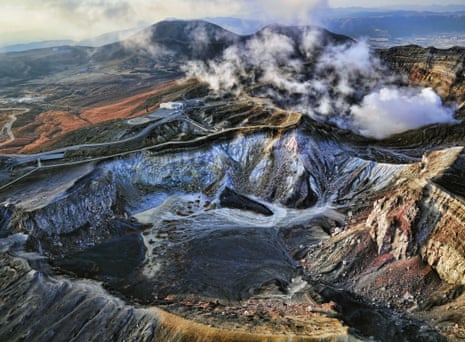
Top 10 active volcanoes to see up close
If you’re looking for a trip to light up your holiday, these volcanoes all have well-established roads, cable cars and trails up them – and predictable levels of activity
Have you done a volcano trip? Tell us about it in the comments below
Mount Aso, Kyushu, Japan
There is some concern that Mount Fuji is showing signs of eruption in the near future, but as things stand, Japan’s most-active volcano is Mount Aso, in Aso Kujū national park on the southern island of Kyushu. It has one of the largest calderas in the world, offering myriad viewpoints over its twisted, pitted landscape. Aso town can be reached by train (one hour from Kumamoto, two from Beppu, fares between £6 and £12). There are two cable car lines, called ropeways , from which to explore the Aso area. Aso Nishi (west) cable car station is a short bus ride from Aso station (£3 each way). Aso Higashi (east) cable car station can be reached by taking a local train to Miyaji station and then walking up the road to the cable car station. A toll road (about £3.50) goes right to the summit of the crater where there is a large car park. There is a lot to explore within the caldera but visitors must remember to check on accessibility before setting off: Aso is a gassy beast and its emissions often see areas of the caldera closed off. More information at japan-guide.com . Live Aso activity updates at aso.ne.jp
Whakaari (White Island), Bay of Plenty, New Zealand
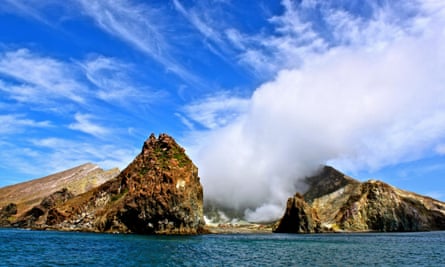
At 321m, Whakaari is not much higher than Leith Hill in Surrey, and is only a couple of kilometres in diameter, but measured from its submarine base it rises to a respectable 1,600m above the sea floor. A convenient gap in the crater walls means visitors can disembark straight into the volcano without having to do any climbing. Whakaari, 49km off the North Island coast, last erupted in 2013 but it is fully suitable for guided tours, thanks to its relatively stable nature and intense monitoring, although its current branding by scientists is “restless”. Visitors can expect to see fumaroles expelling steam and hot gases (masks provided), hot rocks and springs, an acid pool, bubbling mud … and a lot of seabirds. White Island Tours provides a daily launch from Whakatane for a six-hour trip (adults £94, kids under 15 £61). Live Whakaari activity updates at volcanodiscovery.com
Mount Etna, Sicily, Italy
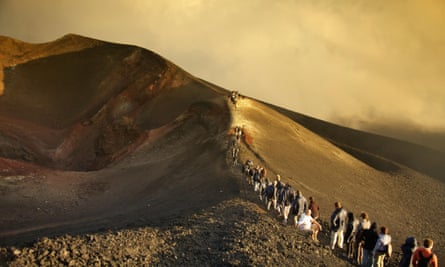
Etna dominates the city of Catania and eastern Sicily. Lacking competing peaks, it draws the eye: imagine two Ben Nevises on top of each other close to the sea. Despite the constant volcanic activity , it is still possible to make it to Etna’s highest-allowable point of 2,920m and back in an afternoon. Visitors will see solidified lava flows from down the centuries reaching right into towns and villages, and craters at all levels of the mountain. It is these side fissures that still pose the biggest risk to Catania – which was destroyed by an eruption in 1669 – and nearby villages. The best route up is on the south side via the Catania suburb of Nicolosi. From here, drive, cycle or take the twice daily AST bus (which starts in Catania) up to the Rifugio Sapienza (at 1,923m), where tickets can be bought for the combined cable car and 4x4 bus trip, Funivia dell’Etna (€60pp) , to the highest-possible level. The ticket price also includes a guided tour around a large, smoking crater next to an observatory. A more sedate way of exploring the volcano’s environs is by train. The scenic Circumetnea Railway travels around the base of Etna from Catania Borgo to Riposto and costs about €8pp, taking three hours. Live Etna activity updates at volcanodiscovery.com
Mount Vesuvius, Naples, Italy
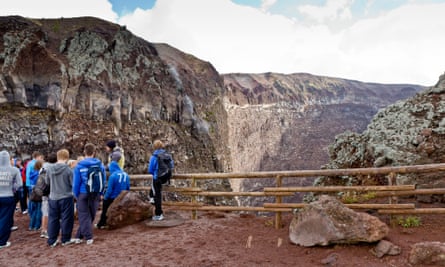
Possibly the world’s most famous volcano – though it hasn’t erupted since 1944 – and the most touristy, too. So much so that serene contemplation of nature’s ferocity might not be possible given the crowds who ascend each day. At 1,281m it would only be the fifth highest mountain in the UK but its squat form lurks sinisterly over Naples. From the car park at 1,000m visitors climb the remaining 200m (about 30 minutes, tickets €10). The most popular path goes to the edge of the main crater where guides are on hand. Steam can be seen rising from parts of the crater and, as with nearly all volcanoes, there is a strong smell of sulphur. There are no public toilets or a visitors’ centre (although there is the historic museum observatory halfway up the road from Ercolano) but the views are spectacular and the sense of history profound. The nearest railway station is Ercolano Scavi, from which minibuses and taxis take you up the mountain car park in about 25 minutes. Vesuvio Express bus costs about €20 including admission to the trails and crater. From Pompeii there are timetabled buses to Vesuvius
Mount Stromboli, Sicily, Italy
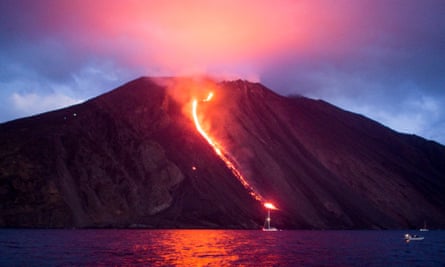
This is a 924m volcano with near-constant explosive activity. Although it’s a modest size, it is a tough climb to the summit, but climbing skills are not necessary. Factor in up to six hours: three hours up, one hour to view the crater, and 1½ hours down. Use of a guide is obligatory above a point at 400m called the Sciara del Fuoco. Even from here any belch of magma at the summit should be visible. In any case, mild explosions – appearing at dusk like giant roman candles – happen on Stromboli, sometimes every half hour. Guided trips to the summit crater from the Sciara leave late in the day so the fireworks can be appreciated in full. The attractive trail to the Sciara starts in Piscità, about 2km west of Stromboli’s port. Organised treks to the crater depart daily, timed to reach the summit at sunset and to allow 45 minutes to observe the crater’s fireworks. Magmatrek runs guided trips along the whole trail from Stromboli village (€28 adults, €25 kids under 14). Stromboli is accessible by boat from Milazzo, Palermo, Naples and by excursions from Cefalu and Taormina. Live Stromboli activity updates at volcanodiscovery.com
Kīlauea, Hawaii
Kīlauea is the daddy of accessible active volcanoes and receives nearly three million visitors a year. At 1,247m it’s not even the tallest volcano on Hawaii (it’s dwarfed by the 4,169m Mauna Loa) but it has been belching out huge quantities of deep crimson, slow-moving lava almost continuously since 1983. Fortunately for visitors, catastrophic explosions are not Kīlauea’s style – beautiful lava fountains are. There is no public transport within the area, a national park , so the choice for exploring rests between car hire and private excursions. The Kīlauea Visitor Center and Jaggar museum offer extraordinary views of the lava lake within the Halema’uma’u crater. After dark the scene takes on another complexion, literally, as the glow of magma illuminates the clouds and landscape. Entry to the national park is $10 a vehicle, $5 for individuals on foot or bike, and lasts for seven days. Information on route and viewpoint closures at nps.gov
Arenal, Costa Rica
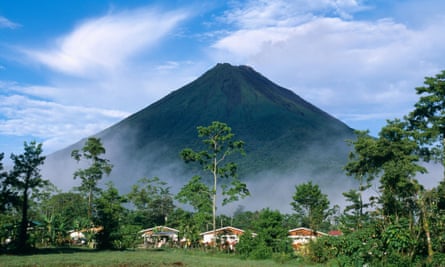
A three-hour drive from the capital, San José, this is an explosive cone admired, like Japan’s Mount Fuji, for its aesthetic qualities. But its beauty can be brutal: in 1968 it erupted unexpectedly, having been dormant for centuries, destroying the small town of Tabacón. Arenal is set with its own national park , within which there are numerous trails from which to explore the area’s fauna and flora. Trails cross lava fields from previous eruptions and take visitors through bird, butterfly and snake-filled rainforest. There are several operators offering guided tours in the area. Anywhere Costa Rica has a one-day tour taking in hot springs, waterfalls and the scars of the 1968 eruption. Food and drink, park entrance fee and transport are included for £124 adults, kids £95. The best accommodation for viewing the volcano is the Observatory Lodge and Spa (doubles from US$79 B&B), a couple of miles from the mountain. From here, daily guided walks set out. arenal.net
Mount Batur, Bali, Indonesia
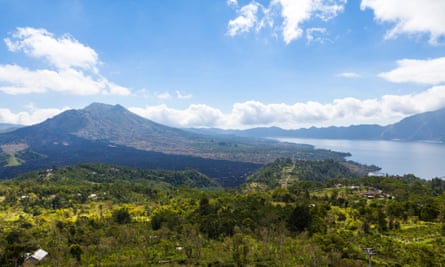
An active 1,717m volcano that’s a moderate 2½-hour climb near the town of Kintamani and one hour and 20 minutes’ drive north from popular Ubud . The mountain has “mild-to-moderate explosive activity” and lava flows, although during 2015 it has entered a quiet period. The best route up the hill is from the village of Toya Bungkah because from here much of the climb is through shady forest. The village is also, handily, HQ to the Association of Mount Batur Trekking Guides (open 3am-1pm). The entire area is volcanic and the higher Mount Agung dominates the south-eastern horizon. The view of forest, volcanoes and lakes is superb but often clouds build up during the afternoon, obscuring the view. For this reason – and to catch the sunrise from behind Agung volcano, the guided trips set off at about 3am. Although the climb is relatively easy, trips are best undertaken with a guide (about £20 from Toya Bungkah). Some travellers have reported over-aggressive touts offering trips up the mountain, but whatever the logistical irritations, the views over Lake Batur and the various live craters should make it worthwhile. Bali Trekking Tours offers excursions to Batur from several locations in Bali from US$65pp including transport, guides and breakfast. Live Batur activity updates at volcanodiscovery.com
Nisyros, Dodecanese, Greece
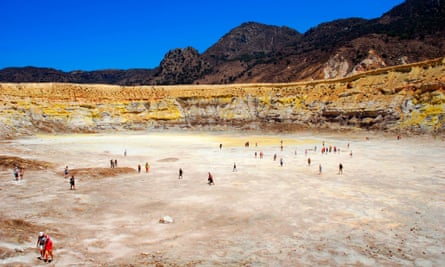
This is the least well-known, and least-active, volcano in our top 10. It is on Nisyros island in the Dodecanese between Kos and Tilos. It may not make headlines for its pyrotechnics (it last erupted in 1888), but magma is rising beneath the island, seismic activity has been increasing and the temperature of vent emissions is on the up. Only 8km in diameter, the island is dotted with villages. It has a 3km-wide caldera with active fumaroles, hot gases bubbling up through mud, and hot springs . The island is reached by ferry from Kos, Piraeus, Tilos and Leros. Boats (ferries and charters) from Kos leave from Kardamena (shorter transit time of one hour, from €24) and Kos Town (from €9). There is a frequent, short, €2 bus journey to the crater from the port of Mandraki. nisyros.co.uk
Piton de la Fournaise, Réunion, Indian Ocean
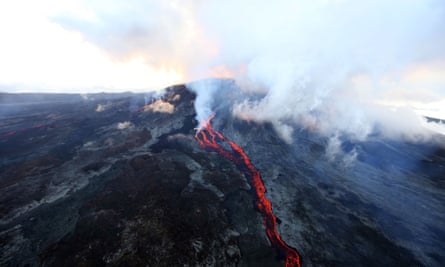
An incredibly active 2,632m French volcano – who knew? The reason you might not have known is that it’s on Réunion, a French department in the Indian Ocean. But it’s worth including because, as with Kīlauea, it regularly gives amazing lava and light shows and there are roads and paths linking the various active and dormant craters. Access to the very active caldera is intermittent, for obvious reasons, but there is a good forestry road connecting the Highway of the Plains to the Pas de Bellecombe where there is a car park, a gîte and snack bar, plus views across part of one of the calderas. There is no public transport to the main volcanic area. From Pas de Bellecombe well-signed paths lead to craters through superb subtropical scenery. Live information on which paths are open is available at fournaise.info . Guided trips to points within the Piton zone start from €50 (kids €35). Rainbow Tours offers a nine-day walking holiday in Réunion from £1,980 including flights
- Adventure travel

Cook your way round Italy's Aeolian islands

Baroque and roll: a cycling tour of south-east Sicily

The sights, shouts and smells of Syracuse’s Ortigia market, Sicily

Frittola – a gutsy breakfast on the streets of Palermo

10 of the best holiday houses and B&Bs in Sicily and its islands

Sicily's baroque masterpiece makes for the perfect (warm) winter break

Vintage Sicily: a wine tour of the island

Giorgio Locatelli's Sicily

Gomorrah director Matteo Garrone on how Italy inspired his new film

Come on kids, we're going to Sicily – on the train
Comments (…), most viewed.
10 active volcanoes to see in your lifetime

The world is circled by active volcanoes that offer spectacular glimpses of the raw majesty of the earth -- from a safe distance, of course. Here are 10 of the most awe-inspiring volcanoes on the planet.
Please note that any active volcano presents extreme dangers even when dormant and that visitors should not attempt to climb them without thoroughly researching and preparing beforehand. (A dormant volcano is still considered active even if it's not technically erupting at the moment. It's not extinct.)
1. Eyjafjallajökull, Iceland
When Eyjafjallajökull erupted in 2010, almost all of Europe suffered the consequences -- notably a far-reaching cloud of ash that led to thousands of travelers being stranded in Europe for six days. The glacier-topped mountain stands over 5,400 feet tall and is part of an area that's considered particularly active and unpredictable. It's a popular destination for helicopter and Jeep tours and experienced hikers can get a grand view from a nearby ridge. And no, you are not alone in wondering how to pronounce it.

2. Mount Vesuvius, Italy
Probably history's most famous volcano, Vesuvius has become permanently etched in people's minds as the natural disaster that buried the Roman city of Pompeii in ash and killed thousands, including the philosopher and statesman Pliny the Elder. Today it's often referred to as the most dangerous volcano in the world not only because of its notably explosive eruptions but because of the three million or so people who live in and around Naples , including 600,000 who live in the so-called "red zone" immediately around Vesuvius itself. It's been dormant since 1944 but some experts fear that's merely because the 4,200-foot giant is building up to a truly devastating eruption. Nevertheless, you can hike to the summit and peer into the crater, from which steam still visibly rises.
Read more: How pilots deal with volcanic ash encounters

3. Mount Etna, Italy
This 11,000-foot volcano on the eastern coast of Sicily erupted as recently as March 2017 and is known for occasionally emitting rare volcanic smoke rings. Its power has fueled legends since ancient times, and it was once believed to house the forge of the god Hephaestus and serve as a prison for titanic monsters. Today, though, it's home to ski resorts and a thriving tourist industry and is a popular site for hikes and bus and 4x4 tours.

4. Mount Merapi, Indonesia
Merapi is Indonesia's most active volcano. Often covered in its own smoke, Mount Merapi killed hundreds and displaced hundreds of thousands when it erupted in 2010. Fearing a repeat of that disaster, the government has prohibited settlement around the base and a small army of experts continues to monitor it carefully. It's also central to age-old Javanese myths and the 9,600-foot cone is supposed to be the palace of the kings and queens of the spirit kingdom. Though the summit is officially closed to tourists, hikers still make the ascent.

5. Mount Nyiragongo, Democratic Republic of the Congo
One of Africa's most active volcanoes and standing over 11,000 feet, Nyiragongo is known for having one of the largest lava lakes in the world. It last erupted in 2002, when it killed 147, but is still actively monitored by scientists as an ongoing potential threat to the surrounding area. The volcano lies within Virunga National Park and is accessible, with a paid tourist permit, to visitors who often camp out at night on the summit to bask in the glow of the lava in the crater.
Read more : How to take better photos when traveling

6. Pacaya, Guatemala
At nearly 8,400 feet, Pacaya towers over Pacaya National Park and is just 19 miles from Guatemala City . It's been nearly continuously active for centuries and is known for showering the city of Antigua in ash and spilling out rivers of lava. It's been erupting since 2013 and is easily visible throughout the park.

7. Arenal Volcano, Costa Rica
Arguably the best reason to leave Costa Rica's beaches for its interior, Arenal rises nearly 5,400 feet over the region's emerald rainforests. It completely destroyed the nearby town of Tabacon when it erupted in 1968, killing 78, but has been considered dormant since 2010. Tabacon has since reinvented itself as a spa town, making use of the volcanically heated spring waters, and the entire area around the volcano has become a popular tourist destination, attracting visitors who come for the diverse wildlife, excellent bird watching, outdoor activities and, of course, Arenal itself. Locals will tell you the best view of Arenal is from the top of neighboring Mount Chato, a somewhat strenuous climb that leads to a hidden crater lake where the daring can swim under the shadow of the volcano.

8. Kīlauea, Hawaii
The most well-known of the Big Island's volcanoes is so active that it has a name that actually means "spewing" in Hawaiian . It rises to just under 4,100 feet and is a shield volcano rather than a classic conical or dome-shaped volcano, thanks to its lava, which is more fluid and easily flowing than usual. Kilauea and its four nearby siblings are considered to be the earthly form of the creator goddess Pele and have been popular with visitors to the islands, who now get close-up views by foot, boat or helicopter, for almost 200 years.

9. Mount Yasur, Vanuatu
Lying on Tanna Island in this South Pacific nation, and measuring a relatively dwarfish 1,200 feet, Mount Yasur has been continuously active at least since Captain James Cook spotted it in 1774, spitting out ash or lava several times an hour and earning the nickname "Lighthouse of the Pacific". It's been especially active since 2013, and visitors are warned to be very careful these days. Still, climbing and flying tours are available and the volcano is a top tourist destination in Vanuatu.

10. Villarrica, Chile
At 9,380-foot, Villarrica is especially scenic because it rises majestically above the eponymous lake, but residents and tourists were treated to an even more dazzling and frightening spectacle when the volcano erupted in 2015, throwing up a brilliant column of lava that was visible for miles. The Mapuche people call it by another name, Rucapillan, or House of Pillan, referring to its benevolent spirits that live in the earth. Though there's a ski resort on its northern slope and tourists continue to hike and fly over it, one group of climbers was scared off by a sudden lava spurt at the crater in early 2017.

Bottom line
Visiting volcanoes can be thrilling -- but also dangerous. So before planning a volcanic adventure it's very important to keep on top of each country or region's government website for advice and regulations. Hire a guide, don't go off the beaten track too much and you will enjoy some truly spectacular sights!
National Geographic content straight to your inbox—sign up for our popular newsletters here

Volcano tourism is booming, but is it too risky?
Dazzling eruptions draw visitors to places like Iceland and Hawaii. Here’s how to see them safely.
In late March 2021, thousands of people in Iceland hiked into the Geldingadalur valley to watch fiery lava splutter and spill from the crater of the Fagradalsfjall volcano after it erupted for the first time in nearly 800 years. As white ash clouds puffed above trails of glowing, molten rock inching through craggy black stones, some visitors took photos, others sat in quiet awe, and a few toasted marshmallows over the lava flows.
Photographer Chris Burkard, who captured the eruption for National Geographic, was transfixed by the ominous-but-beautiful landscape, too. “It was mesmerizing,” he says. “I never thought something as simple as molten rock would get me this excited.”

The aftermath of eruptions has created famously fertile ground for tourism. Japanese tourists have bunked at onsen ryokans (hot springs inns) in villages near volcanoes since the 8th century. The ruins of the ancient Roman city of Pompeii , preserved by a blanket of ashes when Mt. Vesuvius erupted in A.D. 79, lured countless sightseers on the European Grand Tour in the 17th and 18th centuries.
Traveling to an active volcano isn’t without risks and ethical questions.
can be the thrill of lifetime—or a fatal attraction. Before you get fired up to see one, here’s what you should know.

The rise of ‘lava chasers’
The day after the Island of Hawaii’ s Mount Kilauea erupted on December 20, 2020, Hawaii Volcanoes National Park saw a sharp spike in visitors. Many of the 8,000 guests were locals, but the park has also seen a steady increase of out-of-state visitors as COVID-19 travel restrictions ease.
Depending on the place, travelers can take lava boat tours, hop helicopter trips over calderas, surf down the slopes of a volcano, or even walk to the edge of the lava lake. But these endeavors come with risk. Eruptions often produce poisonous gasses (e.g., sulfur dioxide, present at Fagradalsfjall
that can damage your lungs. Between 2010 and 2020, at least 1,143 people have been killed in volcanic explosions, most recently near
, which suddenly erupted December 9, 2019, killing 22 tourists and injuring 25 others.
Yet, these casualties seem to have fueled curiosity rather than deterred tourism. Instead of steering clear of erupting volcanoes, sensation seekers are drawn to disaster areas—a trend expected to continue after the pandemic.
Targeting eruptions
Volcanic eruptions happen when there’s an increase in magma-static pressure or a shift in tectonic plates, which can also spur earthquakes . Sometimes, erosion or melting glaciers slowly move the earth and eventually spur eruptions; other times sudden landslides trigger them. Volcanic activities are monitored by scientific observatories around the world, so blow ups are rarely a surprise. (For a bit of armchair volcanology, use the Smithsonian Institution’s online active eruption tracker .)
“If you know some of the basics, you can observe eruptions fairly safely,” says Rosaly M.C. Lopes, a volcanologist and planetary geologist at the Jet Propulsion Laboratory in Pasadena, California. “We’re lucky that the most beautiful eruptions—in Hawaii, Iceland, and Stromboli, Italy —are also not the most explosive ones.”
Author of the Volcano Adventure Guide , Lopes says it’s important to know the type of volcanoes you’re visiting. The volatility of a given site depends on its lava: thin and runny lava flows out of the volcano slowly, while thick and viscous lava makes it difficult for gas to escape, resulting in more explosive (and possibly, deadly) eruptions. Knowing which sort you are dealing with could potentially save your life.

When Italy’s Mount Etna erupted in 1987, two tourists were killed. Lopes was only a mile away on a research trip when it happened. “If it’s a volcano like Etna, and there is a sudden explosion, look up and see where these rock fragments are going to land,” she says. “But you don’t run; you dodge them. And after fragments land, you run.”
On the opposite spectrum, during the sudden eruption of New Zealand ’s Whakaari/White Island volcano, Lopes says those who survived were likely the ones who sprinted the fastest. “Some people stayed to take photos. I think some just got caught and couldn’t run fast enough,” she says. “But that is a dangerous volcano, and volcanologists knew it could have a sudden explosion.”
Life in the shadow of a volcano
There are more than 1,500 active volcanoes in 81 countries. For the hundreds of millions of people who reside near them, they’re just a part of daily life, like bad traffic or frequent rain.
The relationship between Sakurajima and the locals is reciprocal. Fertile soil near the volcano helps Kagoshima grow its famed daikon radishes and tiny komikan oranges.
“Without Sakurajima there would be no Kagoshima. It’s the symbol of our city, and the people here view it as a protective god,” says Naoto Maesako, owner of Kagoshima City’s Yogan Yaki restaurant, where vegetables, kurobuta pork, and wagyu beef are cooked on hot plates made from local lava. “We feel that Sakurajima sees us through typhoons and other disasters safely. It’s our history right in front of us, and we can see the same smoldering scene as our ancestors did.”
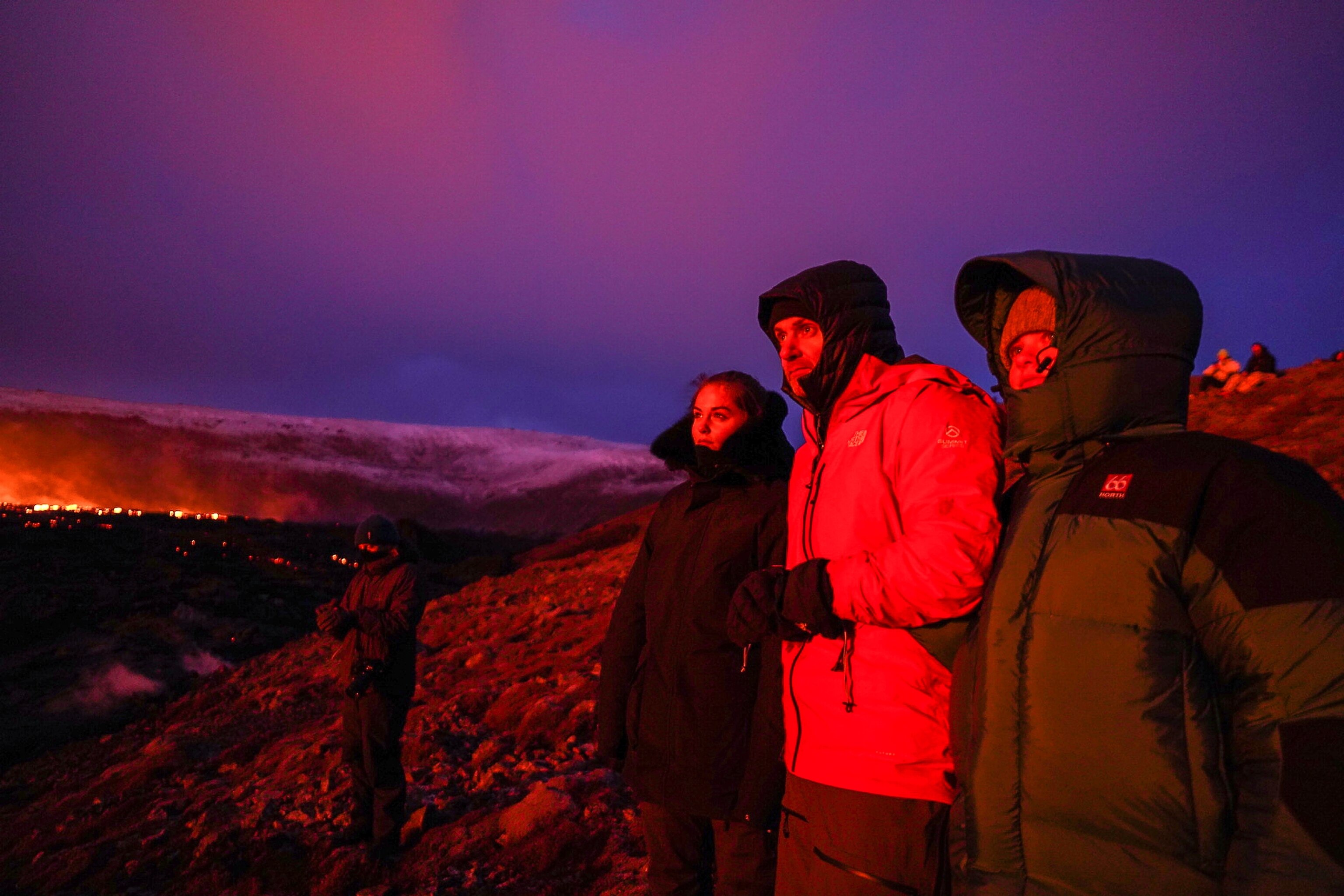
In Hawaii, the connection between volcanoes and residents is a part of the islands’ origin story. Ancient Hawaiian chants refer to Pele, goddess of volcanoes and fire, as “she who shapes the sacred land.” “The Hawaiian people have been here and have flourished for more than 1,000 years,” says Hayes. “It’s impossible not to be connected deeply with generations of cherished stories, ancestors, and family connection to the ’aina — the land.”
Taking a dark turn
In 2018, Mount Kīlauea’s continued eruptions destroyed approximately 600 homes, as well as roads, farms, and ranches, on the Island of Hawaii. That May, while fires still raged in neighborhoods, tourist spending increased by 3.3. percent to $173.9 million. Hospitality companies had to balance meeting traveler’s needs with sensitivity towards affected residents.
Ross Birch, executive director of the Island of Hawaii Visitors Bureau, encourages tourists who are curious about volcanoes to stick to the national park. “It’s a great place to learn about the volcanoes,” Birch says. “Anything outside of that, you might cross into private property and potentially end up in someone’s backyard.”

As Mount Kīlauea continues to erupt, the Island of Hawaii’s Mauna Loa—the world’s largest active volcano—is slowly waking up. Hawaiian Volcano Observatory (HVO) seismometers recorded approximately 223 small-magnitude earthquakes in a span of one week in March of 2021. “ The GPS sensors tell us that the ground is changing shape due to the ingress of magma into the storage edifice below the surface ,” says HVO geologist Frank Trusdell. “An eruption is not imminent, but residents should start planning.”
Trusdell recalls that within 24 hours of the last Mauna Loa eruption in 1984, plane tickets to the Island of Hawaii were sold out. “Everybody wanted to come to see the eruption,” he says.
Scientists like Trusdell understand why people are drawn to volcanoes, and they believe this helps raise aware and interest in volcanology. “Every time you go somewhere that you see a geological process—even if it’s fairly tame volcanos like Yellowstone geysers—it awakens your curiosity,” says Lopes. “It gives you a much greater respect for our planet.”
Rachel Ng is an award-winning Los Angeles-based travel and culture writer who dreamed of being a volcanologist as a kid. Follow her on Instagram . Chris Burkard is a photographer and explorer based in California. Follow his work on Instagram .
Related Topics
- ADVENTURE TRAVEL
- NATURAL DISASTERS AND HAZARDS
You May Also Like

What you need to know about volcano tourism in Iceland

Dramatic photos show La Palma volcano’s ongoing eruption
Free bonus issue.

Startling volcanic activity has town in Iceland bracing for crisis

Canary Islands volcano roars to life for first time in 50 years

Meet the artisans of Bicol, the Filipino peninsula forged by fire

How Scottish adventurer Aldo Kane is pushing the boundaries of exploration

The ultimate Andes road trip, from Chile to Bolivia
- History & Culture
- Environment
- Paid Content
History & Culture
- History Magazine
- Mind, Body, Wonder
- Terms of Use
- Privacy Policy
- Your US State Privacy Rights
- Children's Online Privacy Policy
- Interest-Based Ads
- About Nielsen Measurement
- Do Not Sell or Share My Personal Information
- Nat Geo Home
- Attend a Live Event
- Book a Trip
- Inspire Your Kids
- Shop Nat Geo
- Visit the D.C. Museum
- Learn About Our Impact
- Support Our Mission
- Advertise With Us
- Customer Service
- Renew Subscription
- Manage Your Subscription
- Work at Nat Geo
- Sign Up for Our Newsletters
- Contribute to Protect the Planet
Copyright © 1996-2015 National Geographic Society Copyright © 2015-2024 National Geographic Partners, LLC. All rights reserved
- Skip to global NPS navigation
- Skip to this park navigation
- Skip to the main content
- Skip to this park information section
- Skip to the footer section

Exiting nps.gov
Alerts in effect, plan your visit.
Last updated: January 24, 2024
Park footer
Contact info, mailing address:.
P.O. Box 52 Hawaii National Park, HI 96718
808 985-6011
Stay Connected

The Ultimate One Day in Volcanoes National Park Itinerary
Disclaimer: This article contains affiliate links. That means if you click a link and make a purchase, we may make a small commission. As an Amazon Associate we earn from qualifying purchases. For more information, see our privacy policy.

Planning a Hawaii Volcanoes National Park itinerary is one of the top things to do when mapping out a trip to Hawaii. No visit to the Big Island of Hawaii is complete without one day in Volcanoes National Park.
The park spans about 523 square miles and is home to two of the world’s most active volcanoes. Kilauea is one of the most active volcanoes in the world while Mauna Loa is the world’s largest shield volcano. During your visit to Volcanoes National Park, you’ll explore the lush and diverse ecosystems created by volcanoes.
In this article, we’ll detail everything you need to know about getting to and around the park as well as the perfect Volcanoes National Park itinerary. Let’s jump in.
Table of Contents
How Many Days in Volcanoes National Park?
You’re most likely visiting Hawaii Volcanoes National Park as part of a larger Big Island itinerary . However, you might still be wondering how much time do you need at Volcanoes National Park? Most visitors would recommend one to two days.
In one day, you can drive the main roads inside the park and catch its major highlights. If you stay the night nearby, you can also opt for a tour after dark for stargazing and seeing bright orange lava flow.
With a little extra time, you can check out more of the park’s trails or head out toward the coastline to find unique rock formations from volcanic eruptions long ago.
The itinerary below is ideal if you have one day in Hawaii Volcanoes National Park. We’ve also included some suggestions for places to check out if you have a little more time to spare.

Getting To & Around Volcanoes National Park
It’s best to visit Volcanoes National Park as a day trip from Hilo or a smaller town just outside the park. The drive from Hilo to the park entrance takes about 45 minutes though you can also stop here on the way from Kona to Hilo.
If you’re staying in Kona, a day trip into the park is a long day, with nearly two hours of driving on either end. However, if you want to make a day of visiting the Southernmost Point in the United States or the black sand beaches on the southern tip of the Big Island, this route works well.
There is one entrance to Hawaii Volcanoes National Park and three main roads to get around, which makes navigating the park easy. A 7-day pass for one vehicle is $30, unless you already have an America the Beautiful Pass for $80 per year.
While there are tours such as this small group tour and this private tour from both Kona and Hilo , it’s ideal to have your own vehicle. Odds are you’ll rent a car for at least a portion of your Big Island visit, so try to time your tour of Volcanoes National Park accordingly. You can browse Rentalcars.com to compare car hire prices.
There is lodging available in the park, but it tends to be more expensive than staying outside it – Hilo makes an excellent base. However, if you’re doing a night tour , spending one night inside the park might be desirable.

1 Day in Volcanoes National Park Itinerary
A Volcanoes National Park day trip is full of highlights to fill your camera roll. Make sure to take your time exploring the park — it’s truly loaded with natural wonders that you’ll see in few other places.
Stop at the Volcanoes National Park Visitors Center
Because of where you enter the park, you’ll most likely stop at the Kilauea Visitors Center. It’s right next to the entrance and it’s highly recommended you stop in upon arrival.
The Visitor Center has educational displays covering the geological history of the land. Between interactive exhibits, short movies, and artefacts, it’s a great way to welcome yourself to the national park.
Here, you can also check in with park rangers to see which parts of the park are open or closed. Due to its being an active volcano, you might encounter periodic closures or reroutes due to volcanic activity.

See the steam vents and sulphur banks
You’ll stop at the sulphur banks first. They are a short hike from the Visitor Center. It’s a loop trail — one mile out and back route from the Visitor Center parking lot.
Make sure you stay on the trail, especially as it changes to an elevated boardwalk, because volcanic gases and liquids rise from the surface. As you begin to smell rotten eggs, you’ll know you’re quickly approaching the sulphur banks.
The steam vents are located a few-minute car ride away from the Visitor Center. Head down the Crater Rim Road to stop near Steaming Bluff. You’ll quickly spot the large holes in the ground where steam spills out. There is a metal railing that surrounds the vents. Like the sulphur banks, it smells terrible here.
Check out Kilauea from the overlook
Once you’re back to the car, drive west along the Crater Rim Drive until you reach the Kilauea Overlook. The volcano started erupting again as recently as 2021. It’s easy to spot steam rolling up from the crater.
Here is one of the places where you can see the “night glow” of lava after dark. This is one of the most impressive sights you’ll see in the park. If you want a closer look, consider bringing a pair of binoculars.
Note that most of the Crater Rim Drive isn’t open to visitors at this time (July 2023), so you’ll have to turn back from the overlook to head toward your next destinations for your one day in Volcanoes National Park.
Visit the lava tree molds
Lava tree molds form when lava from an eruption gathers around the trunks of trees, destroying the tree and leaving behind a hardened mold of the plant.
Over time, these columns of solidified lava have become staples of the landscape, and offer visitors a glimpse into the landscape that existed before the volcano’s major eruptions.
The most impressive tree molds are near Highway 11 on the Mauna Loa Road.

Hike Devastation Trail
If you’re to do one or two shorter hikes in Volcanoes National Park, make sure one is the Devastation Trail. This short and paved trail crosses the lava field created from the 1959 Kilauea eruption. You’ll see first-hand how natural spaces start to recover after such cataclysmic events.
Keep an eye out for unique lava features like spatter effects and small glass-like lava called Pele’s hairs and tears.
You’ll park at the Devastation Trail trailhead located near the turn-off for the Chain of Craters Road. The trail itself is easy. It’s wheelchair and stroller accessible as it’s an entirely paved trail. It’s a short one-mile round-trip hike, but make sure you bring proper walking clothes and shoes.
A hat to protect yourself from the sun and sunscreen is also highly recommended. There is little-to-no shade along the route and it can be hot, dry, and windy depending on the time of day you visit. Doing the hike in the morning, when it’s cooler temperatures and fewer hikers, could be a good option.
Walk through the Thurston Lava Tube
The Thurston Lava Tube is hands-down one of the highlights of a Volcanoes National Park itinerary. This underground lava tube was formed when magma pushed its way from the volcano, carving a perfectly round and smooth tunnel. You can enter the tube from either side and walk all the way through.
Follow a short trail to arrive at the entrance. It’s wise to wear sturdy shoes during your visit as the ground within the tunnel can be uneven in places. You should also consider bringing a flashlight. The tunnel is lit by artificial lights from 8am to 8 pm, but there are still dark patches.
Keep in mind that visiting midday tends to be the busiest for the Thurston Lava Tube. We recommend you try to time your visit first thing in the morning or mid-afternoon, depending on the direction you plan to explore the park.

Stop at the Keanakakoi Overlook
If you’re on a mission to spot active lava during your visit, you won’t want to miss Keanakakoi Overlook. The crater was most likely formed during an eruption of Kilauea during the 1400s. Due to eruptions in 2018, part of the road to reach the overlook was destroyed.
An old portion of the Crater Rim Drive is open for foot traffic or bicyclists. Park at the trailhead parking lot for Devastation Trail and walk one mile along the road to reach the overlook.
Do an evening tour
If you’ve done any reading about visiting Volcanoes National Park, you’ve probably heard about “night glow”. This phenomenon can only be experienced once the sun has gone down.
Head to Kilauea Overlook, or you can reserve a tour , to catch a glimpse of the lava glowing within the Halema’uma’u Crater. It’s a stark contrast to how the crater appeared during the day time. Light from the lava of this active volcano illuminated with vog (volcanic smog) and clouds above the crater.
Stick around a little longer for stargazing. You’ll have to venture away from the glow of Kilauea. The Mauna Loa Lookout or Hilina Pali Overlook are two excellent options for where to see the stars.
Without light obstruction from nearby towns, you’ll witness a night sky filled with twinkling little stars. Make sure to wear good shoes and pack a few extra layers. A flashlight or headlamp could also be helpful to have on hand.
Have More Time?
Should you have some more time on your Hawaii Volcanoes National Park day trip, or you’re spending more than one day exploring the park, head out on the Chain of Craters Road.
The turn-off from the Crater Rim Road is just before the Thurston Lava Tube. This road takes you out to the coastline for spectacular views. It takes about 30 minutes to drive one way, so make sure you budget 1-2 hours for driving and stopping to see the sites.
Your first stop, or last stop on the way back, is the Pu’u Loa Petroglyphs. Here is where native Hawaiians carved figures and scenes into the hardened lava somewhere between 1200 and 1450 CE. Expect a 1.4-mile out-and-back hike to see the petroglyphs.
Hop back in your car and continue driving until you reach the coastline. Here you’ll arrive at the Holei Sea Arch. This stunning nature site is a 90-foot sea arch on the edge of the Pacific Ocean. It’s solidified lava eroded by years of ocean waves to create the arch seen today. From here, you also get spectacular views of the rugged coastline.
If you’re feeling adventurous, climb Mauna Loa. This strenuous climb is a challenging hike, but well worth it for the views you get from the top. During the climb, you traverse over rough and jagged lava rock. Sturdy and reliable shoes are a must as you’re often walking on loose lava.
The summit is at a high altitude, so make sure you’re adequately prepared for the gain. Backcountry backpacking is also an option for those looking to break away from the crowds. Make sure you pack plenty of water and know the signs of altitude sickness.
Please note that the Mauna Loa trail is currently closed above Red Hill Cabin due to ongoing volcanic activity. No matter what time of year you visit Volcanoes National Park, make sure to read up about the park’s current activity. Depending on the severity of any active eruptions, your entire park itinerary could change.
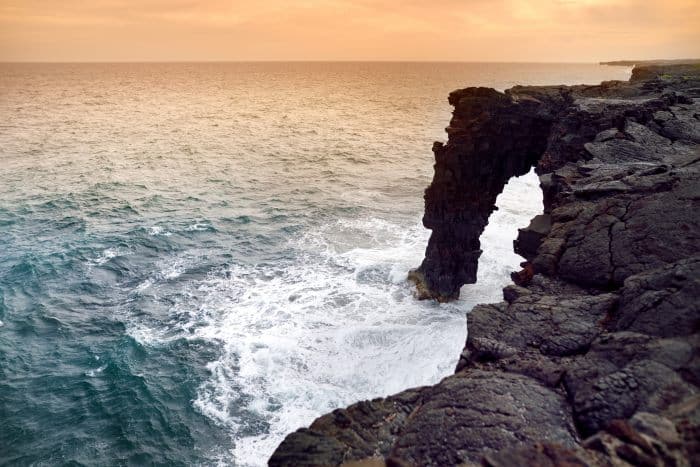
Where to Stay in Hilo
Hilo Bay Oceanfront Bed and Breakfast – Located in the center of Hilo, this cute bed and breakfast is an excellent choice for those looking for a base to explore the national park. They have a number of rooms on offer and there’s also breakfast available in the mornings. Click here to check availability
The Inn at Kulaniapia Falls – If you’re looking for a good jumping-off point for visiting Volcanoes National Park, then this tranquil inn is an excellent choice. They have both lovely cabins and beautiful rooms on offer and there is also breakfast each morning. Click here to check availability
Private Rental – If you’d like to find a self-catering option in Hilo or close to Volcanoes National Park, there are plenty to choose from — like this beach studio — in this area of the island. Click here to browse Hilo private rentals
Big Island Hostel – Those visiting Volcanoes National Park on a tight budget will love this backpacker’s hostel in Hilo. They offer a number of differently-sized dorms to choose from along with a great location and good common areas. Click here to check availability
Not quite what you’re looking for? Click here to browse more Hilo hotels!

Hawaii Volcanoes National Park is truly like no other. This diverse and rich landscape captures several hundreds of years of history. During your visit, you’ll get a first-hand look at two of the world’s most active volcanoes and the landscape they’ve created. Use this itinerary as inspiration to plan the perfect Volcanoes National Park visit.
Are you planning to visit Hawaii Volcanoes National Park? Have any questions about this itinerary? Let us know in the comments!

Related Posts:

13 Best Stops on the Kona to Hilo Drive

The Perfect 5 to 7-Day Big Island Itinerary

Maui vs Big Island: Which Hawaiian Island to Visit?

About Audrey Webster
Audrey Webster is a writer for The World Was Here First. She is an Oregon native who has visited countries across the globe and currently spends her weekends exploring the Pacific Northwest and surrounding states. Her approach to traveling combines exploring famous tourist sites and wandering off the beaten path to discover new destinations.
Leave a Comment Cancel reply

The Ultimate Guide to Hawaii Volcanoes National Park on the Big Island
Heading to the big island and hope to see real lava on your hawaiian vacation scroll to find out everything you you need to know in this guide to hawaii volcanoes national park, the only unesco world heritage site in hawaii., this guide to hawaii volcanoes national park was written by hawaii travel expert marcie cheung and contains affiliate links which means if you purchase something from one of my affiliate links, i may earn a small commission that goes back into maintaining this blog..
Believe it or not, the island of Hawaii, also known as the Big Island is a new island and is constantly growing. The growth is all due to the hot spot that has continuously spewed lava into the ocean.
It’s also one of the few places in the world where regular people can hike to the active lava spots and get amazing photographs of the lava flowing into the ocean.
But the lava isn’t the only thing you can do here at Big Island Volcano Park. There are tons of things to do in Volcanoes National Park if you have the time.
So How much time do you need at Volcano National Park? There is no easy answer to this question. It all depends on how much time you have.
There are several activities you can do that allow you to get a brief glimpse of what the park has. Or, you can spend days exploring every inch of the Hawaii National Volcano Park.
So, whether you are doing a day trip to Hawaii Volcanoes National Park or are planning on spending several days there, this Volcanoes National Park guide has you covered!
First trip to the Big Island ? Read THIS first!
Don’t have time to read many Hawaii blog posts and reviews? Here are some of our top picks for visiting the Big Island.
Popular Big Island Tours/Activities
- Manta Ray Snorkeling Tour (you can ONLY do this on the Big Island)
- Hawaii Volcanoes National Park Tour (this is the BEST way to see lava if you aren’t renting a car)
- Mauna Kea Stargazing Tour (this is a cool adventure for teens and adults)
- Swim with Dolphins (this is a unique experience for kids of all ages and adults)
- Kona ATV Tour (we love this one because they also do cultural activities)
- Book a Photo Shoot (this is a Hawaii souvenir you’ll treasure forever)
Favorite Big Island Resorts/Hotels
- Hilton Waikoloa Village (this is a mega resort where you can swim with dolphins or just enjoy their massive pool area)
- Courtyard by Marriott’s King Kamehameha Beach Hotel (this is a moderately-priced Kona hotel right on a little lagoon)
- Fairmont Orchid (this is a swanky resort with an awesome pool area and beach)
Want to Rent a Car in Hawaii? One of the best places to rent a car in Hawaii is Discount Hawaii Car Rental because they get the best rates from top national companies like Alamo, Dollar, Thrifty, Avis, Enterprise, Budget, and Payless.
Want to skip all the planning and just access my detailed Big Island Itinerary, complete with daily schedules, kid-friendly activities, and travel hacks? Click the button below.
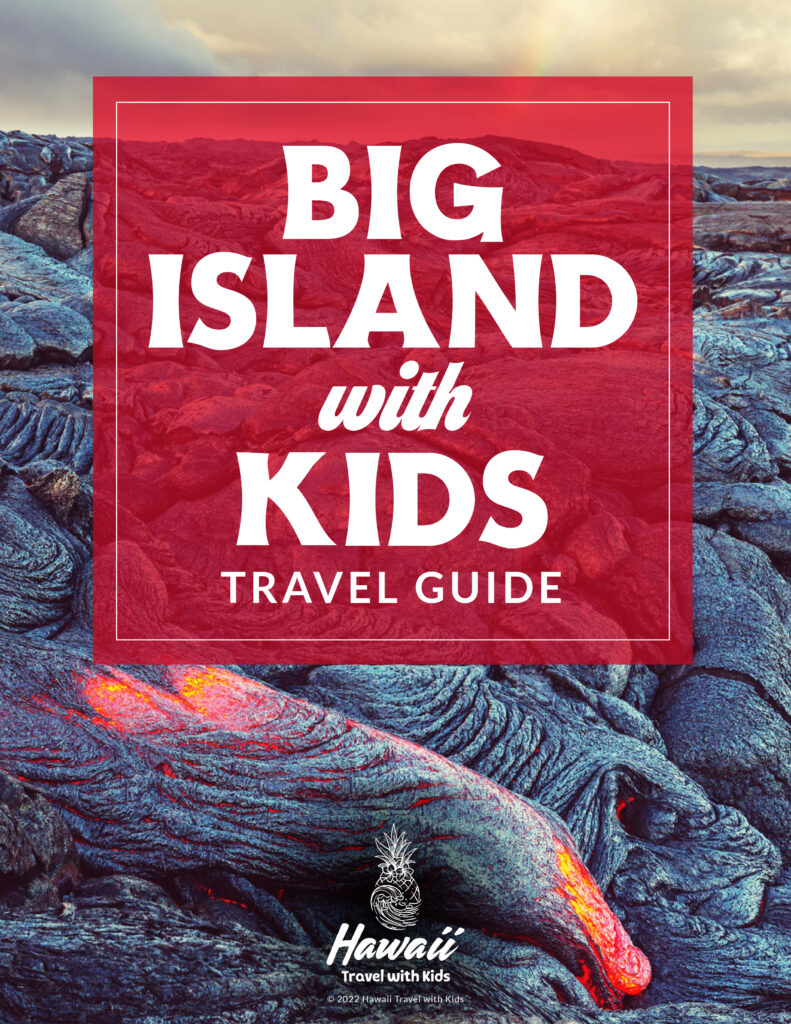
The Ultimate Guide to Hawaii Volcanoes National Park
Here is your Volcano National Park guide to learn all there is to see and do here along with how to get to Volcano National Park.
Where is Volcano National Park located?
Before you can start planning on what to see and do at the park, you need to know where to go. The Hawaii Volcanoes National Park is located on the south side of the Big Island between Hilo and Kona .
Starting in Kona — Fastest Way
If you are starting out on the Kona side of the island, or the “dry” side, you will have to take Highway 11. Start by going southeast, you’ll cut through Kealakekua, Captain Cook, South Point, Na’alehu, and Pahala.
Don’t just drive through these areas, there are tons of things to see. You can stop and enjoy the black sand beach that is located on the Ka’u Coast. Look for signs for Punalu’u.
Have a picnic and enjoy the basking turtles for a bit before heading back on the road.
Then you can simply continue driving around Highway 11 until you reach the Hawaii Volcanoes National Park.
In total, the drive from Kona to Volcano National Park is about 2 and a half hours and is 96 miles if you are going to the park from the Kona side of the island. This is of course taking the shortest route.
Starting in Kona — Alternative Route
Another option is to start from Kona and go through to Waikoloa. From Waikoloa, you’ll head up to Waimea. You can take the ‘shortcut’ through the dormant volcanoes of Mauna Loa and Mauna Kea on “Saddle Road.”
Saddle Road isn’t as bad as it once was. It used to have blind turns and very windy roads with limited visibility.
But over the years, the state has made improvements to the road, and it’s an easy smooth drive to get to the Hilo side of the island.
If you take this route, you’ll be amazed by old Lehua forests and see just how massive Mauna Loa and Mauna Kea are.
This route will take about 2 and a half hours to get to the Hawaii Volcanoes National Park. It doesn’t have a view of the coast, but the view is still pretty awesome cutting through the sleeping volcanoes.
Starting in Kona — Alternative Route 2
Or, you can go from Waikoloa to Waimea and continue around through Laupāhoehoe, and see the stunning coastline with this route.
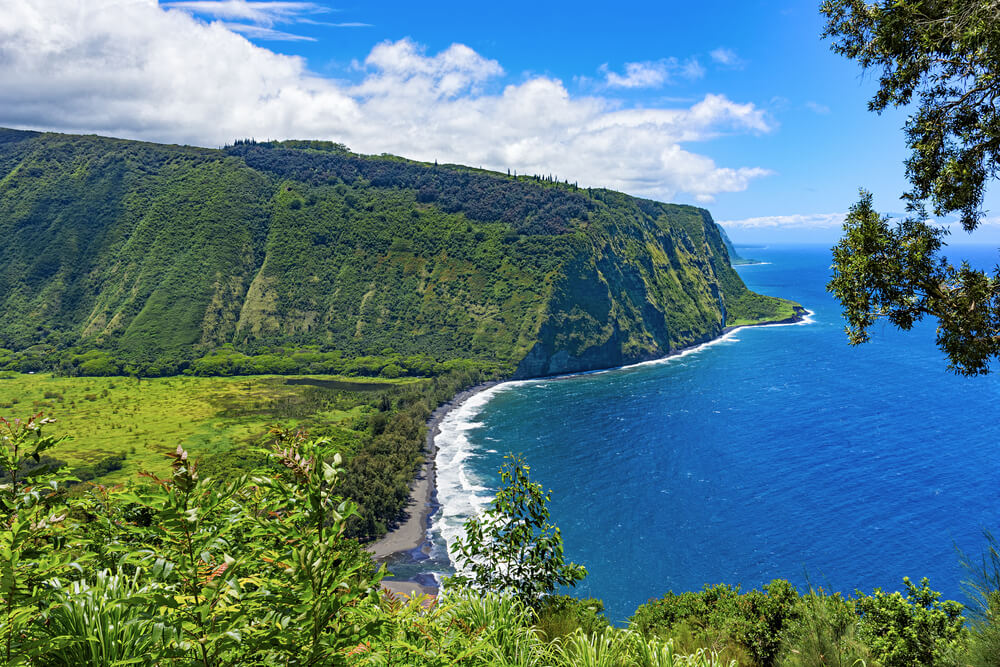
If you take this route, don’t forget to take a detour to Waipio Valley lookout in Honoka’a. There you will see an amazing view of a black sand beach and glorious valleys.
It was here that Water World was filmed for the land scenes.
Word of caution though, don’t try to go down to the beach. Just enjoy the lookout.
The hike down is easy and you may think you have the time to go down and back up. But the climb back up is what will take the most time.
The road is super steep and it switches back again and again. It takes ten minutes to climb down, but at least 35 to get back up. It is not an easy climb to the top. However, you can do the Waipio Valley Shuttle tour , which is awesome!
But, if you want to hike, then jump back in your car and cruise to Laupāhoehoe where you’ll find the Akaka Falls .
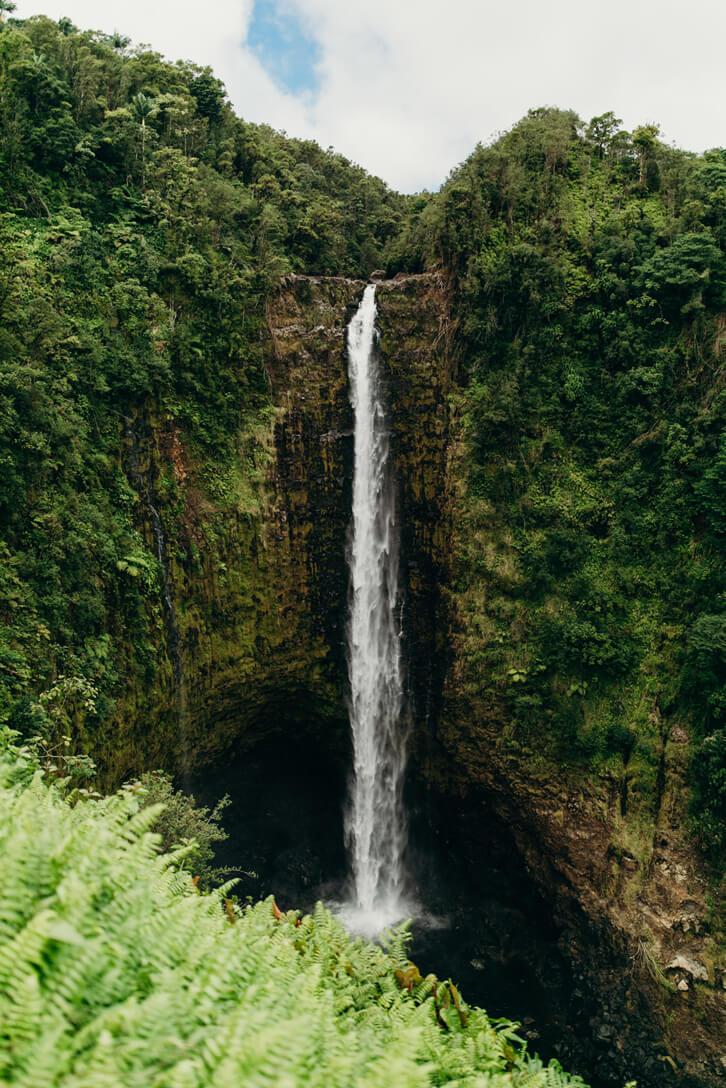
Here you’ll hike through the rainforest and find a spectacular waterfall. The path to the waterfall is easy and maintained. It takes about 20 minutes for a round-trip hike to see the falls.
Cutting through Hilo or Starting in Hilo
Once your legs are stretched, continue on Highway 19 and connect with Highway 11. You’ll be cutting through Hilo on this route and get to see the Banyan trees on the main strip, and also Hilo bay.
This route will take you around 2.5 to 4 hours depending on if you stop to hike, or if you stop at each point before getting to the Volcano National Park.
However, if you are staying in Hilo , you’ll find the park is a mere 30 miles southwest. Simply drive for 45 minutes through Hilo and you’ll come across the park.
Cost of Admission to the Hawaii Volcanoes National Park
Unfortunately, there is a cost to get into the park, but at least it isn’t too bad. Since 1987, the park has charged per vehicle. For cars, there is a $30 entrance fee. For motorcycles, it is $25.
But, there are so many things to see and do here with the Hawaiian volcanoes, that the price is well worth it.
Best Things to Do at Big Island Volcano National Park
When you first drive through the entrance of the Hawaii Volcano National Park, you may find yourself on a foreign planet. At least, that will be what it seems like.
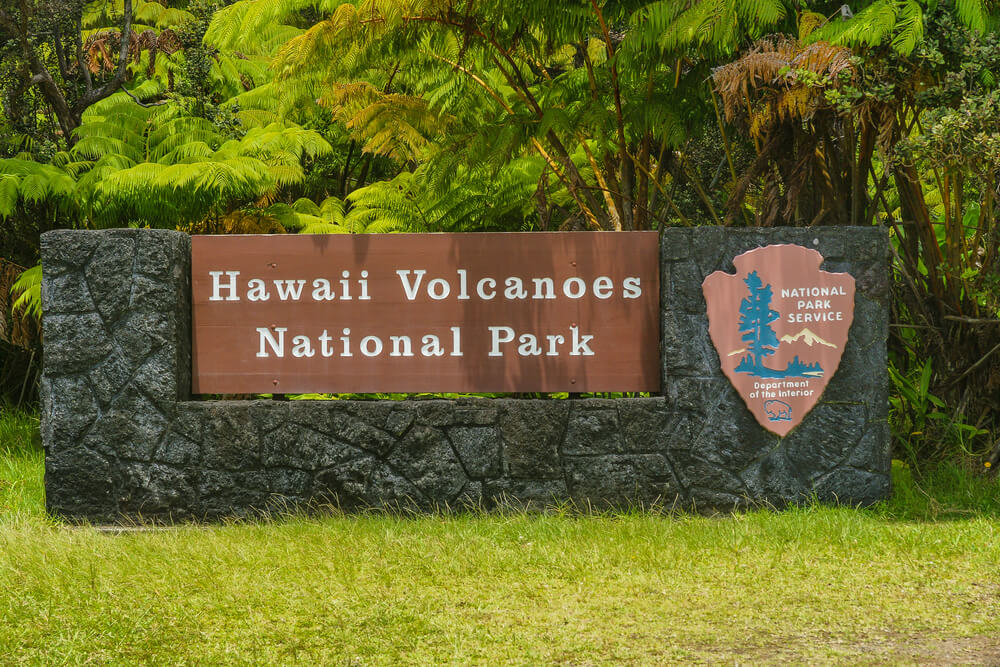
The vast dark ragged and rugged landscape makes it look like you are someplace other than Earth. And you may wonder what all you can do here at the park.
Well, there are tons of things for you to see and do at this UNESCO World Heritage Site.
You’ll first want to get an idea of what is around you. Stopping at the kīlauea visitor center should be your first priority.
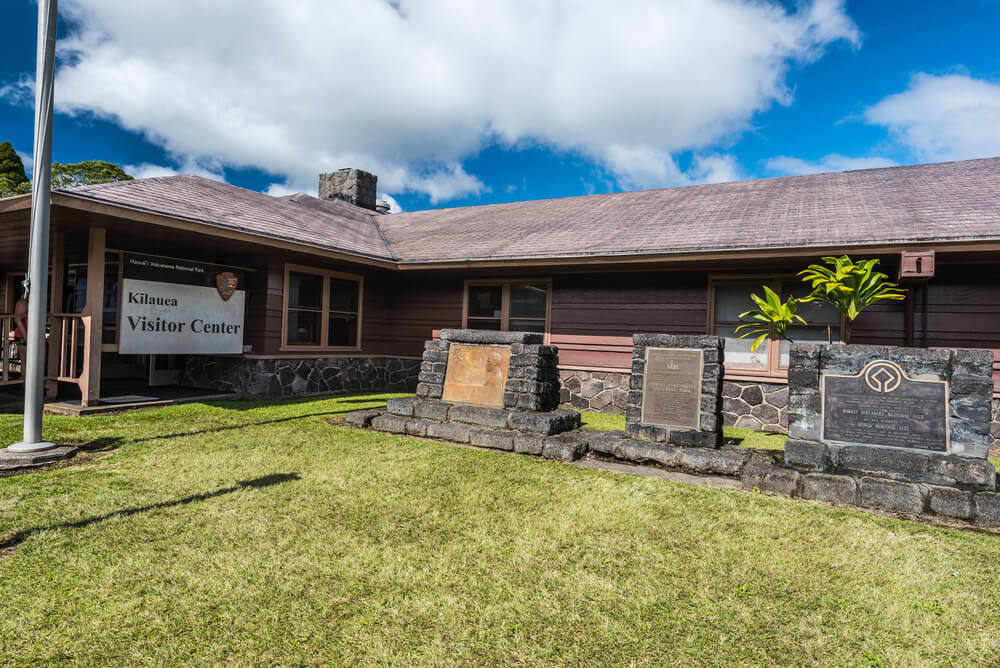
It is here that you’ll learn about the different types of lava flows. You will also get to see the different advancements scientists are making to explore and better understand lava and the earth’s core. They have all the Hawaii Volcano National Park facts.
Once you roam around the museum and snag a map of the park, you might want to jump right into actually seeing lava flow out into the ocean. The thing is though you are still a ways away from the shore.
In fact, it will take about 45 minutes to travel down the road to get to the place where you can park and then another 30-minute hike to the coastline over frozen lava fields.
So, you might want to wait and do this last for 2 reasons.
First, there is a lot to see and do between the visitor center and the shoreline. Just making a beeline to the flowing lava will have you missing out on some amazing sites.
Second, viewing the lava lake at dusk is far more stunning than watching it during daylight hours. Normally the glowing light is visible during the day. To get that remarkable and unforgettable view, wait till dusk.
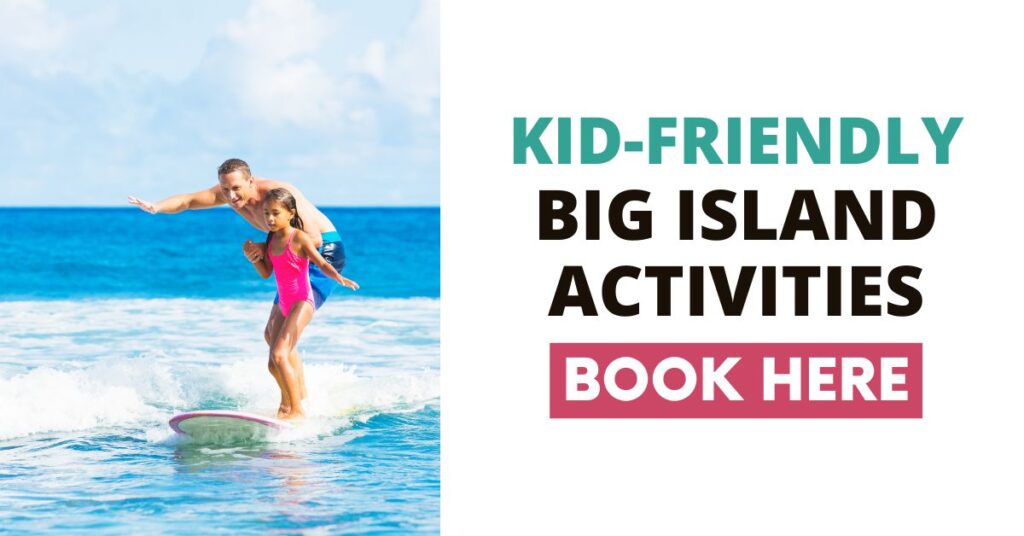
Thurston Lava Tube
The Thurston Lava Tube is one of the more popular sights to see at Hawaii Volcanoes National Park.
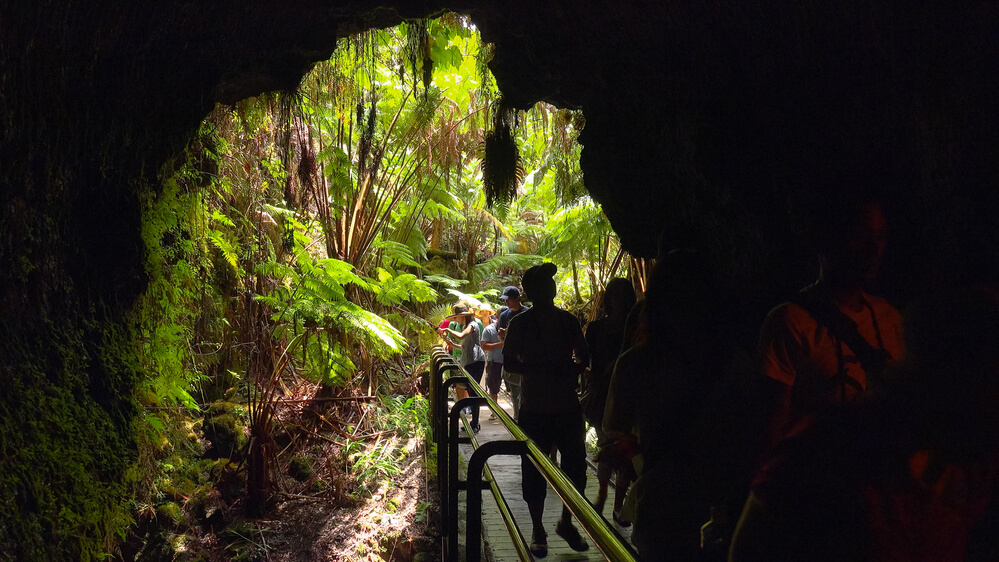
It is a spot where lava passed through clean leaving an open area for you to walk through. It’s basically a cave that anyone can walk through. The ground is flat, and it goes on a short distance and is a must-see.
Crater Rim Road
The Crater Rim is the fastest and easiest way to see a lot in a short amount of time. Of course, short is relative seeing as there are so many spots to stop and take in the view, have a picnic, or just relax and enjoy nature.
But if you are on a time limit, then doing the Crater Rim Drive or the Crater Rim Trail will give you the most photo opportunities for your time.
First, you’ll start out at the visitor’s center and drive around to the Steam vents. There you will also be able to take in the Steaming Bluff and Ha’akulamanu.
Just be wary of the stench around the Ha’akulamanu sulphur banks trail.
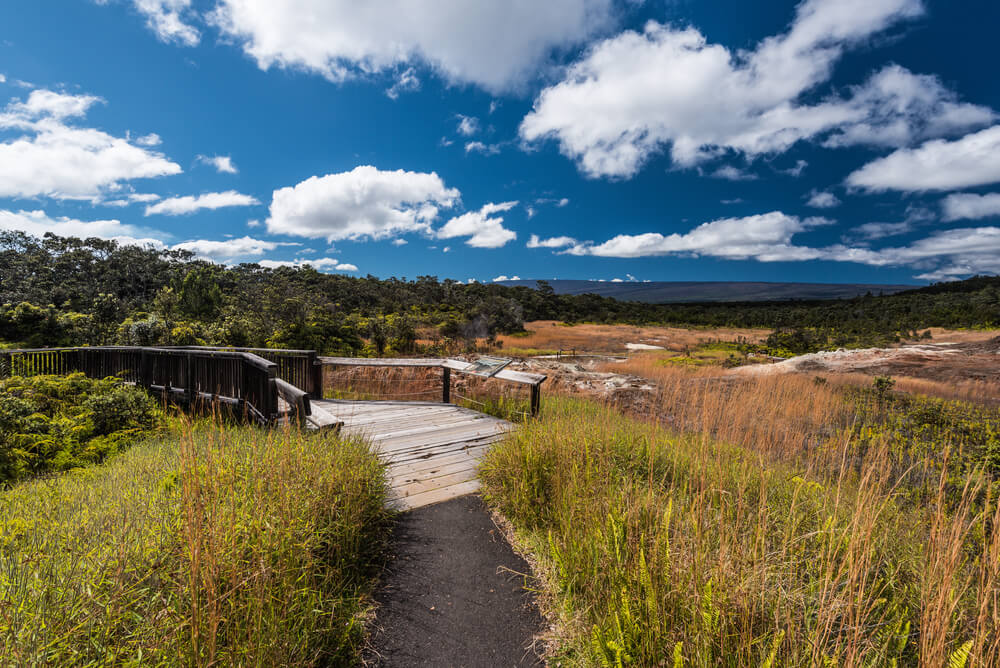
The steam vents and bluff are around the Sulphur Banks area which means that the air quality will be poor and will stink of rotten eggs because that is what sulfur smells like.
Once you get your pictures, continue on the drive and stop off at the Kilauea Iki Overlook. The view here is fantastic and wonderful. There are plenty of places on the side of the road to stop for a picnic or enjoy the scenery.
Then it’s off to the Pu’u Pua’i Overlook where you can see even more awesomeness of how lava can transform and create new land.
Once you have seen the valley area, you can head towards the “Devastation Trail” and stretch your legs on a small hike.
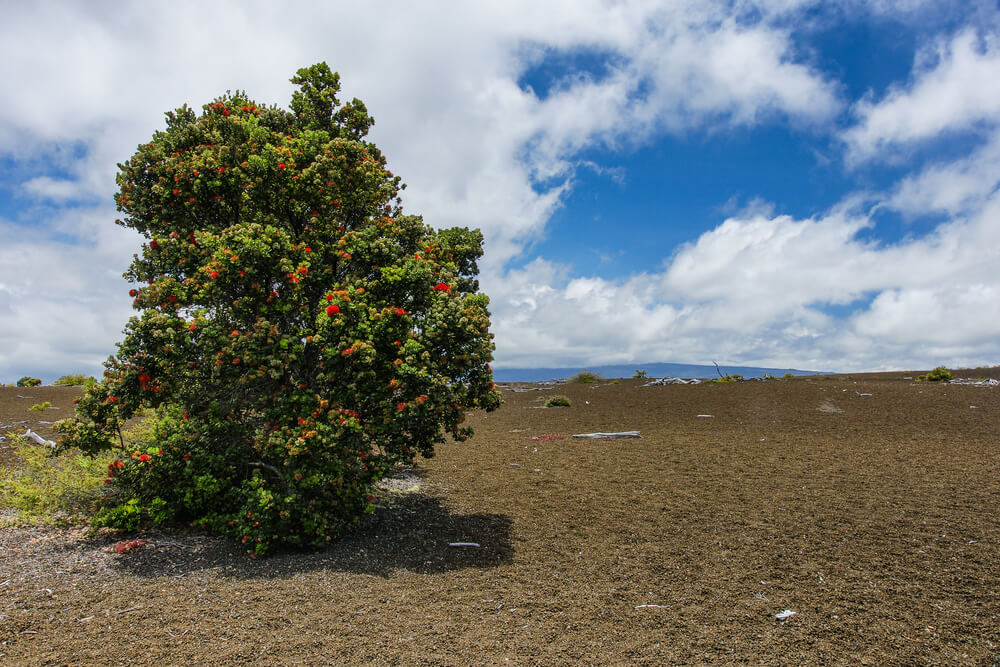
The Devastation Trail makes it seem like you are on the moon or even Mars. There are no trees or anything around and looks just as it sounds. Barren and devoid of life.
Finally, the Crater Rim Drive will take you to Keanakako’i Crater. Once you have got your fill of the Crater Rim, you can start the long drive down the Chain of Craters Road.
Here you will find lots to see, from old lava rivers that are dated along the road to views of the Pacific Ocean.

The Chain of Craters Road will bring you down the slopes of Kilauea towards the ocean. Here you can check out the Holei Sea Arch at the end of the road. It is here that you really understand and see that the Big Island is a new island and growing.
Hiking Trails in National Volcano Park
There are tons of hikes to enjoy while visiting Kilauea volcano. Some are short and others take longer.
The Kilauea Iki Crater hike is about 2 to 3 hours and is quite popular. The Kilauea Iki Crater trail can be challenging, so it’s probably not the one you want to do with kids.
The Crater Rim Trail, sulphur banks, the Kilauea Caldera hike, and Kīpukapuaulu are other fun hikes to see more parts of this large park.
Volcano Art Center Gallery
If you want to explore some of the most gorgeous art of the hot lava and volcanoes, check out the Volcano Art Center gallery while you are at the park.
You can also explore more at Volcano Village as well.
Special Ranger Programs at Hawaii Volcanoes National Park
There are some really cool programs at this Hawaii National Park that are offered throughout the year.
On select Tuesdays, head to the Kilauea Visitor Center for After Dark In The Park for special presentations by leading scientists, artists, and cultural experts on park-related topics.
Join Hawaiian practitioners as they share the arts and culture of Hawaiʻi with demonstrations and hands-on activities during ʻIke Hana Noʻeau (which translates to “Experience the skillful work”.)
Grab tickets for a small, underground laboratory where you’ll experience A Walk Into The Past – A Living History.
This is where a living history presenter dressed in period costume brings back to life Thomas A. Jaggar, founder of Hawaiian Volcano Observatory.
Find out which programs are happening during your trip
Camping at Hawaii Volcanoes National Park
The Hawaii Volcanoes National Park is a lot bigger than what people think. You can spend days here and still not see everything. That is why the park offers people the ability to camp in the park.

Granted, you’ll have to get a pass and talk to the rangers at the visitor center to know what part of the park is closed off to campers and hikers.
But if you have time to kill, camping at Volcano National Park and exploring the park as the Hawaiians once did make it a memorable experience for sure. It is the best way to see Volcano National Park.
As for hiking, there are tons of trails you can go on. Each trail is different and some are harder than others.
There is one trail that takes you over the crater and takes several hours to complete or one that brings you through a rain forest where you can search for the Hawaii State bird, the Nene Goose. It all depends on your level of exercise.
Just be sure to bring plenty of food and water while experiencing the park.
Find out more about Camping in Hawaii
What to Bring to Hawaii Volcanoes National Park
When viewing the lava at Halema’uma’u Crater on the slopes of Kilauea, there are a few things you need to do it safely. Wear sturdy closed-toe shoes . Lava is unforgiving and one slip or stumble and the lava rocks will cut into you very easily.
You should also have with you plenty of water . There are so many people who get lost on the trail coming back to their car and are without water that it is scary. So just make sure you have water with you at all times.
A flashlight is a must if you are going to see the lava at dusk. You’ll lose track of time down there watching the lava spewing into the ocean and you’ll need a light to find the trail to get back to the car. Find the best prices here.
Flashlights are inexpensive and can save your life out there.
Far too many people get turned around in the open lava field and lose track of where they are going without a light.
Many wonder what to wear to Hawaii Volcano National Park and I always say you’ll need a good jacket or wind breaker . The temperature drops at night in the park. It also has a tendency to rain in the evening in Hilo. Check out the latest prices and more details.
Granted, Hawaii temperature doesn’t drop like you would see in the deserts of say Arizona, but it does get chilly. It can even drop down to the high 40s or low 50s. In this case, it can be quite cold and damp. So bring a jacket while visiting the park.
Where to Stay Near Hawaii Volcanoes National Park
If you think you’ll want to spend more than one day exploring this Hawaii National Park, you might consider staying nearby. There is one hotel, many vacation rental homes, and even cool Hawaii treehouses worth a stay.
Volcano House
If you want to stay in a Hawaii Volcanoes National Park hotel, Volcano House is the only hotel located within the park. It first opened in 1846 and sits on the rim of Kilauea’s Halemaumau crater. Read my full review HERE .
People come from all over the world to experience its iconic location, rich cultural legacy, and warm Hawaiian hospitality. If you are planning a Volcanoes National Park vacation, you’ll definitely want to stay at the Volcano House Hotel. Check out the latest prices and more details .
Lava Lodge at Volcano Village
Just one mile from the entrance to Hawaii Volcanoes National Park is Volcano Village, in the old Ohi’a lush rainforest. You can easily walk to popular Volcano restaurants and shops. Check out the latest prices and more details .
Treehouse Cottage at Kilauea Volcano
For a really epic experience, stay at a real treehouse cottage near Kilauea. This VRBO is just a few minutes from the main gates to Hawaii Volcanoes National Park. Check out the latest prices and more details.
UNESCO World Heritage Site
In 1987, Hawaii Volcanoes National Park was named a UNESCO World Heritage Site. That’s because it’s home to Mauna Loa and Kilauea, two of the world’s most active volcanoes that are accessible.
It’s a great place to witness geological processes.
In fact, if you measure Mauna Loa from the ocean floor, it’s the greatest volcanic mass on Earth!
Best Hawaii Volcanoes National Park Tours
For your Hawaii volcanoes trip, you might want a guide and go on a tour to see the active volcano and everything else in the park.
Here are some of the best Hawaii volcano tours to try:
Volcano Unveiled
One of the best volcano tours on the Big Island is run by Hawaii Forest & Trail, which is certified by the Hawaii Ecotourism Association.
Volcano Unveiled is a 12-hour tour that includes a 2-3 mile hike to see Kilauea volcano. You’ll also head to Kauhi Cave, a private lava tube and cavern that’s only available through this tour. Check out the latest prices and more details.
Along the way, your guide will explain more about Hawaii’s geology, culture, and history.
Get your Volcano Unveiled tour tickets
Hawaii Grand Circle Island Volcano Tour
Roberts Hawaii is one of the oldest tour companies in Hawaii and they have been running this Hawaii Grand Circle Island Tour for years.
This 10-hour minibus tour covers approximately 250 miles on the Big Island. You’ll get to see the beautiful Hamakua Coast, Rainbow Falls State Park, ‘Imiloa Astronomy Center, Punalu’u Black Sand Beach, and the Royal Kona Coffee Farm. Check out the latest prices and more details.
But, it also includes a comprehensive tour of Hawaii Volcanoes National Park. You’ll see the Volcano House, the Kilauea Iki Overlook, and Puhimau.
Get your Hawaii Grand Circle Island Tour tickets
Epic Island Journey
Hawaii Forest & Trail’s Epic Island Journey is an 11.5-hour tour where you’ll see some of the most popular Big Island attractions. Check out the latest prices and more details.
Check out Hawaiian Green Sea Turtles at Punalu’u Beach, see a beautiful flower farm, explore a private lava tube, tour Kona Joe’s coffee mill, and see Rainbow Falls from a private viewing deck.
One of the coolest parts of this tour is the guided exploration through Hawaii Volcanoes National Park, where you’ll get amazing views and learn tons about Hawaii’s geology and culture.
Get your Epic Island Journey tour tickets
Hawaii Volcanoes National Park Driving Tour App
If you want your own DIY Hawaii Volcanoes National Park tour, download this driving app .
You’ll get turn-by-turn navigation to must-see locations like Kilauea Iki Trail, Thurston Lava Tube, Devastation Trail, Pu’u Loa Petroglyphs, and Holei Sea Arch.
Get the driving app
Hawaii Volcanoes National Park FAQs
It’s one of the best places to see fresh lava in Hawaii. Plus, this Hawaii National Park has some of the rarest geological and biological landscapes in the world.
Spread across all 8 islands, there are around 15 different volcanoes, but not all are active volcanoes any more.
There are 2 active volcanoes: Mauna Loa and Kilauea. Kilauea is the most active volcano.
You bet! Although, use common sense about not hiking on the sharp lava rock in the dark to avoid injuring yourself. And don’t go anywhere that has a “keep out” sign.
Yes, as long as the volcano is actively erupting. You can always check before your trip if that’s the main reason you’d like to visit this Hawaii National Park. If it is actively erupting, you have a great chance of seeing the lava flow since the park is open 24 hours a day!
While you can visit Volcano National Park Hawaii for a few hours, spending at least a day or two would probably be best. That way you can see and explore all the Volcano National Park things to do.
You will need to pay an entrance fee. The Hawaii Volcanoes National Park entrance fee is $30 per vehicle.
There are tons of Hawai’i Volcanoes National Park animals to see. You might spot some cool birds, insects, and marine life to enjoy during your volcano Hawaii vacation.
The Volcano Park Hawaii is open 24/7, even on holidays! So, no matter when you come to visit, you can always enjoy a nice Volcanoes National Park getaway.
Either early morning or after sunset is the best time to visit Volcano National Park to see the glow of the hot lava. However, it’s always best to check before you head out to see when the volcano will be most active for your Hawaii volcano trip!

Guide to Hawaiʻi Volcanoes National Park Wrap-Up
There are far too many things to see and do at the Hawaii Volcanoes National Park for one post. You can go simply to search for wildlife like boars, goats, donkeys, and all the native birds that live in the forest, including the Hawaiian goose.
Or you can go to bask in the hot springs near the Steam Vents and enjoy a natural sauna experience on this Hawaii island.
But no trip to the park would be complete without a stop at The Volcano House. Here you’ll find a 5-star restaurant that serves amazing food and is the perfect way to end your trip to the Hawaii Volcano National Park .
If you are heading to Hawaii Volcanoes National Park with kids , you might want to run one of these volcano experiments at home . It’s a great way to learn about volcanoes!
Now that you know what to do at Volcano National Park, enjoy and have a blast with your Hawaii volcano vacation.
Looking for more things to do on the Big Island? Check out my Kona Travel Guide and my Hilo Travel Guide , Best Volcano Tours , Cheap Things to do on the Big Island , where to go skiing on the Big Island , and Best Places to Stay on the Big Island .
Ready to plan your trip to the big island.
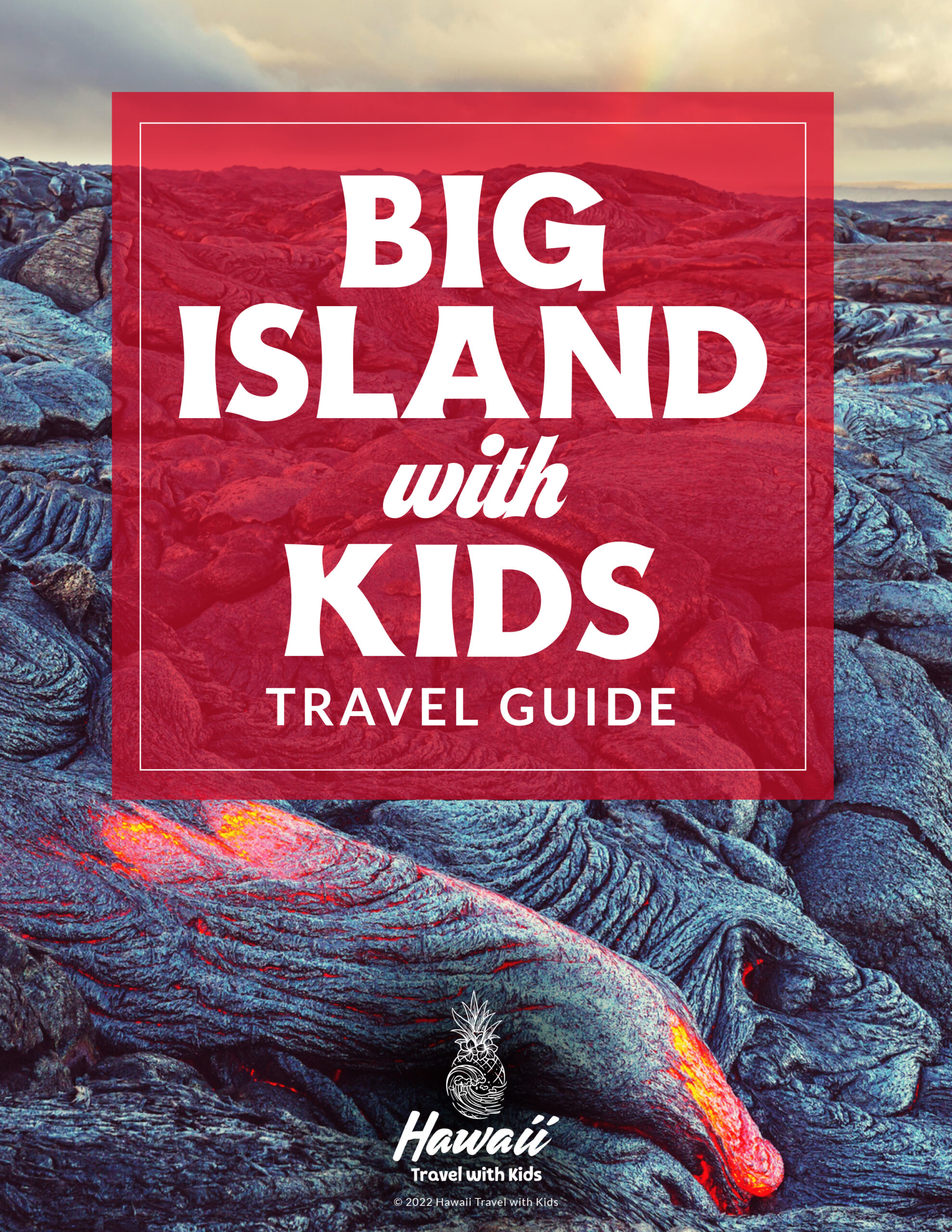
LET ME DO THE WORK FOR YOU!
10 Incredible Volcanoes To Tour Around The World
Volcano tourism is only for those who don't mind the adrenaline, and these volcano tours are nothing short of thrilling.
Even though most volcanoes are active, they are safe to visit but tourists should always be aware of the risk and educate themselves about the volcano they are visiting before doing so. Every year, many people visit volcanoes to see the fantastic scenery and get stunning photos of the eruptions. Some people even enjoy hiking and climbing up them or even flying in a hot air balloon over them. Here are ten that travelers might consider for their next adventurous trip.
10 Mount St Helen, Washington
Four decades ago, this volcano had the most destructive explosion in US history and threw out millions of tons of ash covering the skies of Washington State which traveled nearly 2,000 miles. 57 people were killed in its path and the volcano also created the largest debris recorded in history. Access to Mount St Helens is $8 per person for a Monument Pass and there is also a visitors center where visitors can learn about Mount St Helen and its eruption .
RELATED: Visit These Countries To Try Volcano (& Sand) Surfing!
9 Mount Etna, Catania, Sicily, Italy
Mount Etna is the most active volcano in the world and is also the biggest one in Europe. This volcano is very active and erupts regularly. The mountain even regularly blows out smoke rings too which gives it a very dramatic volcano effect. Visitors can get there in a cable car and then walk the rest to the summit. Visitors also have the option to hike up or even book a guided jeep tour. This is the highest volcano in Europe but every time it blows it gets shorter, so tourists should visit whilst it’s still the highest!
8 Mount Kilimanjaro, Kilimanjaro National Park, Tanzania
Mount Kilimanjaro is the tallest volcano in Africa and is known as the sleeping giant, it has three cones and two are extinct and the other one has been still with no activity since 150,000 years ago. Mount Kilimanjaro is very popular for photography with it being against the African Savannah with giraffes and elephants in sight. For visitors that enjoy climbing this is perfect for them and it takes days to reach the summit a guide will be needed and so will the right equipment and hikers should be aware of altitude sickness.
7 Kelimutu Volcano, Flores Island, Indonesia
This volcano is very different from the others, it does have three cones just like the others but while other volcanoes spit fire, Kelimutu is filled with lakes that change from blues or even a dark red or black depending on what is happening beneath it. This active volcano hasn’t erupted for 50 years but when it does the beautiful lakes in the summit will be gone so tourists are recommended to view them before they disappear. The best time for visitors to go is early morning when they can see the beautiful sunrise.
RELATED: Believe It: These Restaurants Cook Food With Volcanoes
6 Eyjafjallajökull, Suðurland, Iceland
This volcano is very chilled out, so chilled that it’s all frozen over. This is still an active volcano but hasn’t erupted since 2010. The ice cap over it will not melt because the volcano isn’t hot enough. This volcano is standing with a chain of volcanoes that are along the Icelandic landscape. The last time it erupted was very chaotic and left plumes of smoke that were blocking flight paths, leaving thousands of travelers stranded in Europe. Visitors can drive all the way to the summit in a keep that will be driven by a tour guide.
5 Cotopaxi, Ecuador:
Cotopaxi is quite a busy volcano and has erupted over 50 times in the last 300 years. The volcano is located in the ‘Avenue of Volcanoes’ along with a handful of other tall volcanoes along a 200-mile stretch. Cotopaxi is nearly a perfectly symmetrical cone shape. When here visitors can mountain bike, hike, climb, and camp here. Visitors can also find the Enchanted Valley here which has the stone and mudflow from one of Cotopaxi’s mudflows.
4 Stromboli, Italy
Stromboli has small eruptions nearly every hour with the last major eruption being in 1930. Visitors can get very close and are guaranteed to see the fire and lava. There are many options for tourists getting to the island which includes hiking up there, while tourists can hike most of their way up there on their own, they will need a guide to go higher, if this doesn’t happen the visitors will risk being charged a fine. The hike has been known to take more than three hours but is doable for anyone. Hiking the volcano at night is a good idea and something many like to do as the views of the eruptions are beautiful then.
RELATED: El Salvador Is Worth Visiting Just For Its Volcanoes
3 White Island, New Zealand
White Island is one of the most active volcanoes in New Zealand and most of the volcano is underwater, but around 70% of it can be seen. Visitors have to wear a mask when visiting here because of the acidic white steam and gas it produces. When on the volcano, tourists can expect to see mud pits and volcanic streams. Here tourists will also notice the remains of a sulfur factory where 10 miners were killed in 1914. For tourists that don’t want to get too close to the volcano, there is the option to see it by helicopter, plane, or boat.
2 Arenas, Costa Rica
Costa Rica is full of beautiful green landscape and blue waters of Lake Arenal and standing tall above it is the spectacular volcano. Arenal is young and it is believed that the first eruption was 7,000 years ago there have been no eruptions since 1968, and thus might be a safe volcano . The last eruption caused one side of the volcano to explode which killed 78 people and destroyed 2 villages nearby. This volcano can be visited without a guide, visitors will be given a map when they arrive and pay the admission fee, but a tour guide is also an option.
1 Vesuvius, Italy
Vesuvius is an iconic landmark and is known for the destruction caused to the Roman city Pompeii where it killed around 16,000 people and buried the entire city. There are still bodies here that were killed from this event and they look and appear to be frozen. This is now one of Italy’s biggest tourist attractions. To get to the summit tourists can walk for around 30-40 minutes from where the taxis and buses drop them off. The crater is still releasing gases and it is a very thrilling experience for visitors.
NEXT: Volcano Village: Big Island's Tranquil Small Town Retreat
Volcano Holidays
Volcanoes exert a majestic, mesmerising aura. You can’t take your eyes off them. Treated with the respect they deserve, they can become an unforgettable highlight of your holiday with Discover the World. We specialise in several destinations where volcanoes rise, high and mighty, above spectacular landscapes, offering a focal point for our self-drive and escorted holidays, plus a range of exciting excursions.
Speak to a specialist
01737 214 250
Volcanoes in Iceland
Straddling the Mid-Atlantic Ridge, Iceland is a hotspot for volcanic activity. In fact, volcanoes are such a big part of Iceland’s unique appeal that we operate a Volcano Hotline , notifying you of potential trips to visit live eruptions at short notice such as the ‘tourist-friendly’ eruption in July 2023 on the Reykjanes Peninsula. Sign up by visiting the page linked above. As long as the authorities have declared that the eruption site is safe to visit, it is often possible to arrange trips to view the action up-close, sometimes via helicopter flights and Superjeep expeditions depending on the location.
Visit anytime and you’ll discover that Iceland’s volcanic scenery is surprisingly subtle and beautiful. The juxtaposition of ice and fire adds a surreal touch – whether you’re walking on a lava-sand beach littered with icebergs or hiking across a glacier striated with thin bands of ash from past eruptions.
A spectacular eruption occurred on the Reykjanes Peninsula from 18-21 December 2023, following weeks of expectation. This was followed by short-lived eruptions in the same area on 14 January, 8 February and 16 March 2024. This pattern of eruptions may continue over the coming months in this specific area of south west Iceland.
Volcanoes in New Zealand
New Zealand is another of our favourite destinations for volcanoes. We offer a wide range of self-drive and escorted holidays in the country, many of which visit Tongariro National Park.
Dominated by three active volcanoes – Ruapehu, Ngauruhoe and Tongariro – this is New Zealand’s main volcanic area. With just a day to spare, you can hike the 19km Tongariro Alpine Crossing, famed for its crater lakes, ancient lava flows and stunning views.
Another North Island hotspot, Whakaari – or White Island – lies 48km offshore in the Bay of Plenty. New Zealand’s most active volcano, the 2km-wide island is just the tip of a giant submarine cone rising from a depth of 1,600m.
Discover more about volcanoes
Your guide to exploring iceland’s volcanoes.
Iceland is known as the ‘Land of Ice and Fire’, defined by its many glaciers and multitude of volcanoes. Erupting from the ocean over 18 million years ago, the island's terrain has changed little since, scattered with moss-covered lava fields, black sand beaches, and jagged mountainous peaks.
Top 9 Volcanic Experiences in Iceland
This North Atlantic island is a geological hot spot. Read on to take a look at some of the country's impressive geological and volcanic experiences.
Our Customer Charter

- Experienced destination experts
- Dedicated travel specialist throughout
- Flexible and hassle free
- Tailor made holidays to suit you
- First-hand destination experience
- Inspirational and authentic itineraries
- Local award winning guides
- Honest, trustworthy, established
- 24-hr support whilst on holiday
- Full financial protection
- No surcharges
- Travel disruption support
- Flexibility promise
- View Our Guarantee »


- Oahu’s Top Rated
- All Kualoa Tours
- Kualoa Ranch Movie Site Tour
- Circle Island Tours
- Dinner Cruises
- Dolphin Excursions
- All Helicopter Tours
- Shoreline Flight
- Magnum P.I. Experience
- Photography Flight
- Northshore Horseback Riding
- Parasailing
- Pearl Harbor Tours
- Private Charters
- All Rock-A-Hula Packages
- Rockin’ Show
- Rockin’ Show & Luau Buffet
- Rockin’ VIP Package
- Shark Tours
- Snorkeling Tours
- Waikiki Trolley
- Zipline Tours
- Helicopter Tours
- Snorkel Tours
- Whale Watching Maui
- Historical Dinner Cruise to Kealakekua Bay
- Deluxe Snorkel & Dolphin Watch
- Super-Raft Snorkeling Experience
- Super-Raft Sunset Cruise
- Volcano Tours
- Whale Watching

- Planning Your Day Trip to Volcano National Park from Oahu, Hawaii

Taking a day trip to Volcano National Park from Oahu is an adventure of a lifetime.
This journey takes you right into the heart of Hawaii's geological wonders, where active volcanoes breathe life into unique ecosystems and cultural narratives.
A day trip to Volcano National Park from Oahu allows you to witness nature in its rawest form – it's not just about seeing lava flow or trekking across volcanic landscapes.
You also get the chance to immerse yourself in rich Hawaiian culture, learn about fascinating geology, and explore diverse flora and fauna that thrive amidst these fiery mountains.
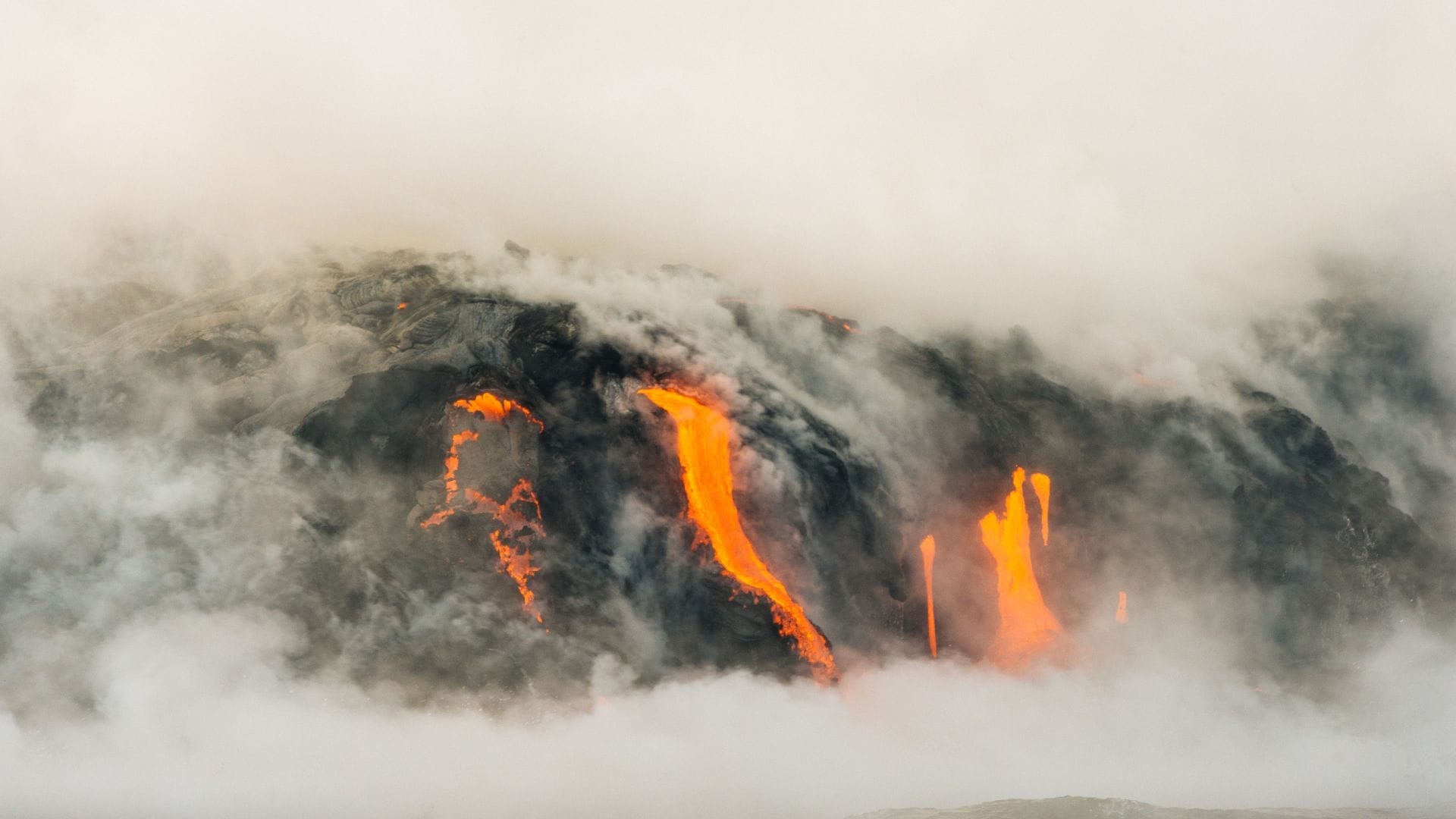
Volcano National Park in Oahu - Overview
Located just 3 hours away from Honolulu, this park offers everything from stunning landscapes to exciting hikes.
With its unique and diverse ecology, as well as numerous recreational activities such as camping and fishing, there's plenty to keep both young and old occupied here.
Get ready for an unforgettable day trip- we'll give you all your need to know about Volcano National Park in Oahu!

Is Volcano National Park in Oahu Worth Visiting?
Yes, it's definitely worth visit, as it's one of the most spectacular places on the island. From breathtaking hikes and ancient volcanoes to lush rainforests and unique geological formations.
This park offers visitors a chance to explore some of Earth's remote beauty and natural wonders.
Whether you're a nature-lover seeking challenging trails or are simply looking for peaceful solitude surrounded by unspoiled foliage, this breathtaking trip will be sure to impress and create lasting memories!
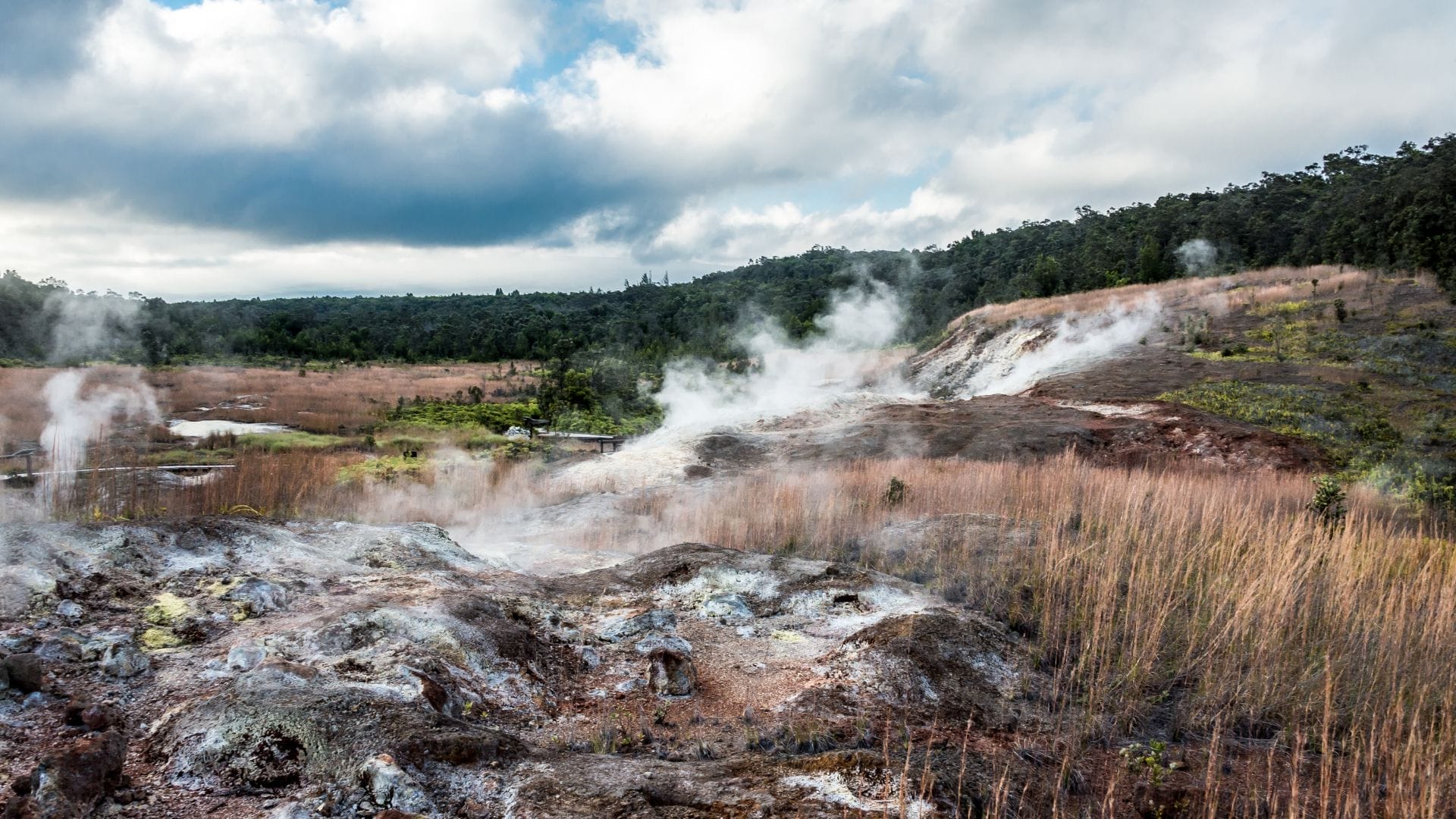
Hawaii Volcanoes National Park Opening Times
Hawai'i Volcanoes National Park is always open. You can visit any time you'd like, day or night, even on holidays.
If you're looking for the Kīlauea Visitor Center, simply head to Crater Rim Drive, and you'll see it on your right.
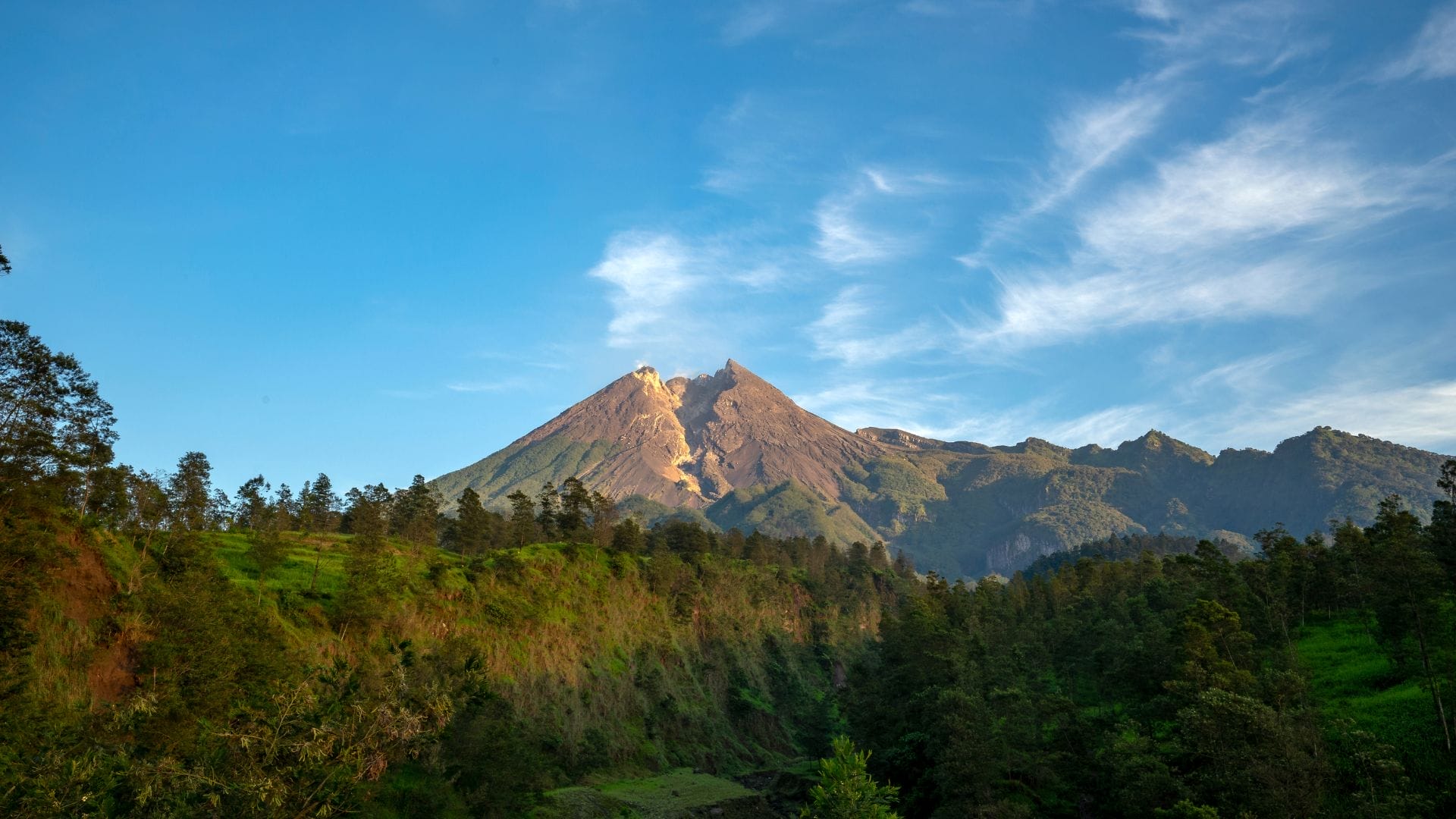
How to Get to Hawaii Volcanoes National Park?
There may not be a direct connection, there is a way to make the journey and it's simple enough.
Hop on the line 20 bus to Airport Upper Level and take a quick walk to the Honolulu airport. From there, fly to Hilo and, once on the Big Island, grab a taxi to the national park.
While it might not be the quickest route, the scenery is sure to make up for the extra travel time.

Best Trails in the National Park
Volcano National Park is the perfect place for your day trip! Filled with lush rainforests, billowing steam vents, dynamic volcanoes and even petroglyphs, this paradise will amaze and delight outdoors lovers.
From active hikes to easy strolls and everything in between, there is something for everyone at this incredible national park—come join us on a journey through some of its best trails!
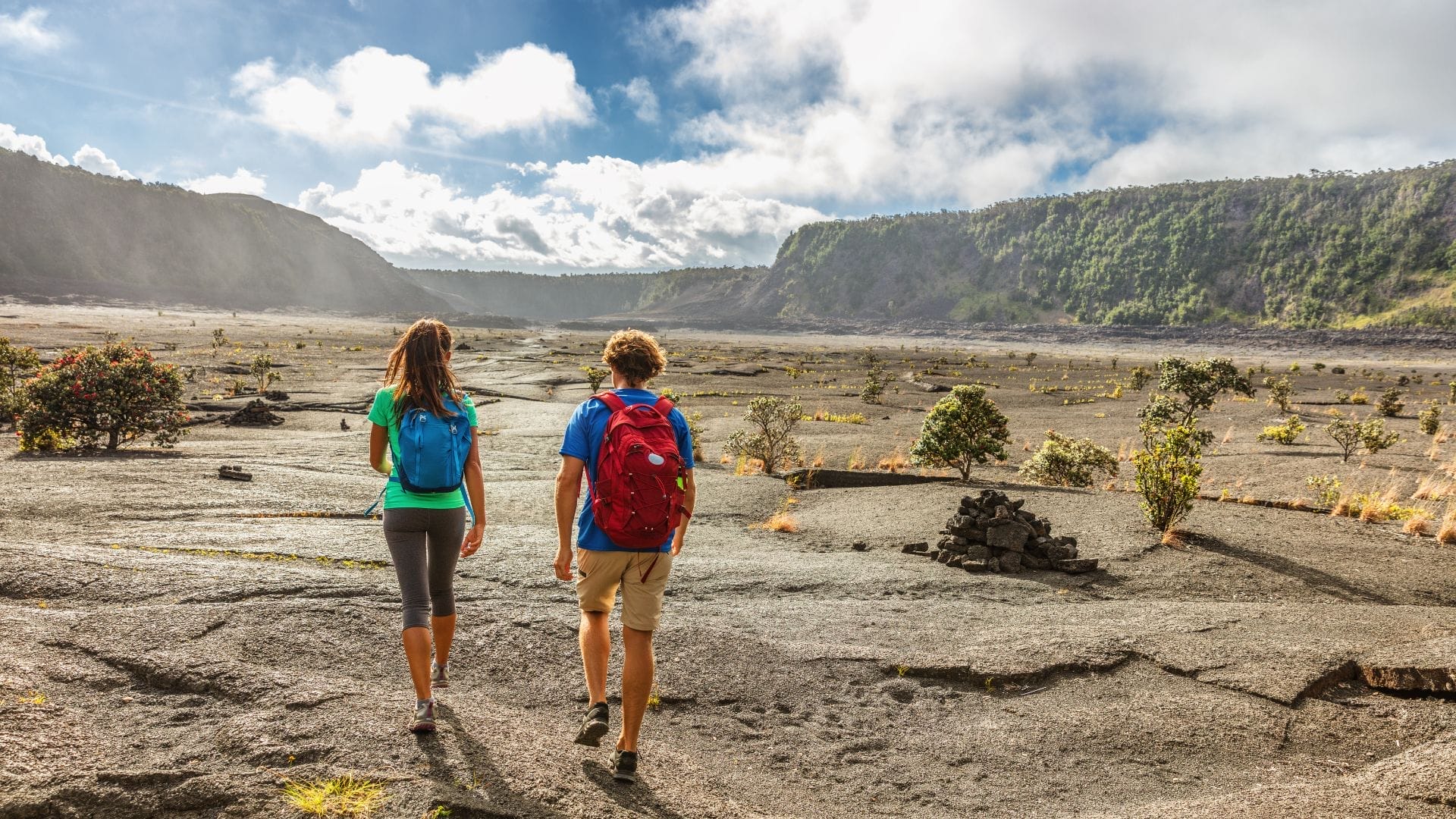
Kilauea Iki Trail and Crater Rim Trail
The Kilauea Iki Trail and Crater Rim Trail are some of the best trails in Oahu and it must be on your bucket list. The Kilauea Iki Trail stretches over four miles, and you can expect to take about two to three hours to complete it.
The trail is not too strenuous, with a few inclines and some uneven terrain, but the views of the volcanic landscape and the steam vents will make it worth the effort.
After completing the Kilauea Iki Trail, you can move on to the Crater Rim Trail. The Crater Rim Trail offers sweeping views of the Kilauea caldera and stretches eight miles around it.
However, you can choose to do a shorter version of the Crater Rim Trail if you'd like.
The Kilauea Iki Trail and Crater Rim Trail are perfect for hikers of all levels who love unique scenery and a bit of adventure.
Key-Takeaway
The Kilauea Iki Trail and Crater Rim Trail offer a unique and adventurous hiking experience for all levels of hikers, with breathtaking views of the volcanic landscape.
Halema’uma’u Steam Bluff and Sulfur Banks
The Halema’uma’u Steam Bluff and Sulfur Banks trail isn't the most challenging hike in the park, it's still a great opportunity to stretch your legs and get some fresh air.
The trail takes about 45 minutes to an hour to complete and covers a distance of only about 1.5 miles, so you can easily fit it into your day.
At the end of the trail, you'll be rewarded with an awe-inspiring view of the Halema’uma’u Steam Bluff and Sulfur Banks, two of the park's most unique and fascinating geological features.
The Halema’uma’u Steam Bluff and Sulfur Banks trail is a fun, easy hike that takes around an hour to complete, offering breathtaking views of two of the park's most unique geological features.


Crater Rim Drive to Keanakākoʻi Overlook
This trek boasts stunning views of the island's volcanic landscape, making it a must-see for any outdoorsy traveler.
While the distance of the trail may vary based on your starting point, the hike is generally around 1.5 miles long and is a moderate difficulty level.
You will be surprised with the beautiful scenery along the way makes the journey completely worth it.
Plan for around an hour to complete the hike, but this can vary depending on your pace and photo-taking breaks.
Strap on your hiking boots and explore the island's volcanic landscape with an hour-long moderate hike to Keanakākoʻi Overlook for breathtaking views!
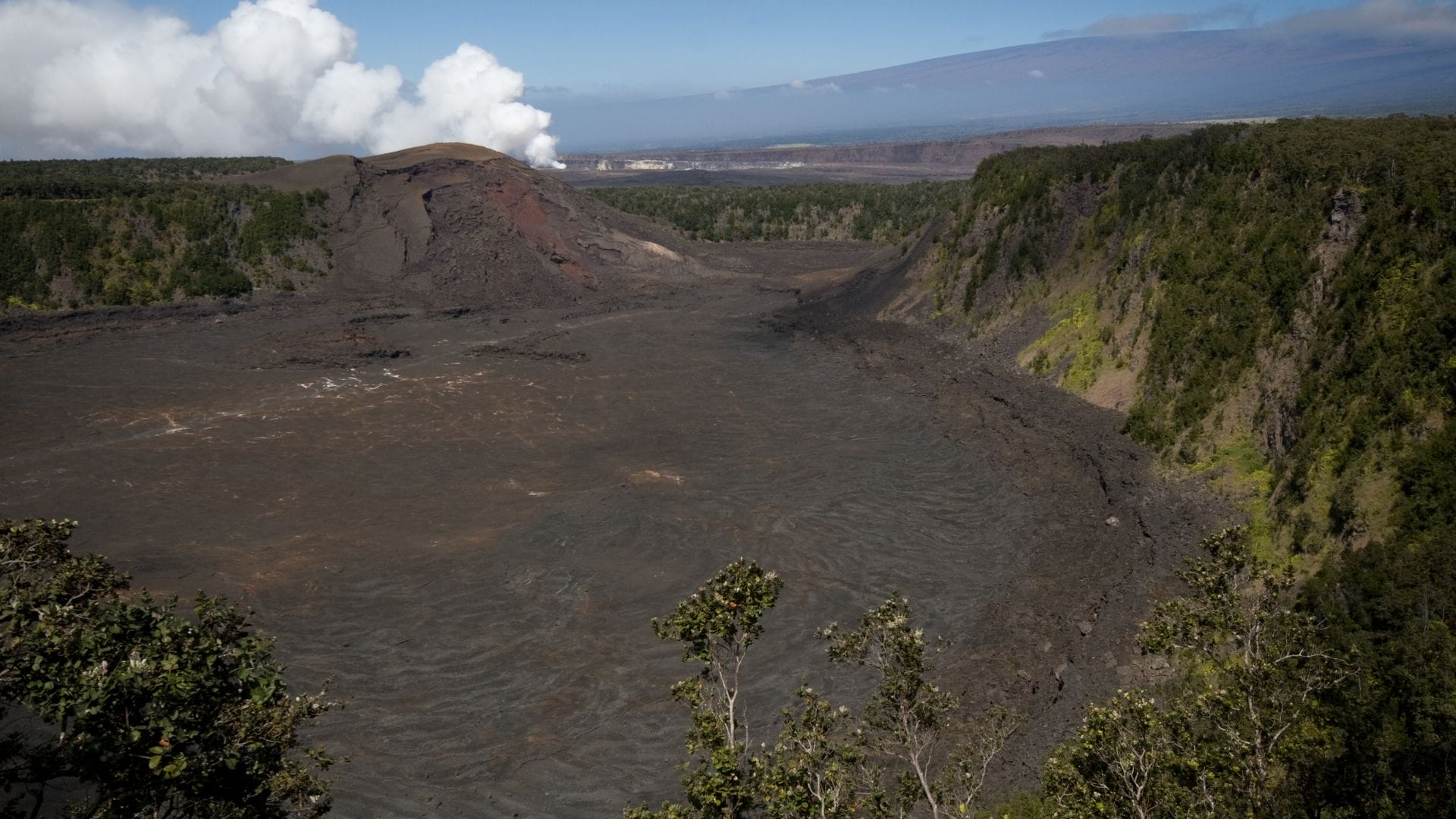
Discover Hawaii Volcanoes National Park
Hawaii Volcanoes National Park is a natural marvel, boasting two of the planet's most active volcanoes - Kilauea and Mauna Loa.
The park offers visitors an unrivaled opportunity to observe geological wonders in real-time. Situated on Hawaii's Big Island, this expansive national treasure spans over 333,000 acres from sea level to Mauna Loa's peak at 13,677 feet.
With its unique blend of volcanic craters and lava tubes alongside lush rainforests teeming with native species, it serves as an extraordinary educational platform for those fascinated by geology or nature. The Hawaii Volcanoes National Park, open around-the-clock all year round, provides flexibility for exploration anytime you desire.
However, due to its location on the windward side of the island receiving approximately 200 inches of rainfall annually, anticipate some rainy weather during your visit.
Hawaii Volcanoes National Park offers an incredible opportunity to experience geological wonders and native species in a lush rainforest environment, open 24/7.
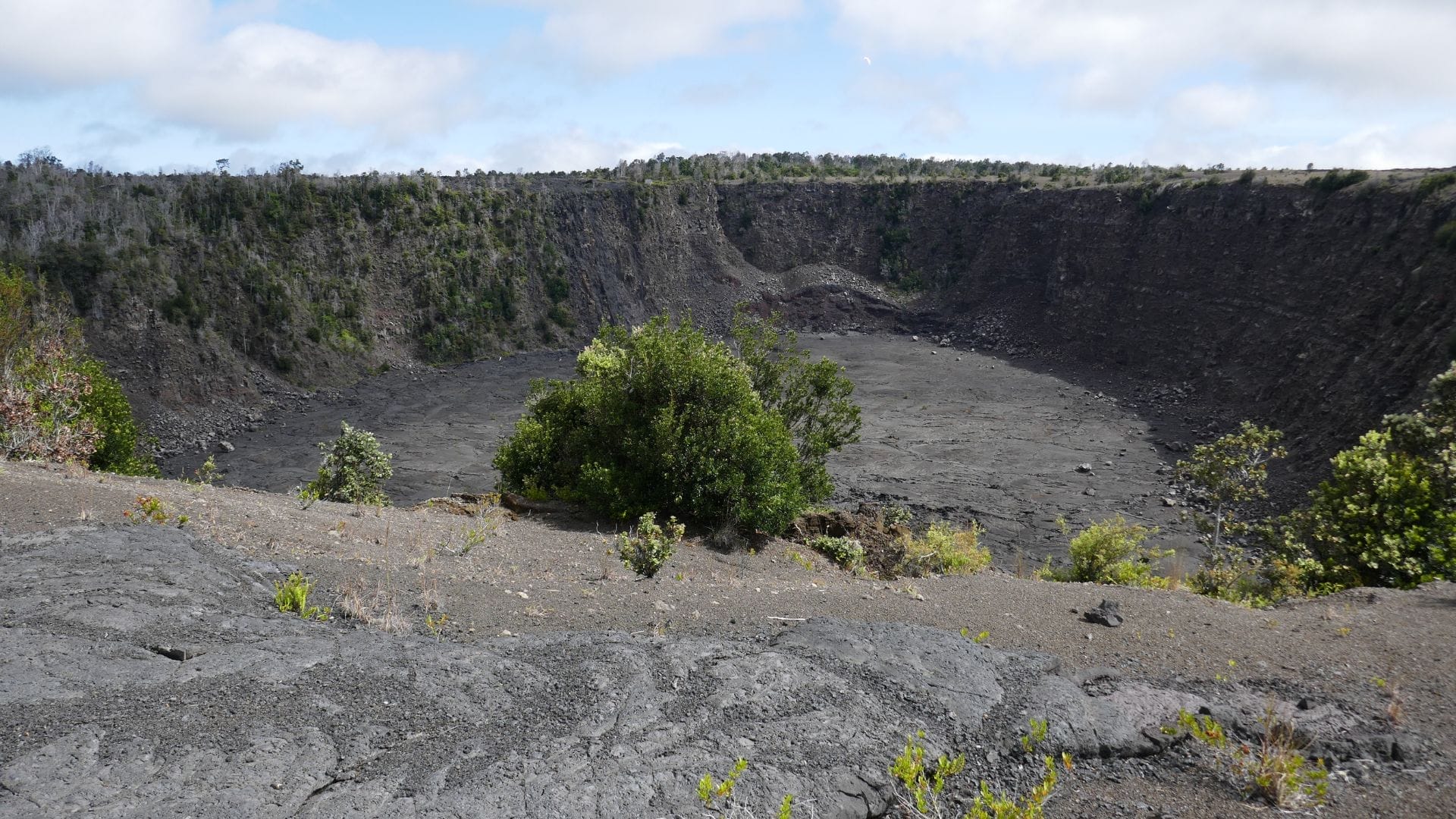
Diverse Ecosystems
The National Park is a haven for diverse ecosystems, from tropical rainforests at the lower elevations to subalpine woodlands higher up, which provide habitat for various endemic species such as Hawaiian honeycreepers and happy-face spiders.
These varied habitats are home to numerous endemic creatures such as Hawaiian honeycreepers (birds) and happy-face spiders (insects). In addition to these fascinating wildlife encounters along trails or guided tours, there are several rare plants like ohia lehua trees known for their bright red flowers which bloom even amidst fresh lava fields.
The National Park offers a variety of unique ecosystems and wildlife, including Hawaiian honeycreepers, happy-face spiders, and ohia lehua trees with bright red flowers.

Experience Cultural Significance
One day in Volcano National Park is all it takes to experience the cultural significance that this breathtaking site has to offer.
From Oahu, you can take a quick flight or ferry over to the Big Island and spend the day exploring the diverse landscapes and ancient traditions that this park has preserved for centuries.
From the commanding sight of Mauna Loa and the active Kilauea volcano, to the rich Hawaiian folklore that surrounds this sacred land, your senses will be awakened by the beauty and history of this extraordinary place.
Don't just take our word for it, come see for yourself and take home a memory that will last forever!
Spend a day in Volcano National Park to explore the diverse landscapes, active volcanoes, and Hawaiian folklore, and create memories that will last a lifetime.

Planning Your Day Trip to Volcano National Park from Oahu
The first step is to secure your transportation, as regular flights and ferries are operating between Honolulu on Oahu and Hilo or Kona on the Big Island.
We recommend renting a car and coming to the national park from the Big Island's airport, as it's more convenient and the price will be very similar.
Of course, reserving a rental car in advance is highly recommended, especially during the summer months.

Best Time to Visit
Volcano National Park welcomes visitors throughout the year, but each season offers unique attributes that are worth considering when planning your trip.
Spring often brings ideal weather conditions and fewer tourists, providing ample opportunities for uninterrupted exploration. The rainy seasons, from November to March, can result in lush landscapes.
However, be aware that muddy trails and sporadic road closures due to flooding are possible during these months.
Spring is the ideal time to visit Volcano National Park for its pleasant weather and lack of crowds, while the rainy season offers lush landscapes and unique experiences.
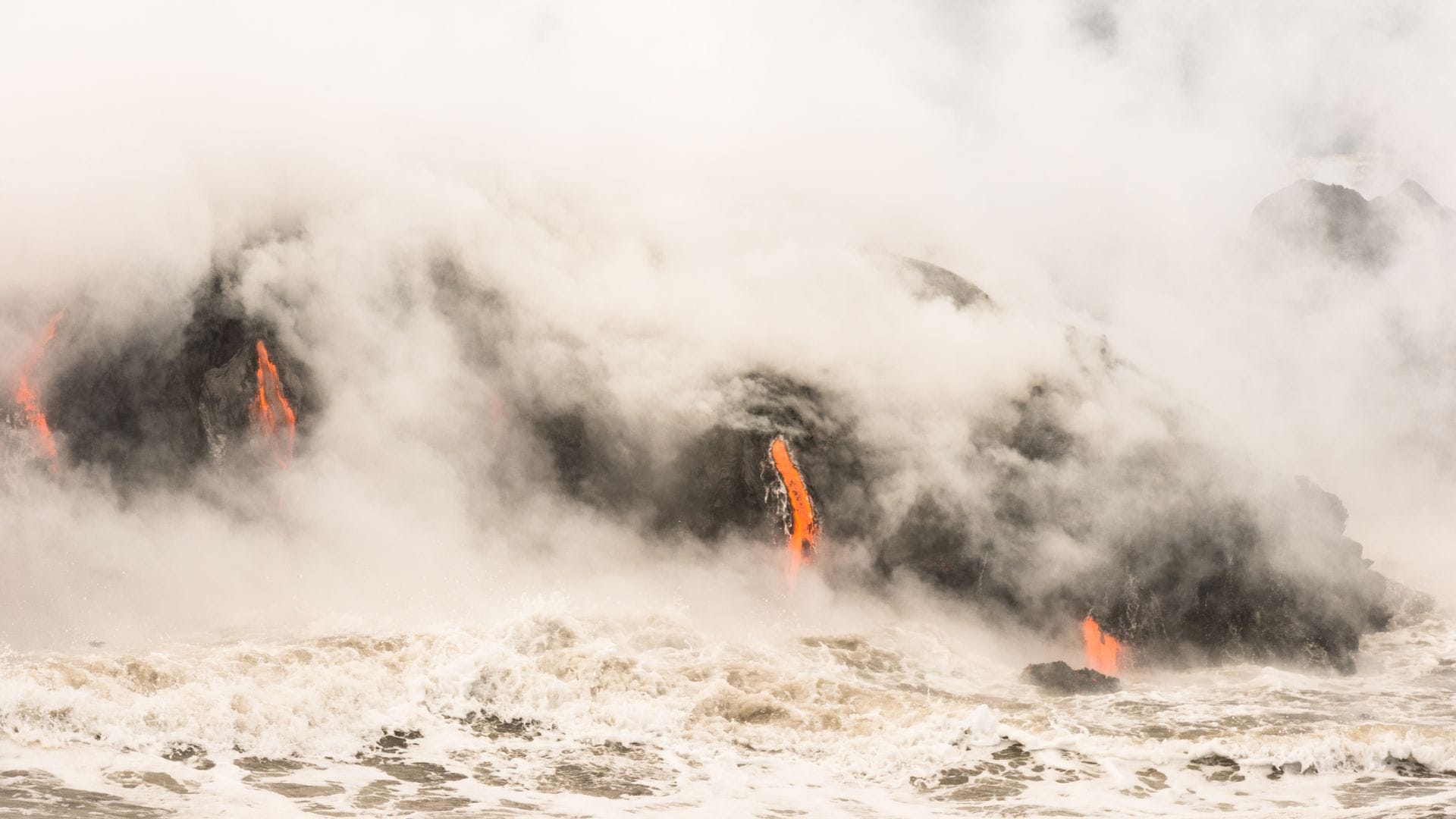
Safety Tips for a Day Trip to Volcano National Park From Oahu
Stick to trails and roads that are marked and open and do not enter areas that have been closed.
Stay clear of cliffs, cracks, and steam vents as they may collapse or be slippery. Keep your feet comfortable by wearing sturdy close-toed shoes as hiking on lava rock can be unpredictable.
Remember to put on sunscreen, a hat, and sunglasses since lava fields are hot and shadeless.
Also, keep yourself hydrated by bringing at least two quarts of drinking water per person. Along the coast, be prepared for strong winds, steep cliffs, high waves, and unpredictable surf.
Always hike and travel with at least one other person and let someone know where you plan to visit. Lastly, know your limits and do not put yourself in any avoidable danger.
When exploring, always wear protective clothing, bring lots of water, travel with a companion, and be mindful of potential risks to ensure a safe and enjoyable experience.

Potential Hazards in the Park
The two active volcanoes - Kilauea and Mauna Loa are breathtaking sights, yet they present certain risks due to their volatile nature.
The volcanic gases like sulfur dioxide can be harmful, especially for people with respiratory issues. Stay updated about current volcano conditions before venturing out. Besides this, recent lava flows or seismic activities might cause ground instability in some areas within the park.
To avoid any danger, stick strictly to marked trails and pay attention to warning signs set up by park officials.
Visiting Hawaii's active volcanoes Kilauea and Mauna Loa can be a breathtaking experience, but visitors should take caution by staying on marked trails and following official warnings.

Be Prepared for Emergencies
Last but definitely not least: Be prepared. Carry basic first aid supplies along with enough food and water supply per person during your trip.
A map of the area, although it may seem outdated considering the availability of digital maps today, could turn out invaluable in case mobile devices run low on battery life.
Be prepared for your trip by packing basic first aid supplies, food and water, and a map of the area to ensure you are ready for any situation.
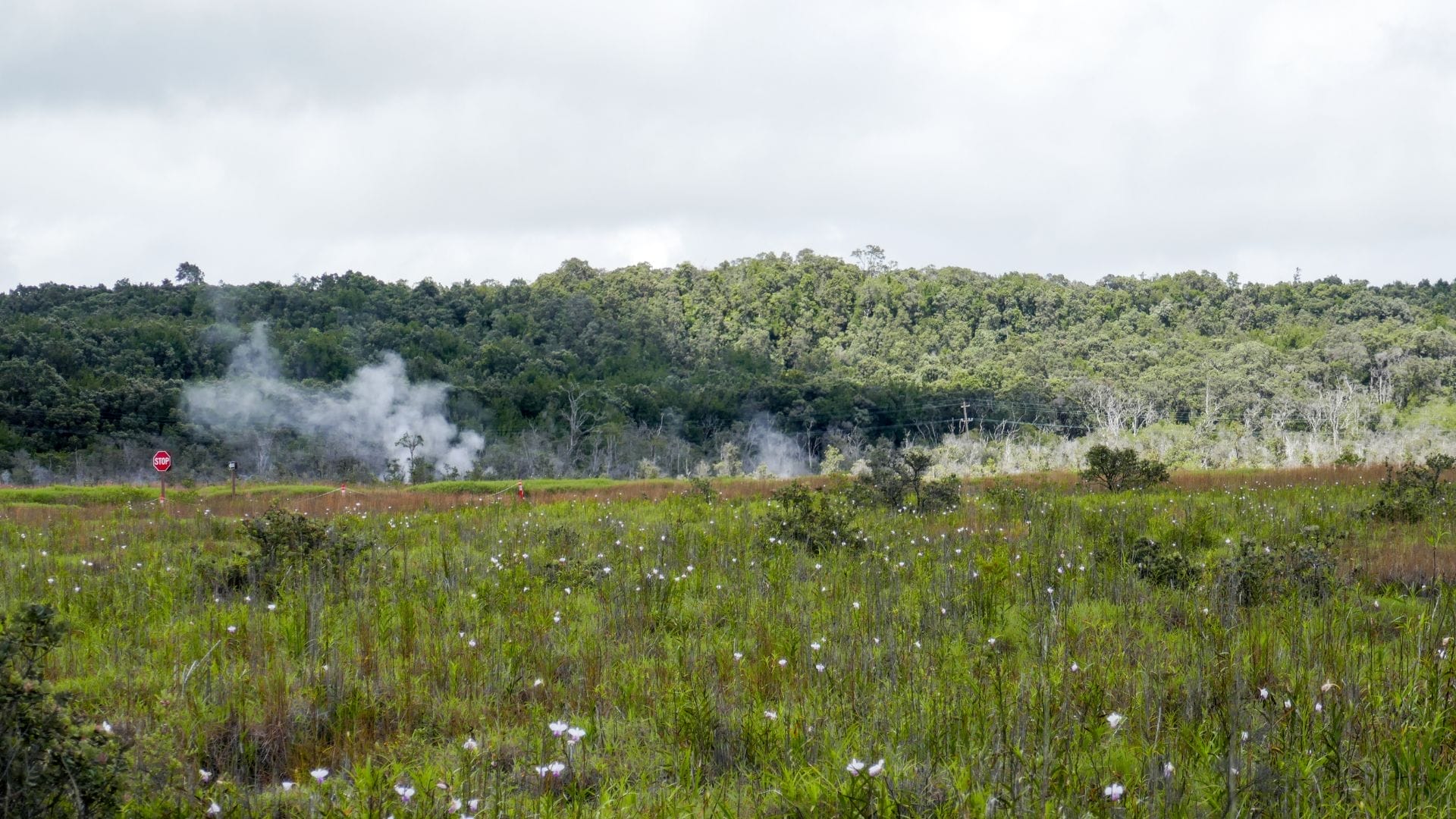
Supporting Conservation Efforts
Considering a trip to Volcano National Park on the Big Island. Not only will you be treated to stunning landscapes and the thrill of an active volcano, but you'll also be supporting conservation efforts.
By paying the park entrance fee, you're helping to preserve one of Hawaii's most unique natural wonders.
And if you really want to do your part, consider participating in a volunteer program or donating to the park's nonprofit partner, the Hawaii Volcanoes National Park Conservancy.

The Role of Leave No Trace Principles
Leave No Trace principles are not just guidelines but rather ethical obligations that help minimize human impact while enjoying outdoor activities.
These seven principles include preparing ahead, sticking to durable surfaces when traveling or camping, disposing of waste properly, leaving nature undisturbed by taking only photographs and memories with you, minimizing campfire impacts if applicable, respecting wildlife from a distance without altering their behaviors in any way, and being considerate toward other visitors. This will protect the park's delicate ecosystems while also fostering an appreciation for its fragile beauty.
By following the Leave No Trace principles, outdoor activities can be enjoyed while still respecting and protecting nature's delicate ecosystems.
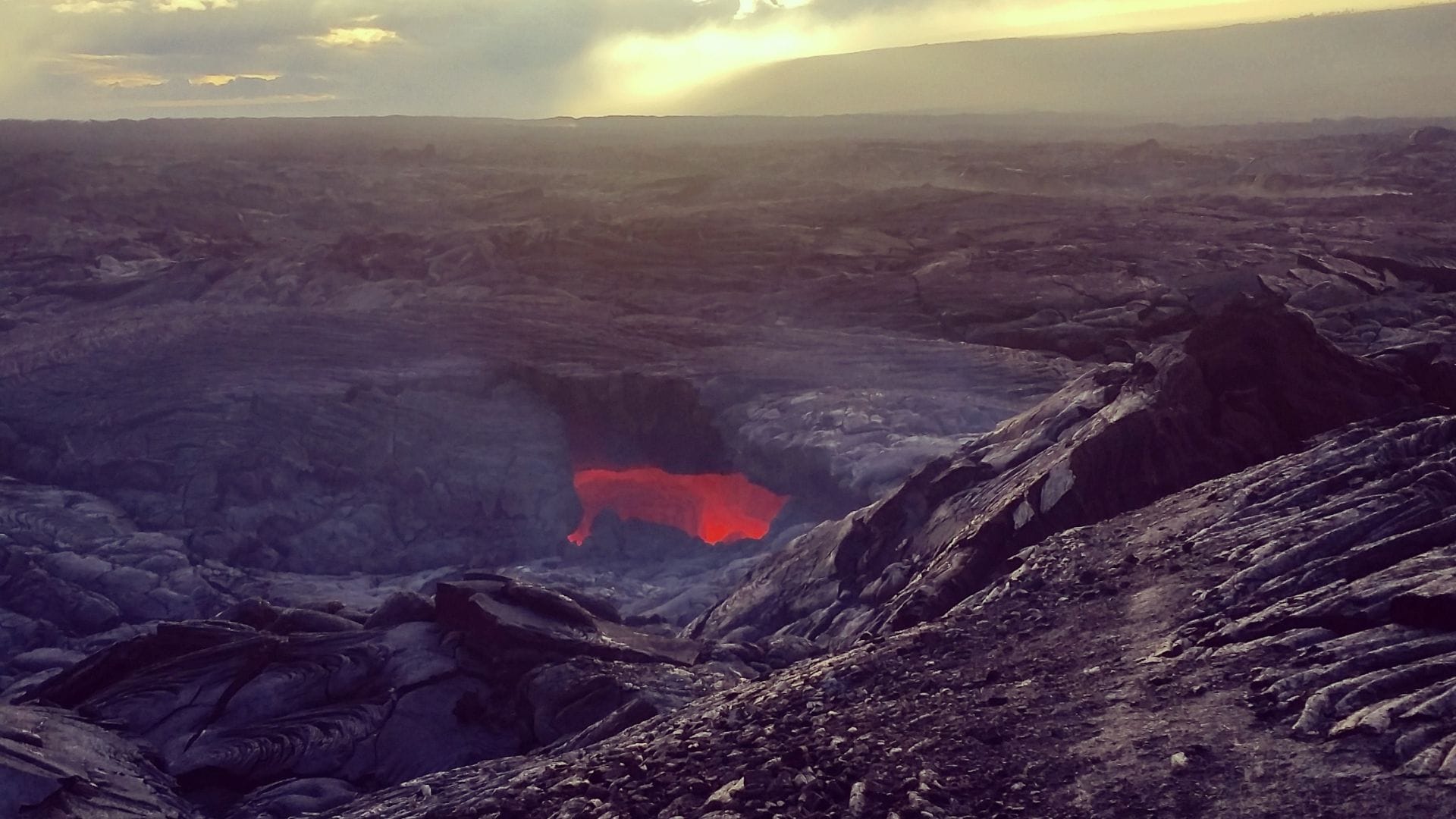
Conclusion:
All in all, a day trip to the beautiful and grand Volcano National Park is absolutely worth it from Oahu.
Whether you decide to drive or take a bus, this natural wonder of Hawaii will bring much joy and pleasure.
Moreover, because you only have one day, you can plan your trip by checking out the maps and making sure that you’ll be able to go around and see what you want in a timely manner.
To conclude, this is one of the best places to visit from Oahu, and we couldn't recommend it enough!
Frequently Asked Questions
How do i get from oahu to volcano national park.
You can travel from Oahu to Hawaii Volcanoes National Park by booking a flight or ferry service from Honolulu to Hawaii's Big Island.
Renting a car is recommended for exploring the park conveniently.
How much time should I spend at Volcano National Park?
A full day trip is usually enough to explore the main highlights of Hawaii Volcanoes National Park, including Kilauea and Mauna Loa volcanoes.
Can you do a volcano tour from Honolulu?
Yes, there are numerous tours available that offer round-trip transportation and guided experiences in Hawaii Volcanoes National Park starting from Honolulu.
What time of day is best for visiting Volcano National Park?
The park is open 24 hours but early morning or late afternoon visits is better for cooler temperatures and see fewer crowds.
What should I wear to volcano National Park?
At 4,000 feet, the summit of Kīlauea can be pretty chilly no matter what time you visit. Make sure to pack a rain jacket and wear long pants.
Not to mention, a sturdy pair of closed-toe shoes will keep your feet comfortable and protected on your journey. A hat, sunscreen, and a water bottle are also essential to make the most of your trip.
Real Hawaii Tours
Free oahu e-guide.


Iceland's Volcanoes: The Complete Guide

- The 2023 Sundhnukagigar and Litli-Hrutur Volcano Eruptions in Iceland
The 2022 Fagradalsfjall Volcano Eruption in Iceland
The 2021 fagradalsfjall volcano eruption in iceland, why is iceland so volcanic, how many volcanoes are there in iceland, how many active volcanoes are in iceland, iceland volcano map, volcanoes near reykjavik, how often do volcanic eruptions occur in iceland, how dangerous are volcanic eruptions in iceland, the danger of death by iceland volcano eruptions.
- The Danger of Glacial Flood Jokulhlaups
Broader Impact of Iceland Volcanic Eruptions
- What Was Iceland's Worst Eruption?
1784 Laki Eruption
1973 heimaey westman islands eruption, how does iceland use its volcanoes, geothermal energy from icelandic volcanoes, tourism around the volcanoes of iceland, iceland volcano tourism, guided tours of litli-hrutur volcano, adventure tours of iceland volcanoes, tours that go inside a volcano, the top nine most famous iceland volcanoes.
- 9. Eyjafjallajokull: Iceland's Most Famous Volcano
8. Thrihnukagigur: The Only Volcano You Can Enter
- 7. Grimsvotn: Iceland's Deadliest Volcano
6. Hekla Volcano: The Gateway to Hell
- 5. Katla Volcano: Eyjafjallajokull Volcano's Explosive Neighbor
4. Snaefellsjokull Volcano: The Door to the Center of the Earth
- 3. Askja: Iceland's Hot Spring Volcano
2. Krafla: The Cold Crater Lake Volcano
1. hverfjall/hverfell: easy hike-around volcano, iceland volcano live stream and cam.
Discover fascinating facts about Iceland's volcanoes, one of its hallmark geographic features. Learn about Iceland's volcanic activity and the most famous eruptions in history. Find out about volcano tourism and how you can visit these natural wonders in this complete guide to volcanoes in Iceland.
The Land of Fire and Ice, Iceland, is a natural wonderland where the freezing forces of glaciers and arctic weather are constantly battling with the Earth's fierce heat. The result is a world of dramatic contrasts across a stark landscape, with a beauty like nowhere else.
Iceland's volcanoes define the nature of the land, creating endless fields of moss-coated lava, sweeping plains of black sand, jagged peaks, hot springs, geysers, and vast craters.
Top Volcano Tours in Iceland
Inside the volcano thrihnukagigur tour with transfer from reykjavik, landmannalaugar super jeep tour with pickup from reykjavik, classic 1 hour lava tunnel caving tour of the raufarholshellir lava tubes.
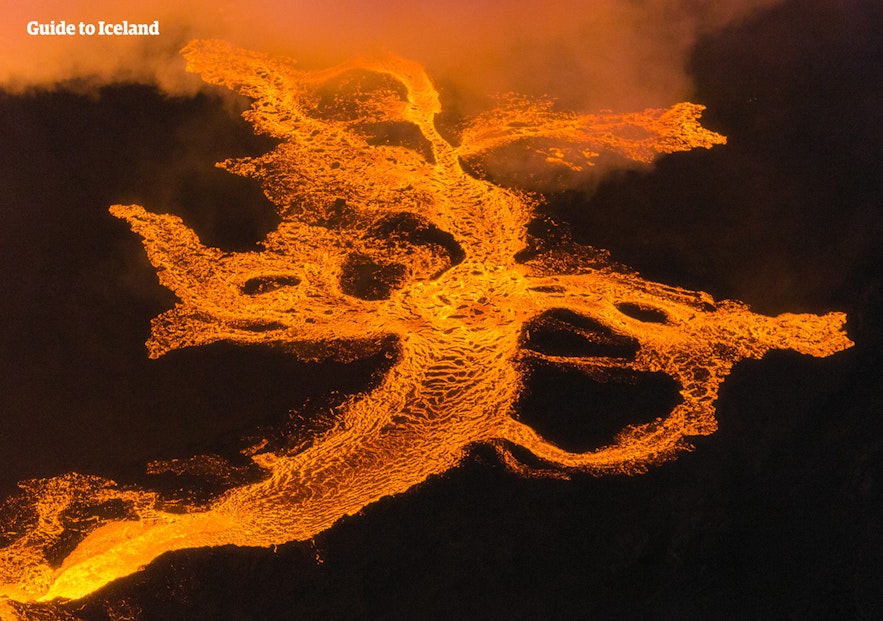
Thousands flock to Iceland to witness its volcanoes and the marvels they create. During eruptions like the most recent one that took place on the Reykjanes peninsula , even more people rush over for their chance to see one of the Earth's most dramatic and beautiful phenomena.
The 2023 Sundhnukagigar and Litli-Hrutur Volcano Eruptions in Iceland
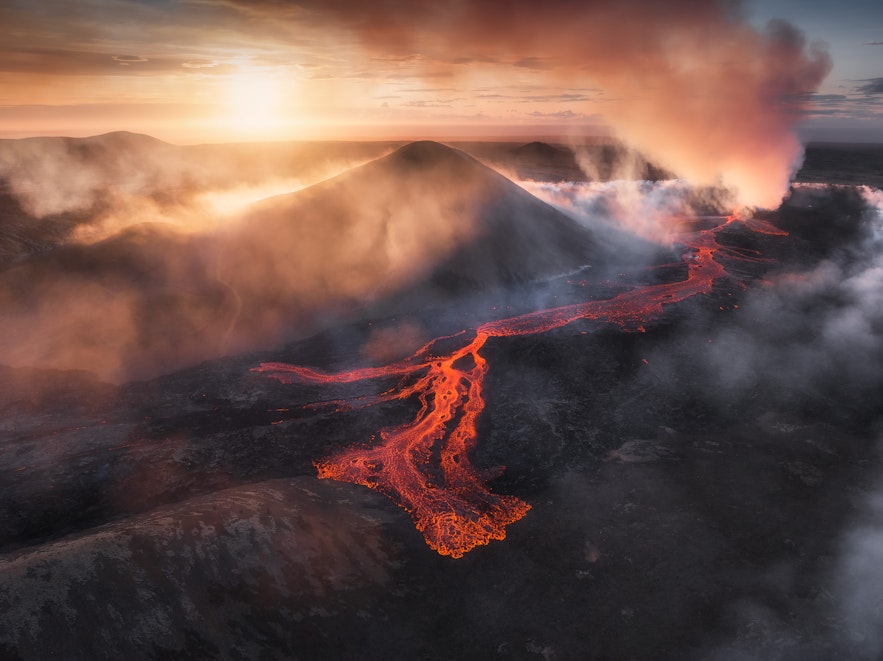
The eruption started after a week of constant earthquakes in the area that followed the same patterns as the previous eruptions in 2022 and 2021. This meant that volcanic activity was expected by locals, and once it finally started on July 10th, people were excited to see the brand-new fissure.
On the first day, authorities and specialists closed off the area while the situation was being assessed and data was gathered. The next day, a hiking path to the eruption site was established for visitors.
The eruption ended on August 5th, 2023, but the aftermath of the volcanic eruption can still be witnessed. This would not, however, be the last of the volcanic activity that Iceland would experience in 2023.
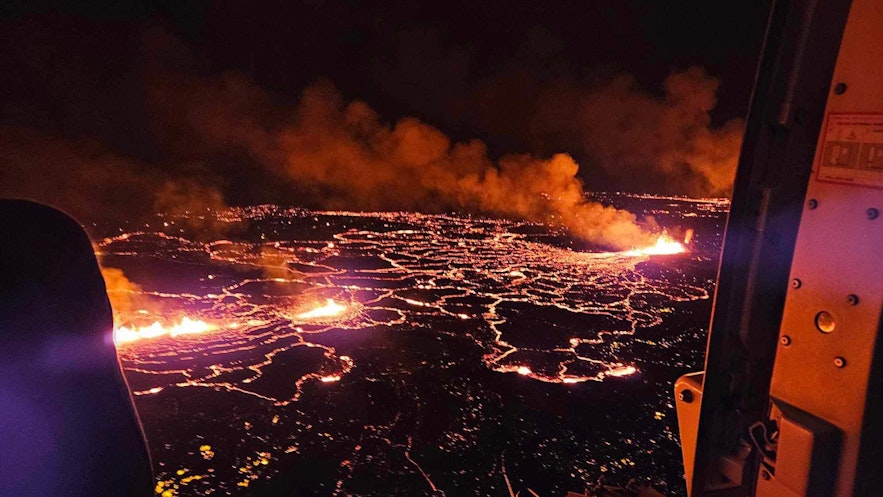
On December 18th, a fissure opened in Sundhnukagigar , just northeast of Grindavik. This eruption was initially more powerful than the previous eruption, but thankfully, it quickly became apparent that the flow of the lava would not endanger the lives or livelihood of anyone in the area.
Although initially very powerful, the eruption was short-lived. On December 21st, the eruption was declared over. You can find many guided tours of the volcano area if you want to see the aftermath, and you can also book a helicopter tour to the eruption site for an unforgettable birds-eye view of this new piece of earth.
- See the Complete Guide to the 2023 Eruption of Litli-Hrutur Volcano
- See the Complete Guide to the 2023 Sundhnukagigar Volcanic Eruption
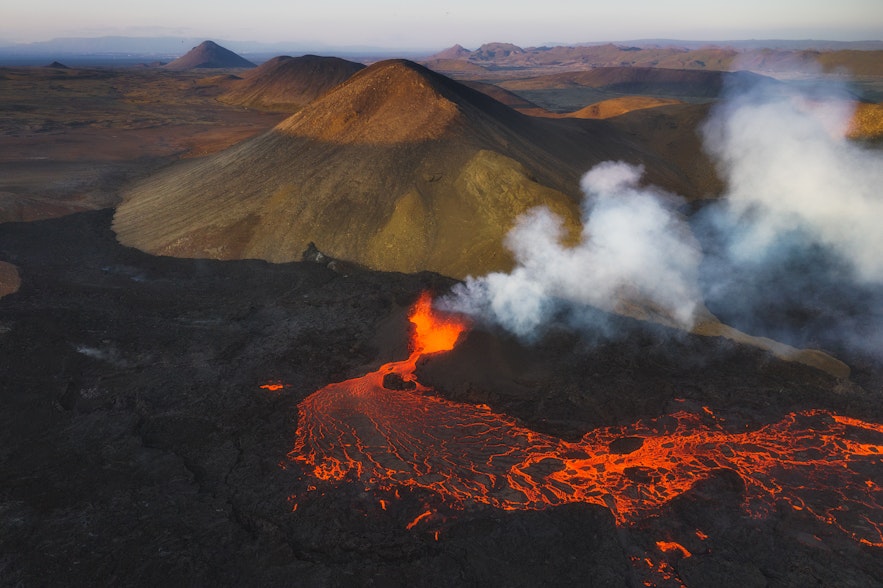
In the weeks leading up to the eruption, there had been significant tectonic activity on the Reykjanes peninsula. Some earthquakes reached as high as 5.2 on the magnitude scale and could be felt in Reykjavik. On August 3rd, lava finally reached the surface for the first time since the last eruption ended in September of 2021.
- Read the Complete Guide to the 2022 Eruption of Fagradalsfjall Volcano
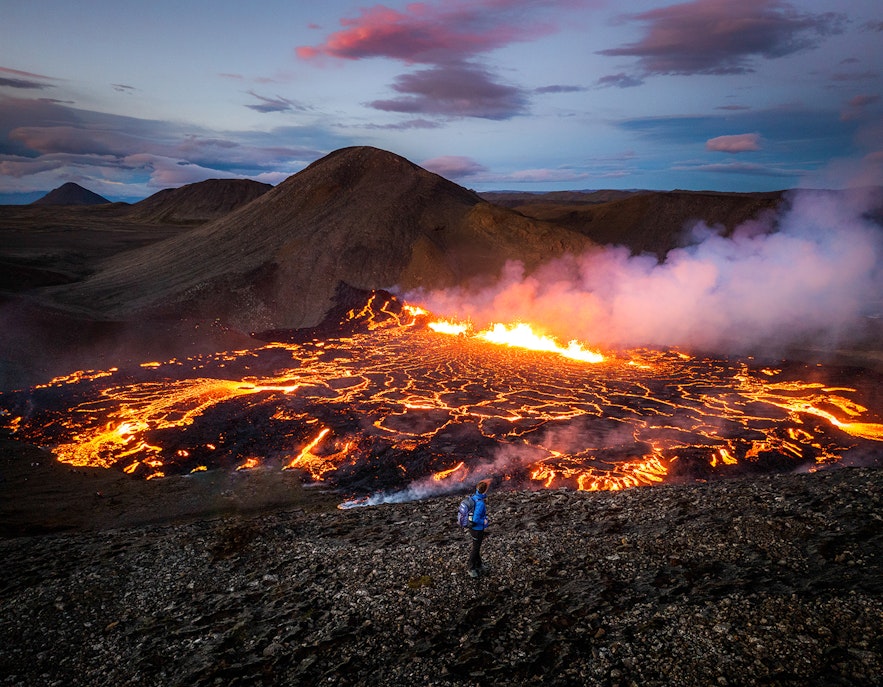
Reaching the Fagradalsfjall volcano requires hiking for around two hours round-trip, so wear good hiking shoes and warm clothes, as it can get windy in that area. Even if the weather in Iceland is nice when you set out, the conditions can change in a heartbeat.
If you are looking for a quicker way to see the eruption site, we recommend booking a helicopter tour, allowing you to explore Meradalir valley from above .
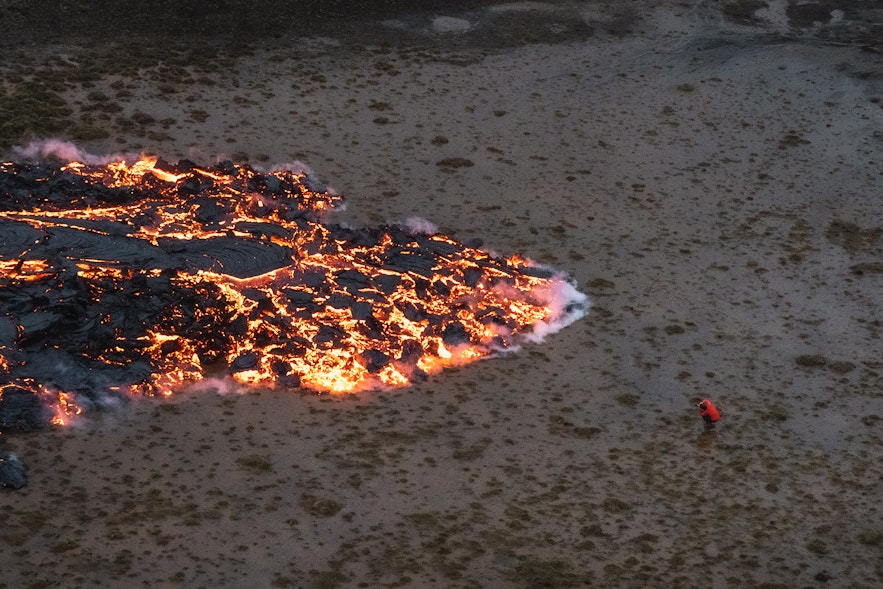
Top Self Drive Tours in Iceland
Best ice cave tour in vatnajokull glacier starting from jokulsarlon glacier lagoon, 10-day self-drive tour of the complete ring road of iceland with top attractions & snaefellsnes, best 1-week summer self-drive tour of the ring road of iceland & golden circle.
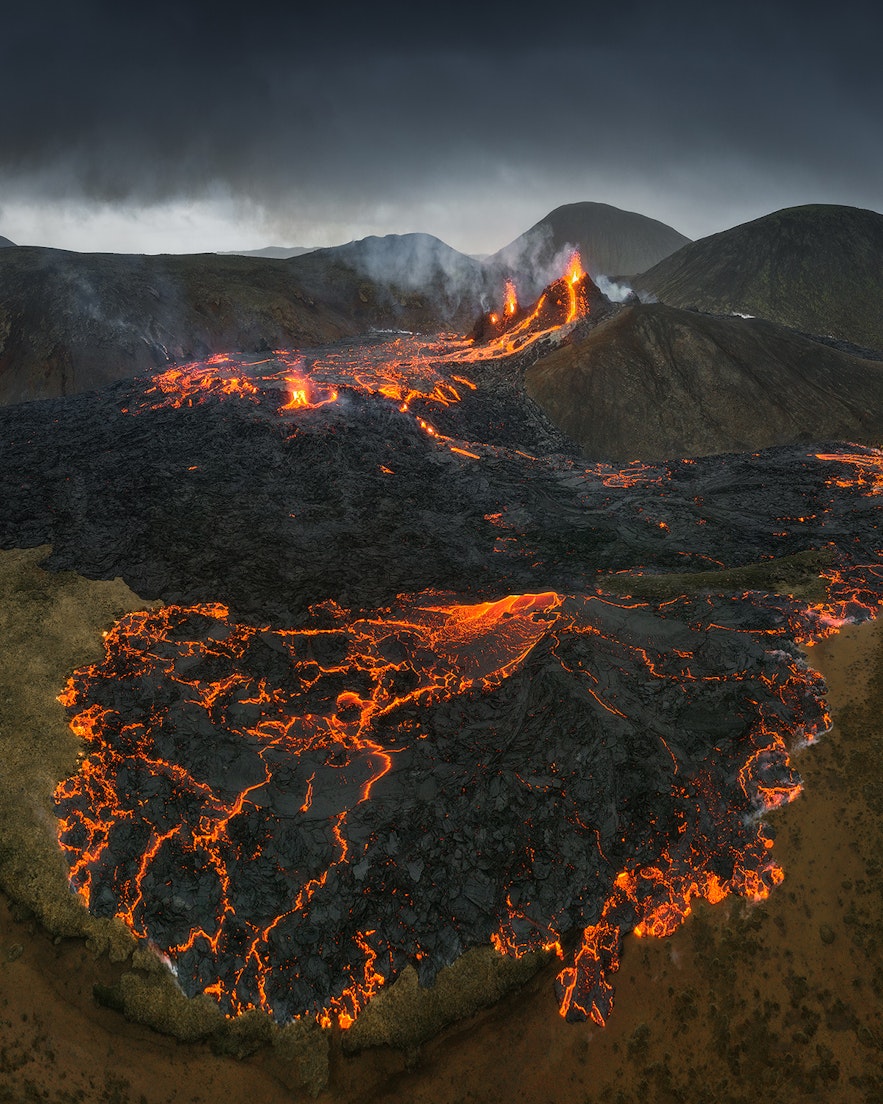
In 2021, Iceland experienced a magnificent eruption on the Reykjanes peninsula, the land that connects Reykjavik with Keflavik International Airport . In the weeks before its explosion, tens and thousands of earthquakes shook the capital and surrounding areas - normally a surefire forecast of imminent volcanic activities.
At 9:30 PM on March 19, 2021, a great fissure opened in the Geldingadalur valley at Fagradalsfjall volcano , which is 2,300 feet (700 meters) long and covers 0.4 square miles (one square kilometer).
Although close to the capital, the Fagradalsfjall volcano is located in a sheltered valley away from any settlements or infrastructure, making its eruption rather undisruptive.
- See also: The Complete Guide to the Fagradalsfjall Volcanic Eruption in Geldingadalur
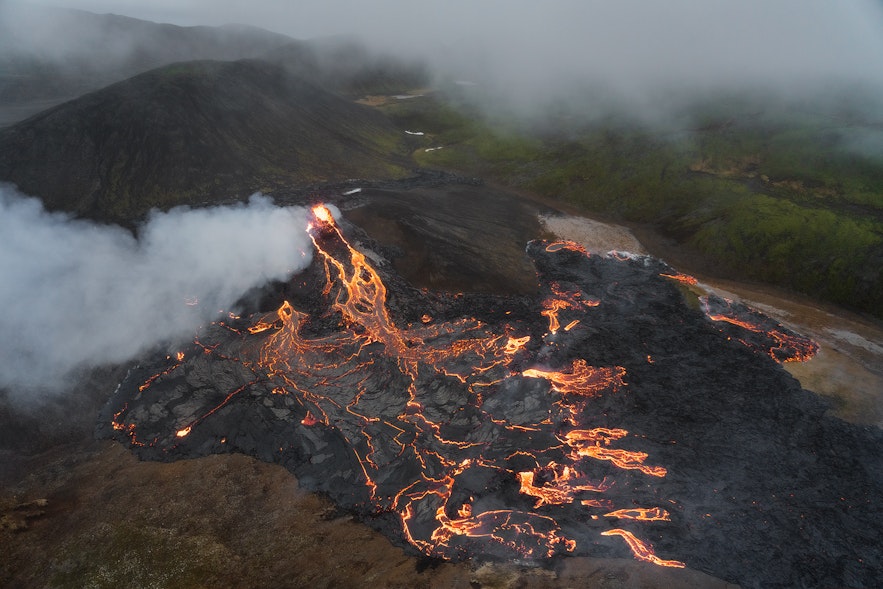
Fagradalsfjall was an effusive rather than an eruptive volcano, meaning its lava oozed and sputtered out of the Earth rather than exploding with ash, fire, and rock.
Of course, the moment Fagradalsfjall volcano went off, everybody wanted to see it. Even though eruptions are quite common in Iceland, they rarely happen close to the capital.
Some tour operators immediately launched private tours to the Fagradalsfjall volcano eruption , allowing guests to approach the spectacular lava flow and marvel over the fiery fountains and molten rivers under the watchful eye of an experienced local guide.
- See also: 10 Insane Photos of the Fagradalsfjall Volcanic Eruption at Geldingadalur
- See also: The Ultimate Guide to Flying Drones in Iceland
Since its first fissure opened, the primary eruption site at Fagradalsfjall volcano coalesced into a single vast crater. As time passed, several new fissures opened around it, showing the volatility and unpredictability of Earth's volcanic forces. The lava solidified and turned black after the eruption ended in September 2021, but it is still red-hot just beneath the surface.
- See also: Live Feed from the Fagradalsfjall Volcanic Eruption in Geldingadalur
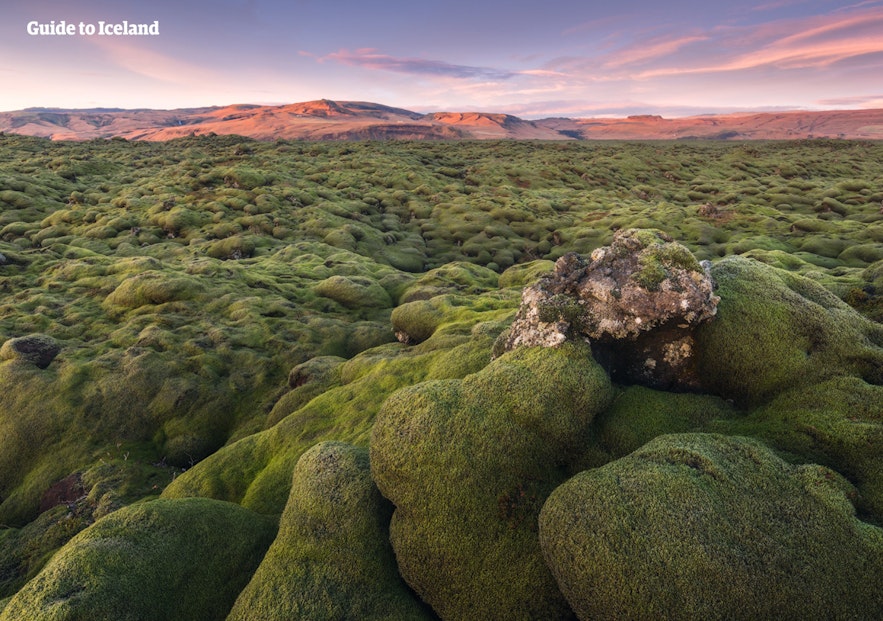
Iceland is a product of volcanism as it sits directly across the Mid-Atlantic Ridge . This ridge separates the North American and Eurasian tectonic plates, and Iceland is one of the few places on Earth where it can be seen above sea level.
Tectonic plates are the crust and the uppermost part of the Earth's mantle. Due to the mantle's convection currents, tectonic plates can move together to form mountains or apart to form oceanic crust. There are 15 major tectonic plates, and the North American and Eurasian plates are two of the biggest.
These two tectonic plates are divergent, meaning that they pull away from each other. As they do so, magma from the mantle rises to fill the space between them, producing volcanic eruptions. This occurs down the length of the rift, as can be noted on other volcanic islands such as those of the Azores and St. Helena .
There are many places in Iceland where you can witness parts of the ridge, such as the Reykjanes peninsula and the Lake Myvatn Area . But Thingvellir is the best as you can stand in a valley between the plates and see the continents' walls on opposite sides of Thingvellir National Park . Due to this divergence between the plates, the valley widens by approximately one inch (2.5 centimeters) every year.
Top Glacier Tours
2 day ice cave tour with south coast waterfalls & jokulsarlon glacier lagoon, 3-day northern lights tour of iceland’s golden circle & south coast with ice caving & glacier hiking.
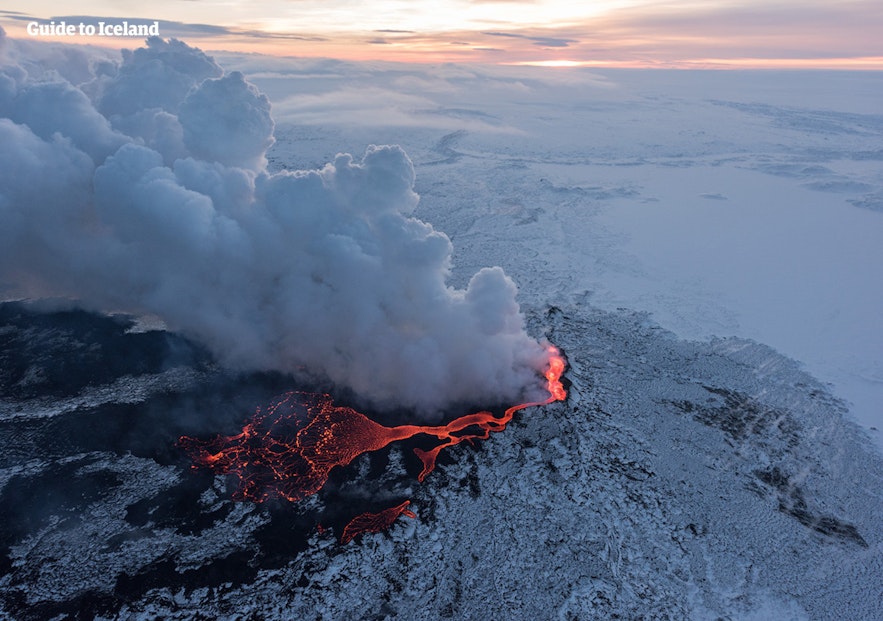
There are approximately 130 active and inactive volcanoes in Iceland. Most of these volcanoes are active, with the only dormant sites found in Iceland's Westfjords .
The Westfjords no longer have any activity because it's the oldest part of Iceland's landmass. This area formed around 16 million years ago and has been pushed away from the Mid-Atlantic Ridge. Thus, the Westfjords is the only part of the country that has to heat its water with electricity (rather than using geothermally-heated water).
Top Nature Tours in Iceland
Small group tour of snaefellsnes national park with transfer from reykjavik.

The main active volcanoes in Iceland run along a curved central line roughly from northeast to southwest. From north to south, the volcanoes' names are Krafla, Askja, Laki-Fogrufjoll, Grimsvotn, Hekla, Vatnajokull, and Katla, followed by Heimaey and Surtsey on the Westman Islands. Grimsvotn is the most active volcano in Iceland.
Here's a map of Iceland's active volcanoes to make it easier to understand. This is just a rough categorization based on geographical zones:
- The West Volcanic Zone
- The East Volcanic Zone
- The North Volcanic Zone
- The Westman Islands
- The Snaefellsjokull Belt
- The Oraefajokull Belt
As we can see on the map above, Reykjavik is situated along the East Volcanic Zone. There are several active volcanoes near Reykjavik, including the recent Fagradalsfjall volcano and the currently erupting Litli-Hrutur. They're the nearest active volcanos to Reykjavik, about 18.6 miles (30 kilometers) southwest of the capital.
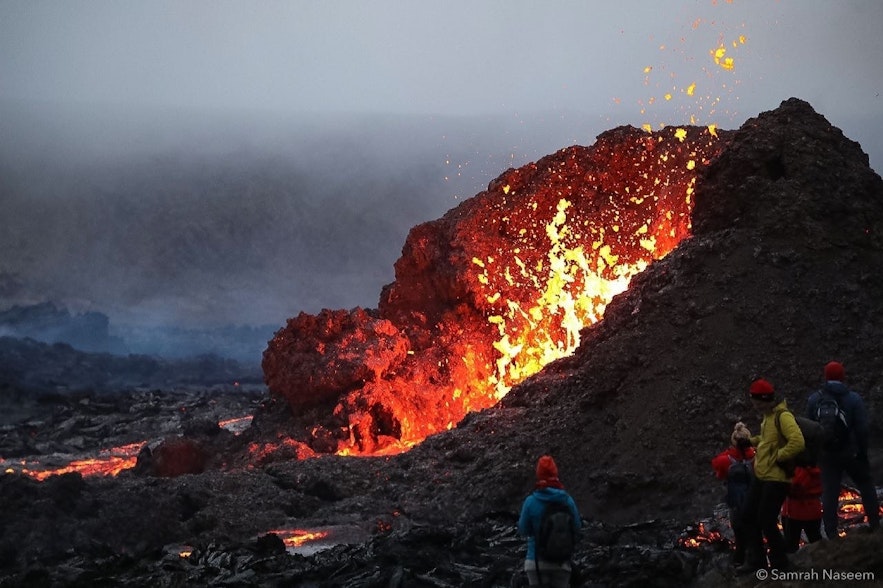
Volcanic eruptions in Iceland are relatively regular yet unpredictable occurrences. Since the turn of the 19th century, not a decade has gone by without one; however, it's entirely random whether they go off in quick succession or with longer spaces between eruptions.
Before Litli-Hrutur and Fagradalsfjall volcanoes, Iceland's most recent known eruption was the Holuhraun volcano in the Highlands in 2014. Grimsvotn volcano had a short eruption in 2011, and, more famously, the Eyjafjallajokull volcano caused a lot of travel disruptions back in 2010.
The word "known" is used because there have been several suspected subglacial volcanic eruptions at different locations around the country that did not break the ice. Examples include the Katla volcanic eruption in 2017 and the Hamarinn volcanic eruption in 2011.
- See also: 15 Incredible Photos of Holuhraun Volcano
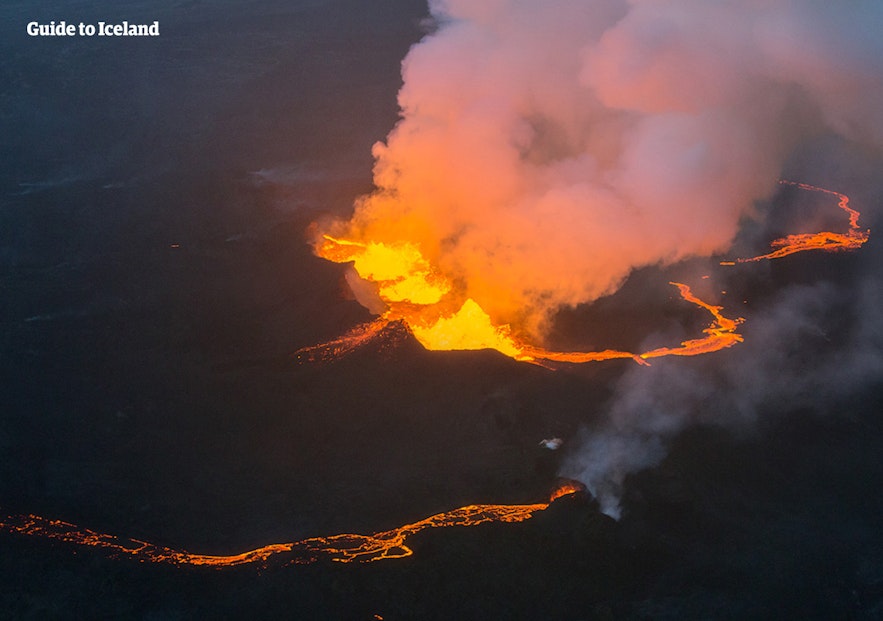
As much as the prediction and response to Icelandic volcano eruptions have improved, there are still some dangers travelers should be aware of during an eruption:
- Should an eruption occur in Iceland during your stay, it's essential to be aware of the wind's direction. Even an eruption in the Highlands can affect the air quality in Reykjavik if the winds are unfavorable, causing respiratory problems in the young, elderly, and those prone to them.
- It's recommended that people remain inside with the windows closed when the toxicity levels are high. You can see any warnings about eruptions and air quality on the Icelandic weather website .
The threat to human life during volcanic eruptions in Iceland nowadays is minimal. Seismic stations around the country are excellent at predicting eruptions. If a significant volcano such as Katla or Askja shows signs of rumbling, the areas are quickly restricted and closely monitored.
Most towns are far from active volcanoes due to the good sense of early settlers. For example, the south coast of Iceland has very few towns and villages since major volcanoes like Katla and Eyjafjallajokull sit close by. As both of these peaks are under glaciers, the eruptions can cause enormous glacial floods that wipe out anything between them and the ocean.
This causes much of the south to look like a black-sand desert.
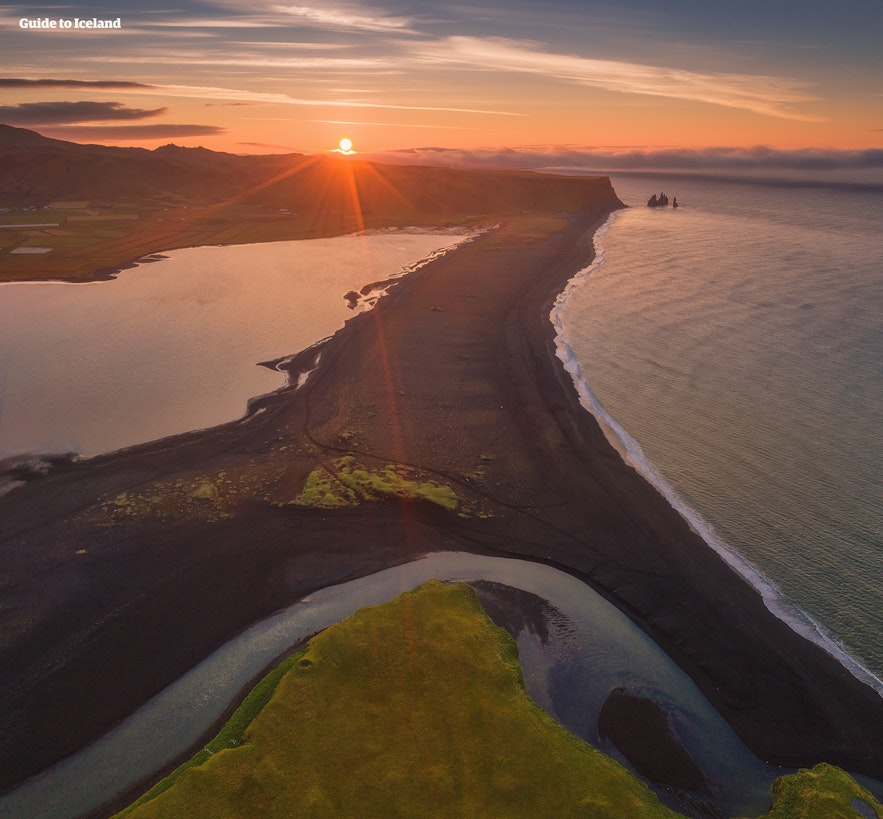
The Danger of Glacial Flood Jokulhlaups
These glacial floods (or jokulhlaups as they're called in both Icelandic and English) remain one of the most dangerous aspects of Iceland's volcanoes due to their unpredictability. Subglacial eruptions can occur without anyone knowing, and flash floods can happen seemingly without warning.
Science is constantly improving, and nowadays, areas can be cleared and monitored if a jokulhlaup is suspected. This is why you should never drive on closed roads, even if it's the summer with no visible hazards ahead.
Though most volcanoes are far from population centers, the unexpected can still occur. When it has, Iceland's emergency measures have been incredibly effective, as was the case with the evacuations following the 1973 eruption of the Heimaey volcano in the Westman Islands .
- See also: Top 5 Islands in Iceland
Though the threat to human life in an Icelandic eruption is very low, its broader impacts can still be enormous. Eruptions in Iceland are major world events that can lead to dramatic consequences, even hundreds of miles away.
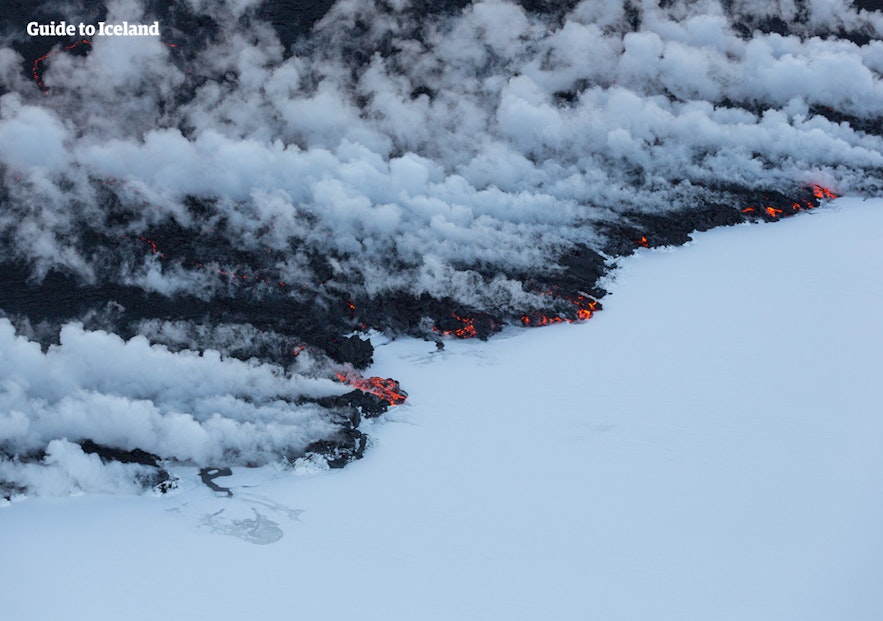
The elements brought up from the depths of the Earth in these eruptions can poison crops and livestock, thus crippling those who make a living off the land. Holuhraun volcano was blamed for the mass death of thousands of sheep across the country in 2015, an event that seriously threatened many Icelandic farmers' livelihoods.
The ash clouds produced by Iceland's volcanoes can also wreak havoc. When the Eyjafjallajokull volcano erupted in 2010, flights were grounded across Europe, causing noticeable economic harm. This, however, was a relatively minor consequence compared to previous ash clouds. For example, the Laki volcano's eruption in 1784 was far more catastrophic.
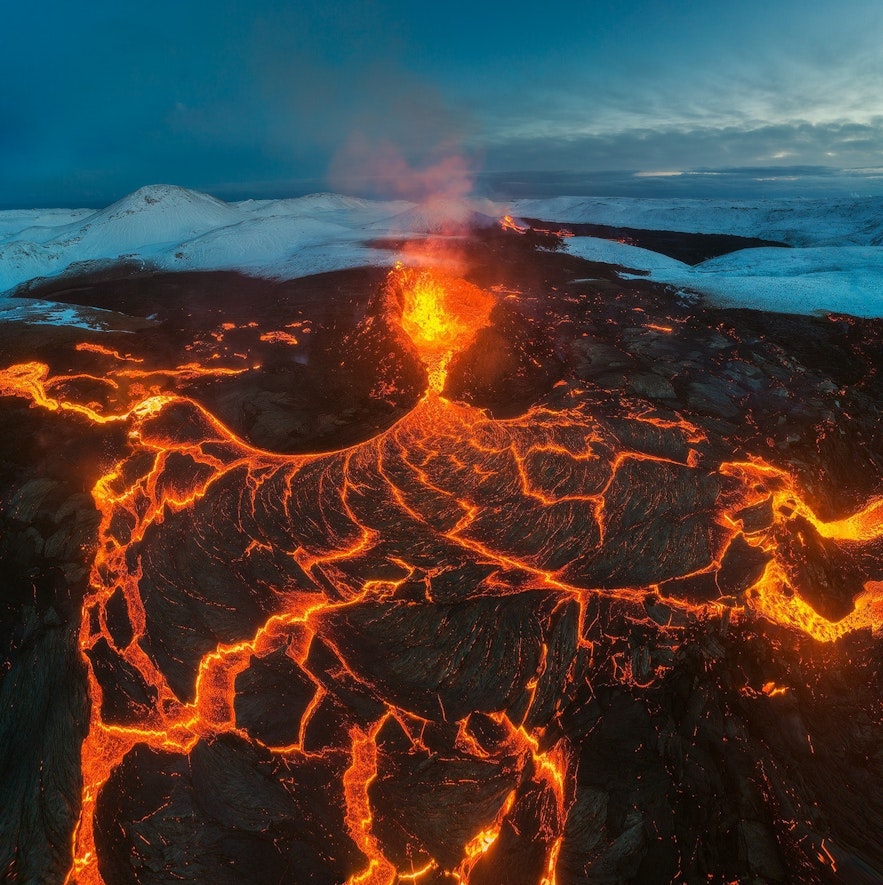
What Was Iceland's Worst Eruption?
The most catastrophic Icelandic eruption in terms of human life was undoubtedly the 1783-1784 Laki volcanic eruption mentioned above. It impacted the climate and almost tore the nation of Iceland apart.
Due to the sheer volume of ash, crops across the country were rendered entirely inedible, and the rivers were poisoned. It wiped out half of the livestock, and a third of Icelanders lost their lives to the resulting famine, which is called the "mist hardships" or "móðuharðindin" in Icelandic. Another third left the country, most emigrating to North America in hopes of a prosperous new life far from what appeared to be a dying island.
- See also: The History of Iceland
The ash cloud from the Laki volcano's eruption went right across Europe, causing dense fog that shut down ports, led to intense food shortages, and brought such heat that most foods quickly spoiled. It also poisoned those who worked outside. The UK had lost an estimated 23,000 people to the gases.
The consequences were even more dramatic in France. Its impact on the country's climate caused famines so terrible that many historians consider the 1784 Laki eruption one of the French Revolution's driving catalysts. In Egypt, the eruption lowered temperatures, leading to a lack of rainfall, a dried-up Nile River, and the loss of a sixth of the country's population.
All in all, it's estimated that up to six million people died because of the Laki volcano.

The Westman Islands are a volcanic archipelago, with Heimaey as the only inhabited island. At the time of the eruption, 5,200 people lived there. In the early hours of January 22, 1973, a fissure opened on the edge of town and snaked right through its center, tearing apart roads and consuming hundreds of buildings in flowing lava.
Despite happening in the middle of the night in the dead of winter, the island's evacuation was swift and effective. With the population safely on the mainland, Iceland's rescue teams worked with the US troops based in the country to minimize damage.
By constantly pumping seawater onto the lava flow, they redirected it from many houses. This slowed the flow of lava and prevented it from closing the harbor, which would have forever crippled the island's economy.
Though nearly 400 homes were destroyed and the island's infrastructure was heavily damaged, only one person lost their life due to the Heimaey eruption. Today, the town has been rebuilt and is a center for tourists looking to go whale or puffin watching or learn about its eruption history. You can choose from some great accommodation options in the Westman Islands to enjoy all the islands have to offer.
Top Westman Islands Tours

Though the threat of an eruption and concern for its consequences are constants in the Icelandic psyche, Iceland wouldn't be half the country it is today without the volcano systems and geothermal energy.
Much of Iceland's economy and infrastructure relies on the geothermal forces at work here. The vast majority of the country's hot water is pumped directly from the Earth to people's faucets and radiators, allowing for cheap, environmentally-friendly heating. Vegetables, fruits, and herbs are grown year-round in greenhouses, allowing fresh produce even in the dead of winter.
Iceland also produces about 30 percent of its electricity at geothermal power stations. As the rest is hydroelectric, Iceland is one of the world's only countries that almost entirely uses renewable energy sources.
However, this does not mean that the potential of Icelandic volcanoes is always used for good. Heavy industry, particularly aluminum smelting, is slowly increasing in Iceland as foreign entities see the potential in such a tremendous and free-flowing heat source.
Of course, Iceland's tourism industry is also heavily reliant on its volcanoes; after all, you can't be "the Land of Fire and Ice" without the forces of both at work.
Many credit the 2010 eruption of Eyjafjallajokull volcano with Iceland's recent boom in tourism, though it crippled the aviation industry at the time. As the volcano's name tangled the tongues of newscasters around the world, millions were shown footage of this country at its most raw, dramatic, and beautiful, inspiring them to witness it further.
Therefore, it's little wonder that much of the tour industry has built up around exploring volcanoes and volcanic regions. These excursions come in a wide variety of forms.
The aftermath of the eruption of Litli-Hrutur volcano is a sight to behold, and there are many guided tours that will get you to the eruption site to see it with your own eyes. This 8-hour guided tour takes you around the Reykjanes peninsula and towards the eruption site of Litli-Hrutur. If you prefer a quicker way to get there, you can take this 40-minute helicopter tour from Reykjavik , which allows you to experience the new lava field from above.
This Super Jeep tour will take you to some of the craters in North Iceland from the village of Husavik and includes a caving component where you can learn even more about the processes that occur during volcanic eruptions. Meanwhile, this 45-minute air tour will let you see the Grimsvotn crater , beneath the enormous Vatnajokull glacier , from an unmatched aerial perspective.
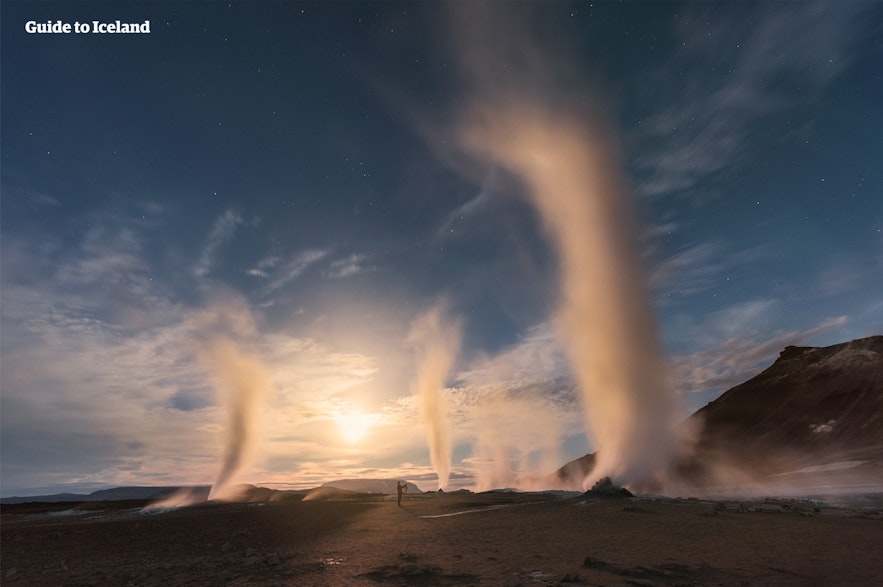
The Into the Volcano tour lets you descend into a dormant volcano's vast, brightly-colored magma chamber via elevator. It's incredibly rare for volcanoes to cool in a way that makes this possible, meaning this is a once-in-a-lifetime opportunity for those seeking Iceland's nature at its most magnificent.
The vast majority of tours in Iceland usually include volcanoes; the country has so many of them that they are inescapable. All Snaefellsnes peninsula tours , for example, are conducted in the shadow of the magnificent Snaefellsjokull volcano . Throughout all excursions around Lake Myvatn , you'll be able to see parts of the Krafla volcanic system , and Highland hikes will expose you to many more.
The Fimmvorouhals hiking trail runs through the lava created by the most recent eruption of the Eyjafjallajokull volcano. Here, you can find two of the newest craters in Iceland, Magni and Mooi .
Given that Iceland has over 130 known volcanoes, it would take a while to see them all. So we've compiled a list of nine volcanoes we recommend that all visitors to Iceland experience firsthand.
9. Eyjafjallajokull: Iceland's Most Famous Volcano
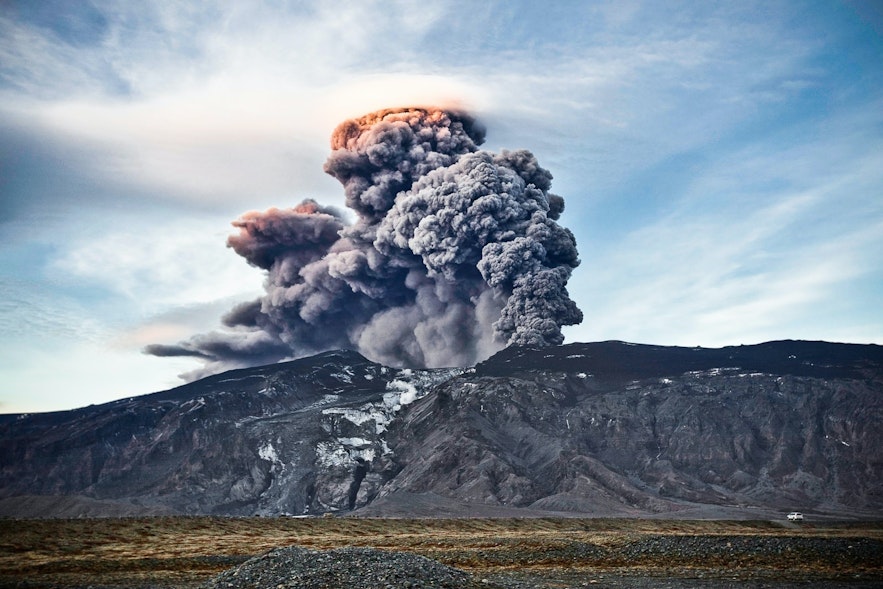
Most people are familiar with the Eyjafjallajokull volcano after its eruption in 2010 caused a massive disruption in European flights. It may have been a nuisance for many air travelers, but it was a relatively minor event compared to Iceland's most significant eruptions in the past.
The 2010 eruption was the largest one from the Eyjafjallajokull volcano to date. There had been a few previous eruptions but nothing of a similar scale.
A small but long eruption took place between 1821 and 1823. There were earlier eruptions in 1612-1613 and 920, but little is known about them.
The Eyjafjallajokull volcanic system is connected to the Katla volcanic system, meaning an eruption here usually triggers an eruption at Katla volcano within half a decade. So far, this has not been the case, although, as many sources will inform you, the Katla volcano is well overdue for a mighty eruption.
The Eyjafjallajokull volcano has become a popular attraction following its eruption in 2010. During the early days of the eruption, thousands of people made their way to Iceland to marvel at it, with many hopping on planes and helicopters for the best views.
The only volcano in the world with a magma chamber you can enter is the Thrihnukagigur volcano in Iceland. Dormant for about 4,000 years, there's no risk of an eruption here, making the tours as safe as they are mesmerizing.
Overall, the Thrihnukagigur volcano's magma chamber is about 5,300,000 cubic feet (150,000 cubic meters). It's entered by boarding a small mining lift at the entrance, which will lower you down 390 feet (120 meters) to the enormous cavern base. The bottom covers roughly the same amount of area as a football field, giving you plenty of space to explore. To put these numbers into perspective, the Statue of Liberty can easily fit inside the Thrihnukagigur volcano.
Besides its scale, the most impressive thing about this magma chamber is its vivid coloration. The lava within the chamber held many elements brought up from the Earth's mantle, and their vibrant shades are on full display. The chamber walls are dyed red, green, and yellow by iron, copper, and sulfur.
7. Grimsvotn: Iceland's Deadliest Volcano
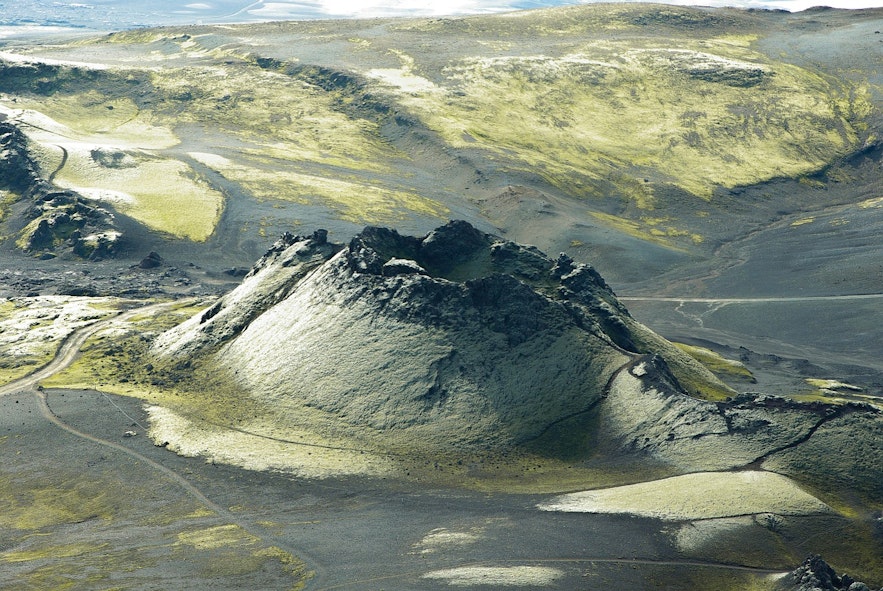
The Grimsvotn volcanic system is the most volatile volcanic system in Iceland. Located under the Vatnajokull glacier in the southeast, its craters are largely invisible beneath the ice. However, the resulting ash clouds are the most significant and most deadly when an eruption occurs.
The Laki volcano mentioned above, which caused worldwide havoc in 1783 and 1784, is part of this volcanic system.

Hekla volcano is one of the most famous and active volcanoes in Iceland. In the Middle Ages, it was known as "The Gateway to Hell" due to its regular and explosive eruptions. However, it's also one of Iceland's least predictable volcanoes, with intervals between eruptions lasting anywhere between nine and 121 years.
Since settlement, Hekla has caused havoc on many occasions, spewing out millions of tons of tephra at a time. Its most powerful eruption was in 1104, though eruptions in 1300, 1693, and 1845 were more destructive to livestock, buildings, and human life. The last eruption was on February 26, 2000, but it was relatively minor.
5. Katla Volcano: Eyjafjallajokull Volcano's Explosive Neighbor
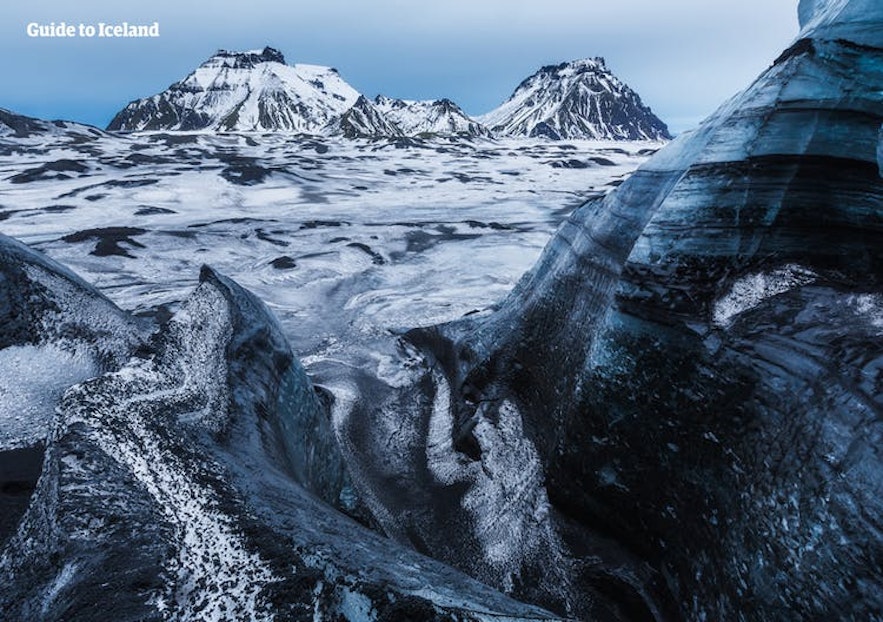
Katla volcano is one of Iceland's most powerful and explosive volcanoes. It has been rumbling for years, with scientists putting out warnings every few months to notify the public of increased activity and remind them that the volcano is long overdue for an eruption. Connected to the same volcanic system as the Eyjafjallajokull volcano, it usually goes off within a few years of its neighbor, with dramatic results.
The volcano sits beneath the Myrdalsjokull glacier in South Iceland and is notorious for its vast ash clouds and catastrophic jokulhlaups when it erupts.
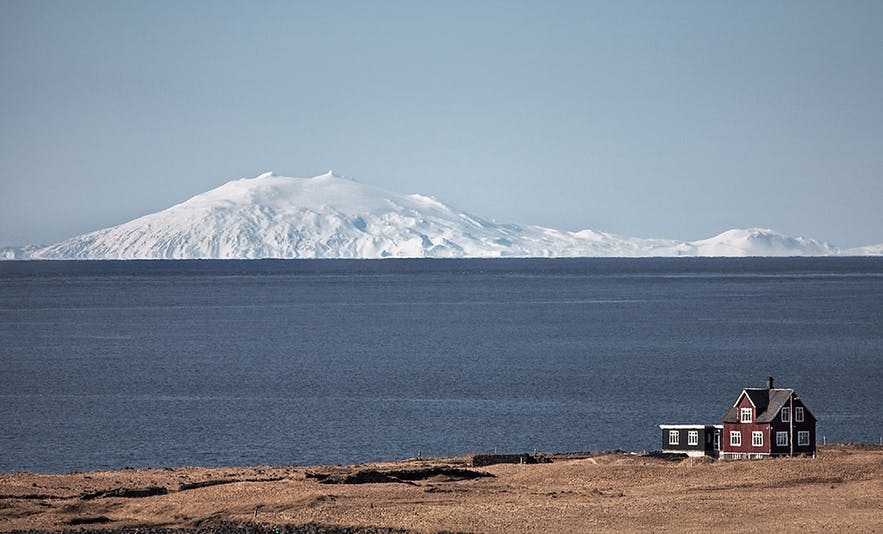
Snaefellsjokull volcano is one of Iceland's most visited and beloved volcanoes. Located on the Snaefellsnes peninsula's tip, it provides a dramatic backdrop to many sites in the area and is a national park in its own right because of its beauty.
Snaefellsjokull volcano is particularly notable for its role in culture. Many artists have been inspired by its beauty, most notably the writers Halldor Laxness, who used it as a significant setting in "Under the Glacier," and Jules Verne, who claimed it held a cave leading to the Earth's core in "A Journey to the Center of the Earth."
Perhaps more curiously, thousands believed that at midnight on November 5, 1992, aliens would use the volcano as a landing site. A huge crowd gathered, including camera crews from around the world, for what turned out to be a relatively uneventful night.
3. Askja: Iceland's Hot Spring Volcano
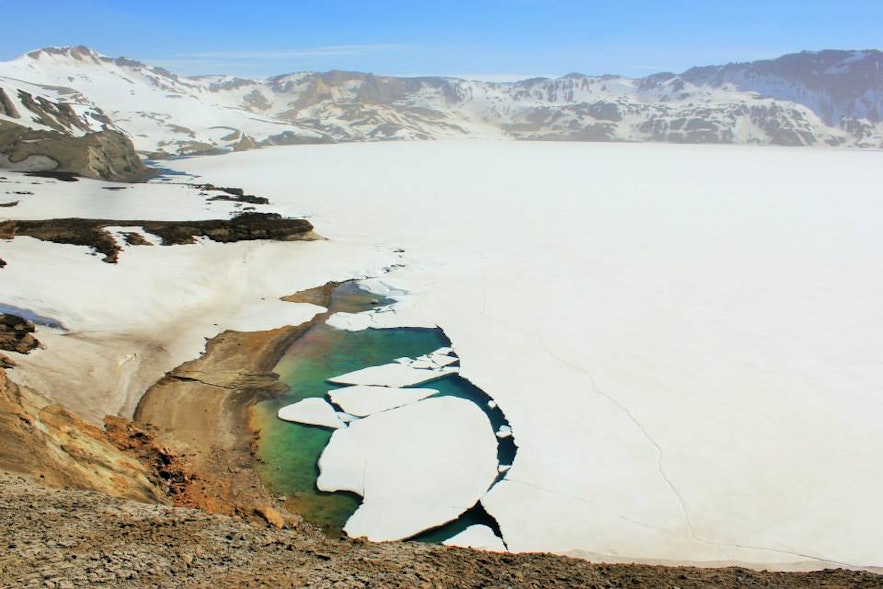
The Askja volcano was unknown until a massive eruption began in 1875. The ash was particularly heavy, poisoning the land and killing livestock across much of the country, especially in the Eastfjords. Its effects were felt as far away as Norway and Sweden. Like the 1784 Laki eruptions a century earlier, it prompted many Icelanders to emigrate to North America.
Today, Askja volcano is best known for the vast lake in the caldera formed in this eruption. Despite its altitude, it remained warm for years; today, it's frozen most of the year. However, a smaller geothermal lake in a nearby caldera, Viti , is warm enough for bathing.
- See also: The five best hot springs in Iceland .
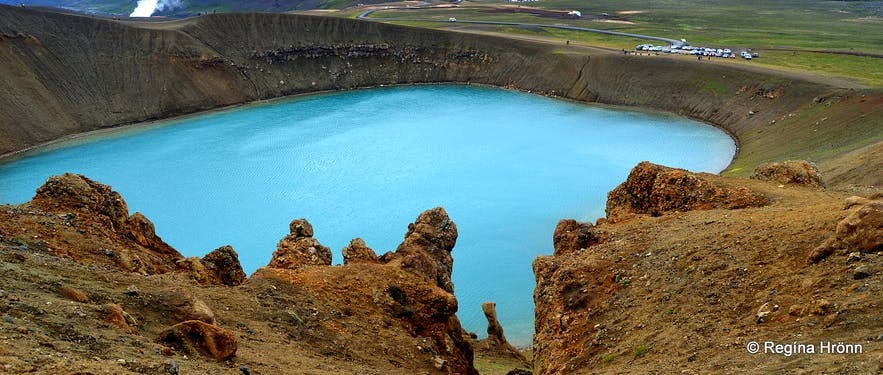
Krafla volcano is a particularly active volcano in North Iceland, having erupted 29 times since settlement. Nine of these eruptions occurred between 1975 and 1984. It's also renowned for its crater lake, also called Viti . The main difference between the two is that Viti in Krafla volcano is a cold lake (beautifully colored in emerald blue), while the Viti in Askja volcano is geothermally heated.
Krafla volcano is a popular attraction in the Lake Myvatn area, visited on many tours due to its proximity to the Namafjall geothermal area. It's 2,684-feet (818-meters) high at its highest peak, 1.25 miles (two kilometers) deep, and its caldera has a diameter of 6.2 miles (10 kilometers).
Top Myvatn Tours
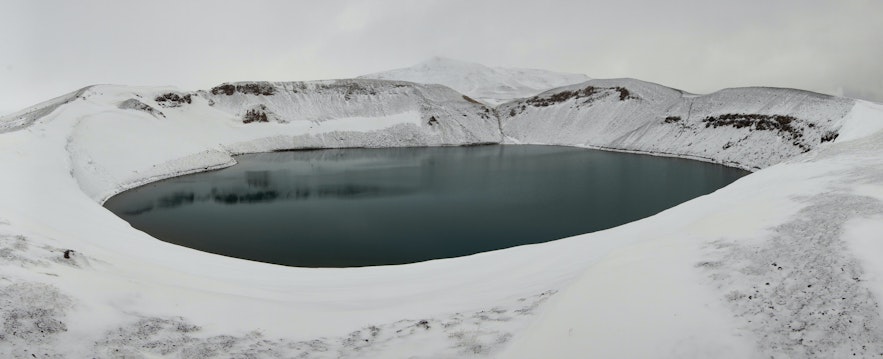
Another popular volcano in North Iceland is called Hverfjall or Hverfell (both are accepted names). It has not erupted for about 4,500 years, despite the volcanic activity around it.
Hverfjall volcano is well-loved because it's easy to hike. The crater is easily accessible from the Ring Road and is just 0.62 miles (one kilometer) in diameter. It only takes about an hour to walk the rim of this popular tephra cone, and it's situated right next to Lake Myvatn.
- To learn more about the 'Ice' in the Land of Fire and Ice, see this article on Glaciers in Iceland
You can watch a live stream of some of Iceland's volcanoes online from the comfort of your own home. Some of them are currently not live, so here are the ones that you can see right now:
- Hekla volcano
- Litli-Hrutur volcano
- Katla volcano
- Fagradalsfjall volcano
Even though you've just read about the destructive powers of Icelandic volcanoes, don't be put off from coming to the Land of Fire and Ice. Iceland's volcano tourism offers some of the most memorable experiences in the country. If you've explored Iceland's volcanoes before, what were your favorite experiences? Let us know in the comments below.
Popular articles

Guide to Iceland | The Story of the Leading Travel Agency of Iceland

The Complete Guide to the Midnight Sun in Iceland

Top 20 Most Beautiful Waterfalls in Iceland

22 Photos of the Aurora in Iceland

Mountains in Iceland
Other interesting articles.
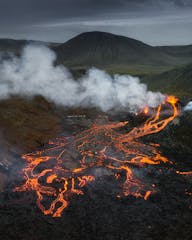
Complete Guide to the 2021 Volcanic Eruption in Geldingadalur Valley by Fagradalsfjall Volcano
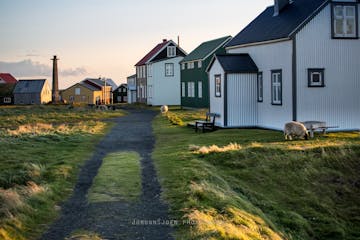
Top 5 Islands in Iceland

Birds in Iceland

Download Iceland’s biggest travel marketplace to your phone to manage your entire trip in one place
Scan this QR code with your phone camera and press the link that appears to add Iceland’s biggest travel marketplace into your pocket. Enter your phone number or email address to receive an SMS or email with the download link.
Top things to do in Iceland
Book your complete trip with the best companies only

Explore an Ice Cave

Visit a Live Volcano

Find the Northern Lights

Visit the Blue Lagoon

Go on a Road Trip

Do the Golden Circle

See the Glacier Lagoon

South Coast Tours
Where to See Active Volcanoes in Hawaii
Volcano hunters descend upon Hawaii for its active lava flows. In fact, The Big Island’s most active volcano -- Kilauea -- flows with such power that it grows the island by 40 acres per year. And it’s an odd thing to watch the flow. It kills everything in its path before pouring into the ocean to give birth to more land.
It’s this beautiful ability to both create and destroy that entrances visitors. The destructive nature of lava can be felt yards away from the flow. The heat is simply too unbearable to get close to the molten rock, so don’t count on that lava selfie, but the unbelievable power of it all makes for an attraction not to be missed.
The easiest, most accessible and reliable volcano to visit is Kilauea inside Volcanoes National Park on The Big Island, but Hawaii has five other active volcanoes. So, you can choose to take the path less traveled to get your volcano fix during your Hawaiian vacation if the timing is right. But, no matter which volcano you choose to chase, it makes for a once-in-a-lifetime experience.
Kilauea -- Hawaii’s Youngest, Strongest and Most Active Volcano --Inside Volcanoes National Park
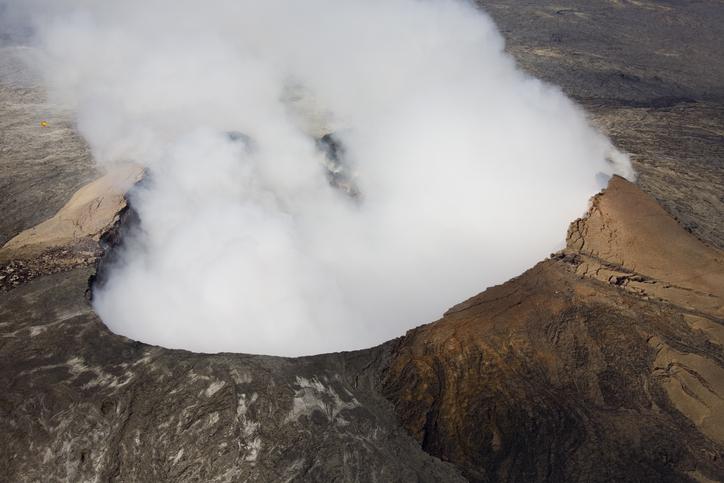
Halema’uma’u Crater, inside of Volcanoes National Park, was perceptually filled with a lake of lava. You were allowed to watch the bubbling molten rock from a safe distance at a viewing center, and the center even opened its doors after dark to give you a spectacular glowing show.
Flows of lava were commonly seen pouring out of Puʻu ʻŌʻō crater inside the park, as well. These two craters were the most reliable viewpoints for flowing lava in all of Hawaii. Unfortunately, in May of 2018, eruptions changed the landscape of the park and drained the craters. Currently, there is no more lava flowing in Volcanoes National Park.
But Park Rangers and other officials remain optimistic because this isn’t the first time that the craters have drained. A similar eruption completely drained Halema’uma’u Crater back in 1929, and the lava returned a short period later.
Keep up to date with this website to get more information about the flows of lava inside Volcanoes National Park. But, even if there is no lava flowing inside the park, the Volcano is a great place to visit. It contains massive volcanic craters that are now stable, so you can hike down inside of them. Essentially, you’ll be walking around the very top of a long-dead volcano. And the trails all have interesting names, like “Devastation Trail.” It’s a great way to see the fresh earthen scars left by the power of mother nature.
The visitors center is also a great place to learn about volcanic activity on the islands. You’ll learn a lot, and you can always ask the Park Rangers inside about the flow of lava on the island. Kilauea has stopped its activity inside the park, but it hasn’t stopped activity altogether. That means lava is flowing somewhere on the island, and the Park Rangers will have all that information on hand. And if you’re lucky, you can hike up to the new lava flow.
Kilauea Lava Flow
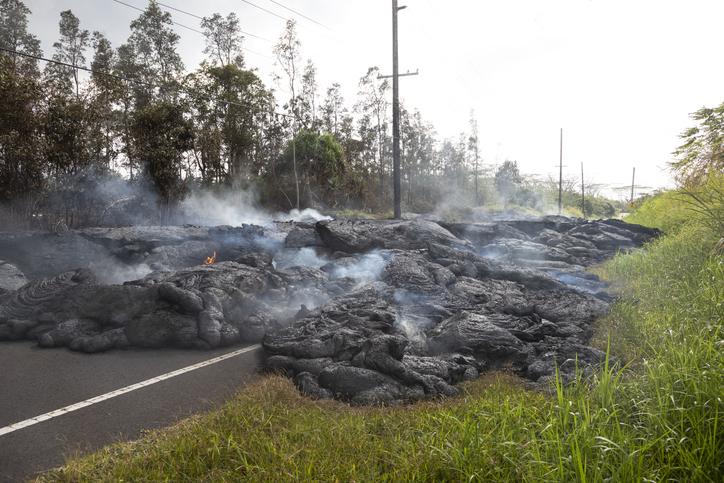
You can see that lava flow in one of three ways. First, you can find the flow yourself and hike up to it. Secondly, you can hire a tour guide to be taken to the lava flow. Or, thirdly, you can jump on a boat that takes you up to the lava flow as it pours into the ocean somewhere on the southeast coast.
Seeing Kilauea’s Flows Yourself
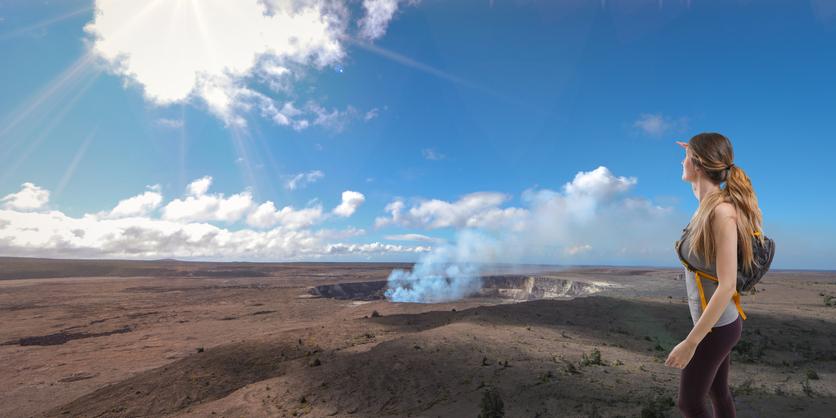
The Lower East Rift Zone is a vast field of sharp volcanic rock. There’s a road carved into this volcanic rock that takes you past some houses built into the inhospitable area. Some of the houses have been destroyed, but the entirety of the road is not open to the public. You’ll have to park your car and continue on foot, but you can usually find a vendor renting off-road bikes.
From here, you’ll have to hump yourself down to the lava flow. It’s black as far as the eye can see, and the tropical sun reflects heavily off the glassy rock, so make sure to pack sunscreen, a hat and plenty of water. But, sooner or later, your hard work will pay off. You’ll run into the flow of lava as it makes its way down to the ocean.
If you’re lucky, the lava flow will be like a river on the surface, but most of the time the lava flows underneath the surface. You’ll only be able to see it through cracks in the surface rock. But don’t worry about walking over the lava flow. The volcanic rock field is cordoned off to keep visitors safe.
You’ll also have to be very careful near the ocean. The lava creates a hissing cloud of steam and glass that is toxic to inhale. Again, state officials are very good at regulating foot traffic around the lava, but you should still be careful to keep your distance from the plume.
State officials are working hard to create a more permanent lava viewing platform after the most recent eruption changed the Big Island’s landscape. Stay tuned to this site for more information about Kilauea lava viewing as it becomes available.
Kilauea Tour Guide
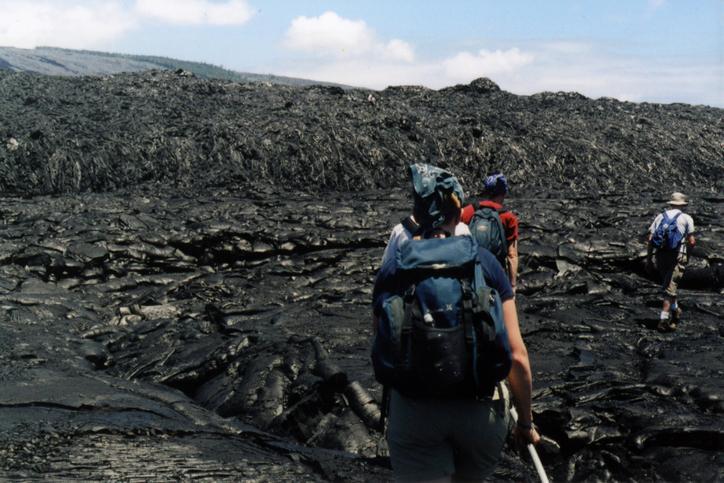
After all, the flows are constantly changing. So, no matter how well you plan ahead of time, you’ll have to do research the day you want to go see the lava. Relying on an expert will save you that research time, and time is the most valuable resource you have on the Hawaiian islands.
An expert will also be able to take you right to the hot spot. Pun intended. You won’t have to go venturing off into a volcano field on foot to find it yourself. So, a guide can save you time and effort. And it’s really hot out there on the black rocks.
Kilauea By Boat
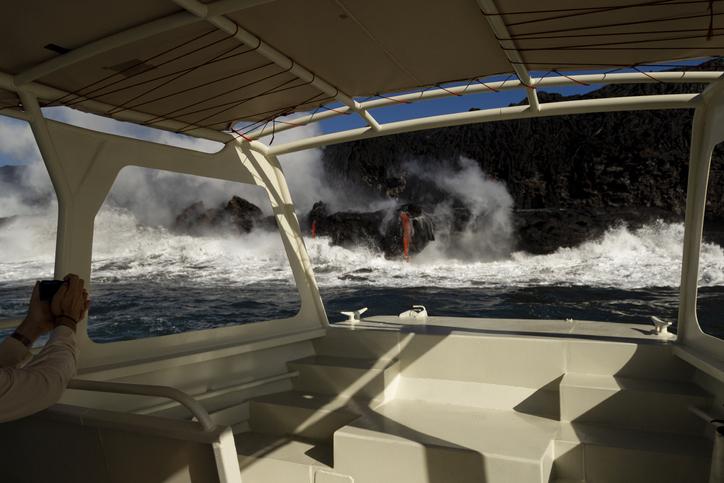
You don’t have to worry about getting too close or inhaling the toxic fumes because you are under the guidance of an experienced tour guide. That means you’ll get as close as humanly possible to the lava itself which makes for a stunning social media pic. A boat also takes all the guesswork and effort out of the equation. You just sit back and enjoy the destructive yet life-giving molten rock.
Hawaii’s Five Other Active Volcanoes
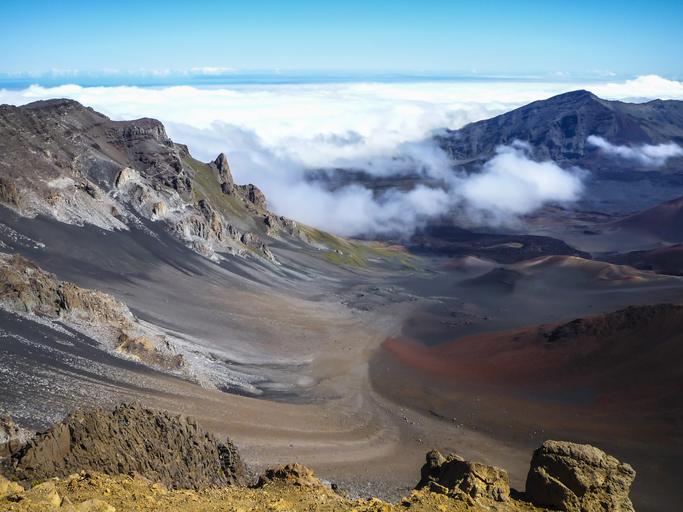
All of the Hawaiian islands have been formed by this activity, but most of the island’s volcanoes have become dormant. There is no volcanic activity on Kauai, Oahu, Molokai or Lanai. That means these islands, like many before them, are now eroding into the ocean. And, one day, they will perish altogether.
Hawaii’s four other active volcanoes are all on the Big Island. It’s fitting as the Big Island continues to grow by 40 acres per year, and a visit to Hawaii will illustrate the youth of the island. Nearly the entire western side of the island is a lava rock field where vegetation is yet to grow, and many of the island’s beaches are black sand. That means the lava rock has been pummeled by the ocean into sharp little pieces, but the beach has not yet had time to accumulate soft white sand.
The Big Island’s volcanoes include Mauna Kea , Mauna Loa, Hualalai, and Loihi. The massive mountains that mark the Big Island are still active volcanoes, though the activity is fairly rare. Mauna Loa last erupted in 1984, and the eruption lasted for 22 days. Mauna Kea has erupted about every six years and is the largest volcano on earth. Predicting lava flow from these 13,000-foot peaks is near impossible, so planning a visit around their eruptions would have to be last-minute.
Hualalai is to Mauna Loa’s northwest. It’s technically still active, but its slopes have been covered by Mauna Loa’s eruptions over the centuries, and it last erupted in 1801. And lonely Loihi can be found just south of Kilauea. Unfortunately, the volcano is completely underwater.
Haleakala National Park
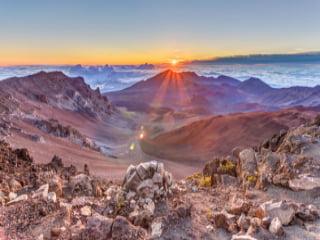
The crater at the top of the mountain is absolutely gorgeous, and it’s still technically active as a volcano. But don’t worry about an eruption. The last one took place between 1480 and 1600.
Haleakala is not a reliable place to catch a glimpse of molten rock, but it is a stunningly beautiful place nonetheless. The sleepy crater is a moonscape of colorful volcanic rock where oranges, purples, and reds glow at sunset or sunrise. And, during your visit, you walk around inside what is still technically an active volcano which is quite a brag-worthy experience.
As an added bonus, you can join a tour up to the crater. After enjoying the otherworldly landscape, you’ll be put on a bike to cruise down the long, slow slopes of the mountain back to town. It’s a refreshing, beautiful and exhilarating experience.
Can You Visit During An Eruption?
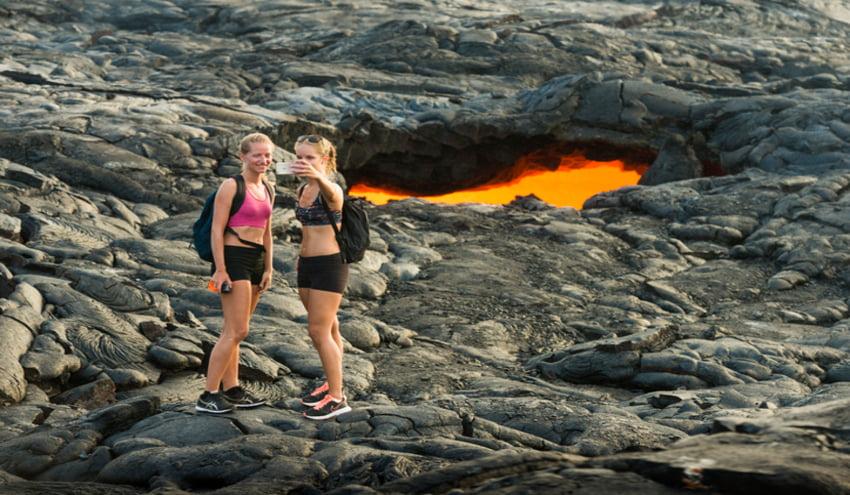
The main hazards during an eruption are the newly formed lava flows, which can tear through small towns, and air pollution. The air pollution is called volcanic fog, or “vog.” This vog can significantly affect the air quality on all of the Hawaiian islands.
Vog has a very peculiar look. It appears to be smog, but it carries a distinctive red hue. This shade of red can make the sun appear to be red, as well. And, of course, it carries a burned smell on the humid air.
Vog will carry downwind from the eruption, and the Big Island has distinctive east to northeast wind patterns. So the foggiest areas on the island will be to the south or southwest of the eruption site.
This air pollution can make it difficult or impossible for planes to land or take off from The Big Island if the eruption is large enough. Although, these vog groundings are rare. Kilauea’s last eruption, in May of 2018, put airlines on “red alert” but did not disrupt air traffic. You have to look all the way back to 2010 when a volcano erupted in Iceland which grounded planes throughout Europe for two weeks to see the last time vog affected air traffic.
However, the air pollution caused by volcanic eruption can cause some health problems. Older adults, young children, expectant mothers, people with asthma and cardiovascular disease are cautioned to stay away from voggy areas. The vog can increase your chances of respiratory ailments while causing a scratchy throat, eye, nose and skin irritation, coughing, phlegm, chest tightness, shortness of breath, fatigue, and dizziness.
But the Big Island is big. You’ll be able to avoid the affected areas quite easily while enjoying some clean air. The eruption will just make some of the island off-limits during your stay.
Related Pages
If you've never been to Hawaii before... go to Oahu or Maui. These well-trafficked islands will help you get your bearings in the Aloha ...
Which Island Should I Visit In Hawaii?
App tours give you access to the best guided tours — complete with activities, interesting trivia, and recommended stops.
Shaka Guide versus GyPSy Guide: Your Virtual Hawaiian Travel Experience
And Hawaii is a quirky cultural mashup of Native, Asian, Portuguese and American cultures. You'll find strange collisions of cuisine on the ...
20 Coolest Facts You Didn't Know About Hawaii
The Big Island has five active volcanoes. The two most noticeable are Mauna Kea and Mauna Loa simply due to their size.
The Ultimate Big Island Travel Guide
This is the perfect place for locals and tourists to grab some fresh seafood, a perfectly cooked steak, a refreshing salad or a filling ...
Top 10 Restaurants on The Big Island
The Road to Hana is FILLED with one incredible distraction after another! Waterfalls and banyan trees, bamboo forests and black sand beaches.
Road to Hana
Need help planning your vacation? We have great tips for planning a vacation to Hawaii. There are many things to consider and we're here to help!
Tips to Help you Plan a Vacation to Hawaii
The state of Hawaii features diverse and stunning landscapes spread over a myriad of mid-Pacific islands. And while you can always find ...
20 Interesting Facts About Hawaii
In the same manner, even if you're already well-traveled, there are things that you must know and must NOT DO to avoid similar embarrassments while in...
40 Must NOT Be Done Things While in Hawaii
Hawaii is one of the hottest destinations for vacations, honeymoons, and business trips, but what is there to do, once you get there?
Top 10 things to do on The Big Island
Mauna Kea, Mauna Loa and Kilauea can erupt at any moment to send volcanic ash into the sky.
Are There Any Safety or Health Hazards in Hawaii?
Subscribe to get our itinerary travel booklet., hawaiian planner provide cool tips, freebies and other useful resources., we use cookies in the delivery of our online services..
To learn about the cookies we use and information about your preferences and opt-out choices, please review our Privacy Policy here . Our Terms and Conditions, which contain an arbitration provision, may be viewed here . By using our application you agree to our Terms and Conditions and Privacy Policy , including the transfer of your personal data to the United States from your country of residence (if different).
Already have an account?
Sign up for free account.
Login with Facebook or Google
Don't have an account?
Welcome back sign in to hawaiian planner.
Login with Facebook

Maui Volcanoes: The Ultimate Guide
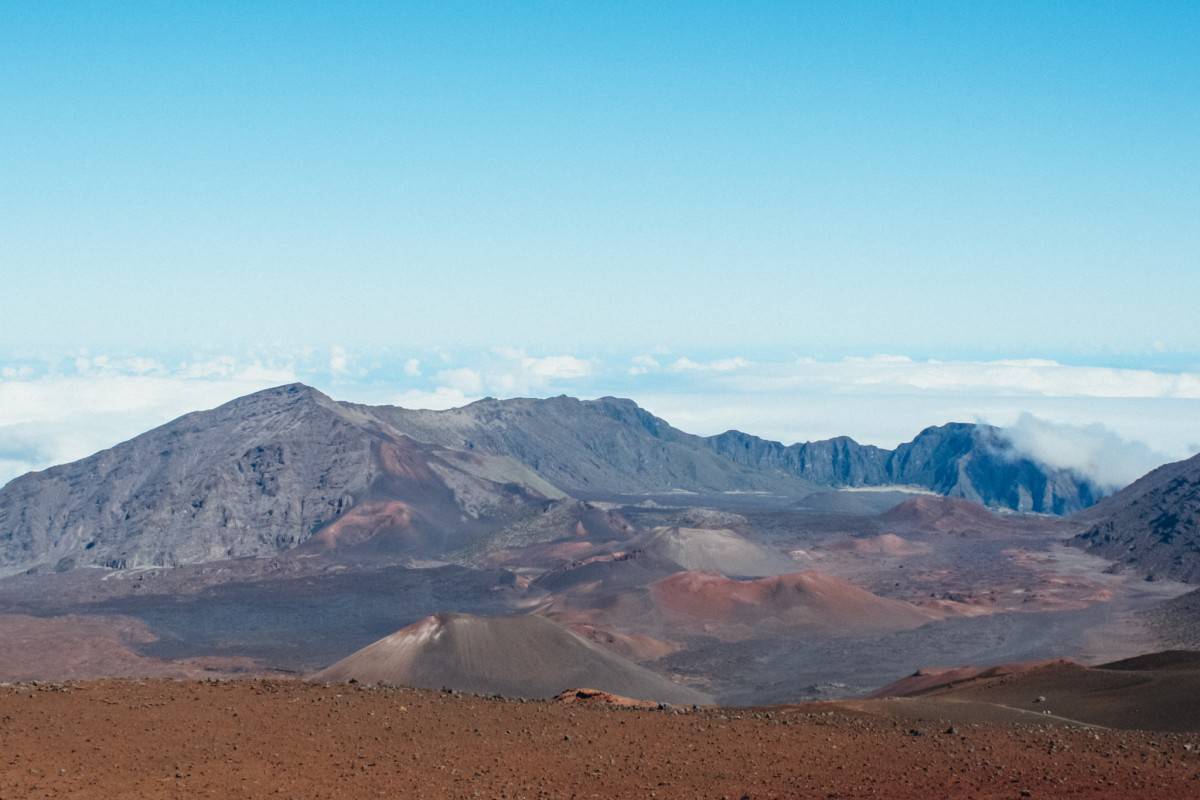
Disclosure: This post may contain affiliate links, meaning if you decide to make a purchase through my links we may earn a commission at no additional cost to you. Read about our affiliate policies here .
Share with your friends!
Maui erupted out of the sea from two volcanoes over a million years ago. Today, no trip to Maui is complete without seeing the summit of the dormant volcano Haleakala “House of the Sun.”
Maui is a volcanic island made from 2 volcanos. The East Maui volcano, known as Haleakala, had its recent eruptions between 1480 and 1600. The eroded West Maui volcano, known as Mauna Kahawai or West Maui Mountains, last erupted 320,000 years ago. Haleakala is in a non-eruptive stage .
You won’t find lava erupting out of Maui’s volcanos on your visit to the Valley Isle. You won’t be able to miss seeing them though. On approach to Maui’s Kahului Airport, you will navigate between these giant, sleeping volcanos.
Learn about Maui volcanic geology, Hawaiian folklore, and how to best see these ancient volcanoes before you set off to the volcanic island of Maui.
Maui: A Volcanic Island
Wherever you are on Maui, you can see one of the two volcanoes. Haleakala volcano makes up 75 percent of the Hawaiian Island of Maui. Mauna Kahalawai volcano makes up the remaining 25 percent.
Haleakala and Mauna Kahalawai are not actively erupting volcanoes. Make sure to tell your kids that they won’t see lava erupting from Maui’s volcanoes. At least not anytime soon.
Maui volcanoes are safe to visit as the chance of an eruption is very low per the US Geological Survey.
Haleakala is considered an active volcano by the US Geological Survey (USGS). USGS Volcano Warning Scheme for the United States , the Volcano Alert Level for Haleakala is “normal”. A Normal status means the volcano’s activity is in a non-eruptive phase.
The West Maui volcano of Mauna Kahalawai is no longer active.
You have to fly to the Island of Hawaii, the Big Island, to see active volcanoes straight out of the movies. Visit Hawai’i Volcanoes National Park to witness the active Kilauea and Mauna Loa volcanoes. Two of the most active volcanoes on the planet.
Check the national park website for the latest status of their eruptions and activity when planning your visit.
The lack of steam plumes and lava oozing down the mountain doesn’t mean Maui’s volcanoes are not jaw-dropping. The summit of Haleakala is 10,023 feet, making it the 10th highest mountain in America and 85th in the world. The summit is usually hidden above the clouds.

Over 1 million visitors a year visit Haleakala through Haleakala National Park. Seeing the sunrise from the summit of Haleakala is a Maui must-see activity. Haleakala’s stark volcanic landscape is a juxtaposition to the sub-tropical rainforest covering the volcano.
Note, if you’re heading up to Haleakala National Park check out our Things to Do in Upcountry Maui and our favorite Maui horseback riding experience .
The West Maui volcano is equally beautiful but more as tropical mountains with deep valleys cut through them.
The West Maui volcano or Mauna Kahalawai is referred to as the West Maui Mountains. It is a massive shield volcano that has eroded over the eons to resemble more of a mountain range than a towering volcano.
The summit of Mauna Kahalawai is 5,788 feet.
I like to hike the lush, jungle terrain of this long-dormant volcano. Mauna Kahalawai is heavily eroded due to the warm winds dropping their water on the high, cool mountains.
This is why Mauna Kahalawai translates in Hawaiian to Holding House of Water.
Maui is called the Valley Isle because a valley separates these two massive volcanoes. How did these Maui volcanoes come to be in the middle of the Pacific Ocean, far from the Ring of Fire?
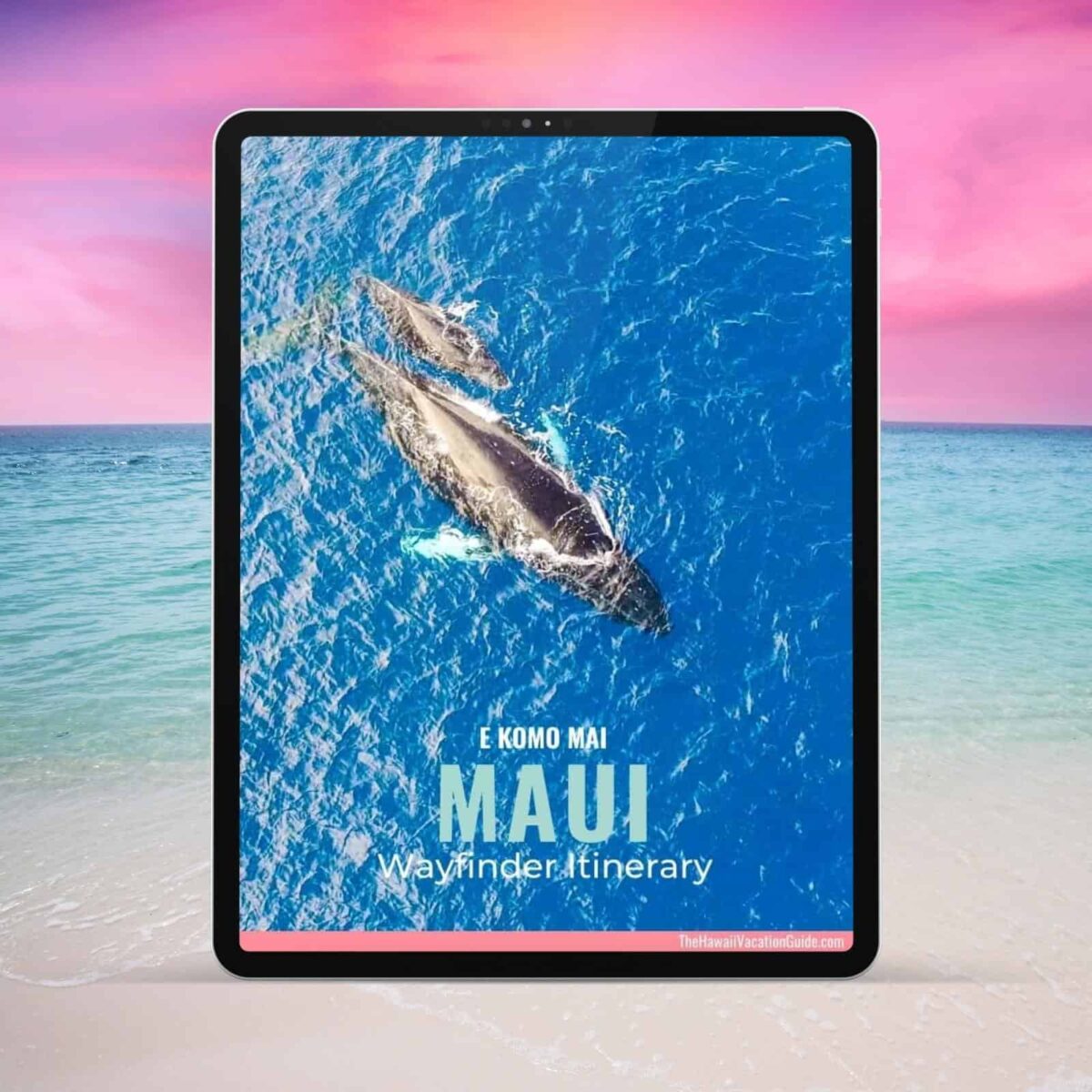
Maui Wayfinder Itinerary
Get the maui itinerary.
The step-by-step itinerary takes you to all the best beaches, snorkeling spots, restaurants, and sights. You’ll get six carefully planned excursion days to help you see the can’t miss stops no matter how limited your time is.
Get all the details on our itinerary and download it for a memorable and easily planned trip to Maui.
Maui’s Volcanic Geology
The Hawaiian Islands are unique in so many ways. So it is no surprise that they are unique as volcanoes go.
Most volcanoes are located where tectonic plates come together. The largest volcanic area is the Ring of Fire around the Pacific Ocean. The Hawaiian Islands are unique as they are formed from a volcanic hotspot. They are far from the Ring of Fire.
The hotspot doesn’t move, the ocean floor drifts.
The hotspot erupts magma into the ocean. The volcano grows until it breaks the surface of the ocean to create an island. Maui broke the surface over 1.1 million years ago .
Maui is the second youngest volcanic island in the Hawaii archipelago with Kauai being the oldest at around 5 million years old.
As the ocean crust moves, the volcanic island moves farther away from the hotspot causing fewer eruptions and finally ceasing to erupt all together. Haleakala is in this camp of volcanoes.
Maui’s Haleakala volcano is still active but it is slightly farther from the hotspot which is now focused under the Big Island.
The volcanic island of Maui is part of the Hawaiian-Emperor seamount chain . The chain stretches from Siberia to the Lo’ihi seamount. The youngest of this volcanic island chain is the Hawaiian Islands.
The Lo’ihi seamount will be a Hawaiian island in about 200,000 years . Be ready to plant your flag.
While Maui isn’t as volcanically active as the Island of Hawaii with its 3 active volcanoes, Haleakala still creates wonder and amazement in all who visit and hear its tales.

The Last Volcanic Eruption on Maui
While the Maui volcanoes are not erupting and will most likely not erupt during your holiday, they are well worth visiting.
Haleakala’s Last Eruption
The last eruption on Maui was Haleakala in the 17th century or earlier based on carbon dating.
It was thought Haleakala last erupted in 1790. This inaccurate date was based on maps made during the voyages of Captains La Perouse and George Vancouver.
Haleakala has a long history of eruptions. At least ten eruptions have occurred in the past 1,000 years. Haleakala has a high probability of erupting in the future based on its recent activity.
Rest assured that it will most likely not erupt during your vacation.

Mauna Kahalawai Volcano’s Last Eruption
The West Maui volcano of Mauna Kahalawai last erupted 320,000 years ago.
Over the thousands of centuries of inactivity, the shield volcano no longer resembles a volcano.
Heavy rains have eroded the shield shape into deep valleys and tall mountains.
When staying on the west side of Maui in Lahaina or Ka’anapali, your backdrop is the lush mountains of this long ago volcano. They make for amazing sunrises.
The West Maui volcano is not considered a threat by the USGS. The USGS does not track the West Maui volcano in their Volcano Hazards Program.
Related articles:
- 9 Things Maui is Known For (You Won’t Want to Miss Them)
- How Many Days Should You Spend in Maui? The Ideal Plan
Maui Volcano Tours
Look down onto the clouds from the summit of Haleakala. Go snorkeling in the morning and have a snowball fight in the afternoon from the summit, if visiting Maui in the winter.
A trip to the top of Haleakala is perfect for families who want their kids to experience a volcano and for adventurers who want to hike the crater.
The valleys of Mauna Kahalawai are hard to miss. The mountains not only make West Maui a beautiful place to visit, but they’re a playground of day hikes and waterfalls.
Here are the best ways to explore these Maui volcanoes. See our Haleakala Sunrise video below for three ways to visit the volcano for sunrise.
If a guided sunrise tour sounds right for you, use promo code HVG10 at checkout to go up with Valley Isle Excursions. See our Haleakala Guided Sunrise Tour for more information and to book with our promo code.
How To Get To Haleakala
To reach the summit of Haleakala, allow a minimum of 2-hours to drive from the most popular places to stay on Maui, Wailea on the southside and Lahaina and Kaanapali on the west side. If you are further up the coast from Lahaina in Kapalua or Napili, then allow 2.5 hours for the trip.
The drive to the top is part of the adventure. Stop in the local Maui upcountry towns as you drive up the Haleakala Highway. Short detours off the highway will drop you into Makawao and Kula.
Makawao is a ranching community known for its cowboys and artists. Kula is farm country where a coffee plantation tour or visiting the lavender fields is a must.
As you near the summit the road becomes all switchbacks as you climb to over 10,000 feet. The road is in excellent condition and is very safe to drive.
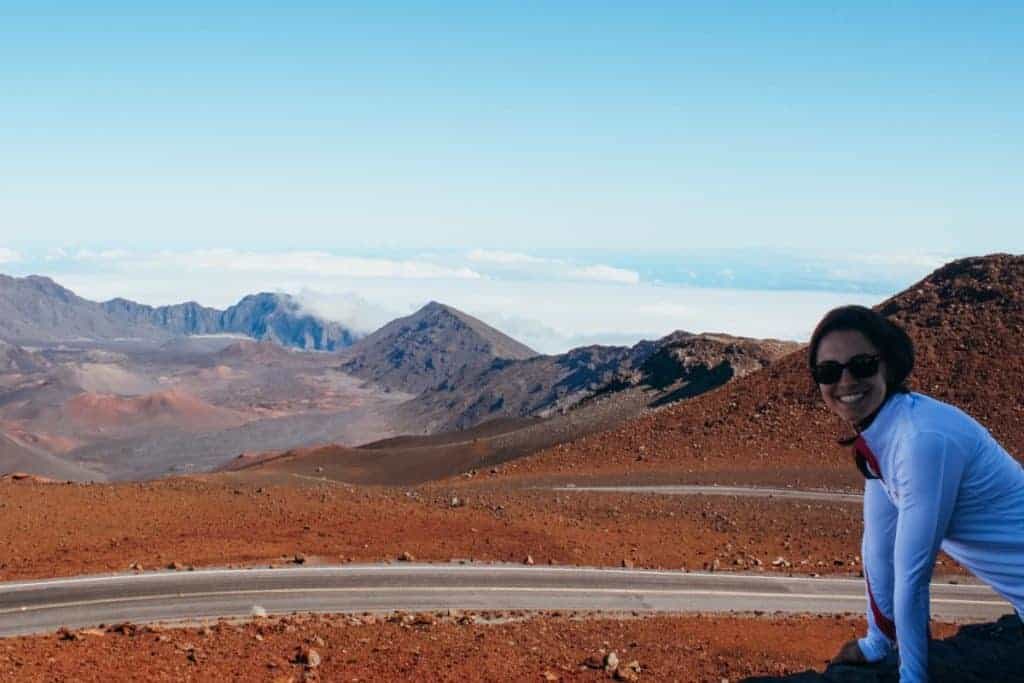
Sunrise and Sunset on a Volcano
Watch the sunrise over the crater walls of Haleakala. To do this requires waking up at 2:30 in the morning and a reservation.
Book a reservation with the National Park Service Sunrise Watch before your trip. The slots open up 60 days in advance and they go fast. A small number of tickets are released 2 days in advance. These are worth checking if advanced reservations were full during your vacation.
There is no reservation required to watch the sunset from the crater.
If you can’t make a reservation through the National Park Service, you can schedule a sunrise tour with a tour operator.
Most of these tours pick you up at your hotel super early and drive you to the summit. You get a front-row seat as the sun crests the crater. On the way back to your hotel they provide breakfast at a local Maui spot.
Check out our favorite Haleakala Sunrise Tour here .
Hiking and Camping on Haleakala
Get into the adventure of Maui’s volcanoes by hiking and camping in Haleakala National Park.
You can hike directly into the crater of Haleakala. The most popular trail is the Sliding Sands trail, officially named Keonehe’ehe’s. The trail is grueling not for its distance, 4 miles, but for the 2,800 vertical feet drop into the summit.
Shorter and less grueling hikes are available. You can choose to walk half-way down Sliding Sands to get sweeping views of the Pu’u O Pele cinder cone. At the park entrance, there is a 0.7-mile loop hike through dense pine forest. This trail is at Hosmer’s Grove.
Haleakala National Park provides wilderness camping. There are 2 campsites in the park for backcountry hikers. Permits are on a first-come, first-served basis at the Headquarters Visitor Center. There are also 3 cabins in the crater. Check out Haleakala Wilderness Camping for more information.

Hiking the West Maui Volcano
The most popular and easiest way to get into the West Maui volcano is the ‘ Iao Valley State Park .
Hike into one of the wettest places on earth. The ‘Iao Valley gets an average of over an inch of rain a day at its summit. Don’t be deterred, as visiting the valley and the ancient volcanic mountains is a must-see for Maui.

The valley is sacred and was forbidden (kapu) to all but Hawai’ian royalty.
The State Park has a paved trail from the parking lot to the observation deck. 0.4 miles roundtrip with a 90-foot ascent. The observation deck provides picture-postcard shots of the ‘Iao Needle. The ‘Iao Needle, the main attraction is a 1,200-foot high peak from the valley floor. That is taller than the Eiffel tower.
Waihe’e Ridge Trail is a true hike. Waihe’e Ridge Trail is on the northside of the West Maui Mountains. A 4-mile trail along a ridgeline is a challenging trail but you are rewarded with a waterfall.
Maui Volcano Facts
- In Hawaiian folklore, the demigod Maui’s grandmother lived in the crater of Haleakala. She helped Maui capture the sun and slow its journey across the sky in order to lengthen the day.
- Early Hawaiians only called the depression Haleakala , not the entire volcanic mountain.
- Both the East Maui and West Maui volcanoes are shield volcanoes. Shield volcanoes are created by lava erupting and flowing in all directions. Over time, the flow pattern creates a shield like a warrior’s shield.
- Haleakala’s elevation is 10, 023 feet
- Mauna Kahalawai (West Maui volcano) elevation is 5,788 feet.
- The peak of the West Maui volcano is called Pu’u Kukui.
- Pu’u Kukui Watershed Preserve is the largest private nature preserve in the State of Hawai’i. It is managed by the Maui Land and Pineapple Company.
- The West Maui volcano was formed by at least three major series of volcanic eruptions.
- Haleakala’s crater was not formed by volcanic activity. It isn’t a caldera that is formed when the summit of a volcano collapses. It is thought the depression was formed when the headwalls of two large valleys came together at the summit of the volcano.
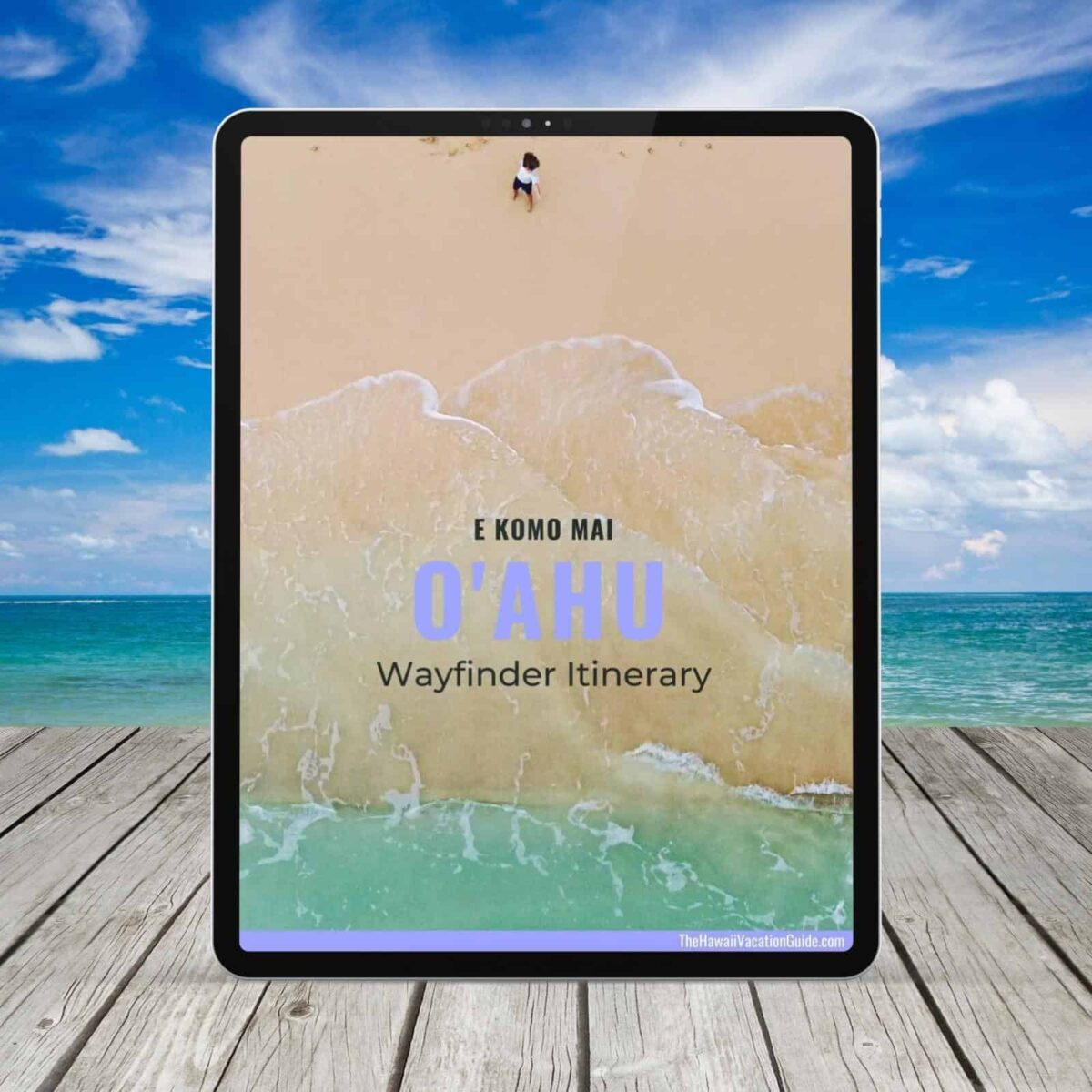
Oahu Wayfinder Itinerary
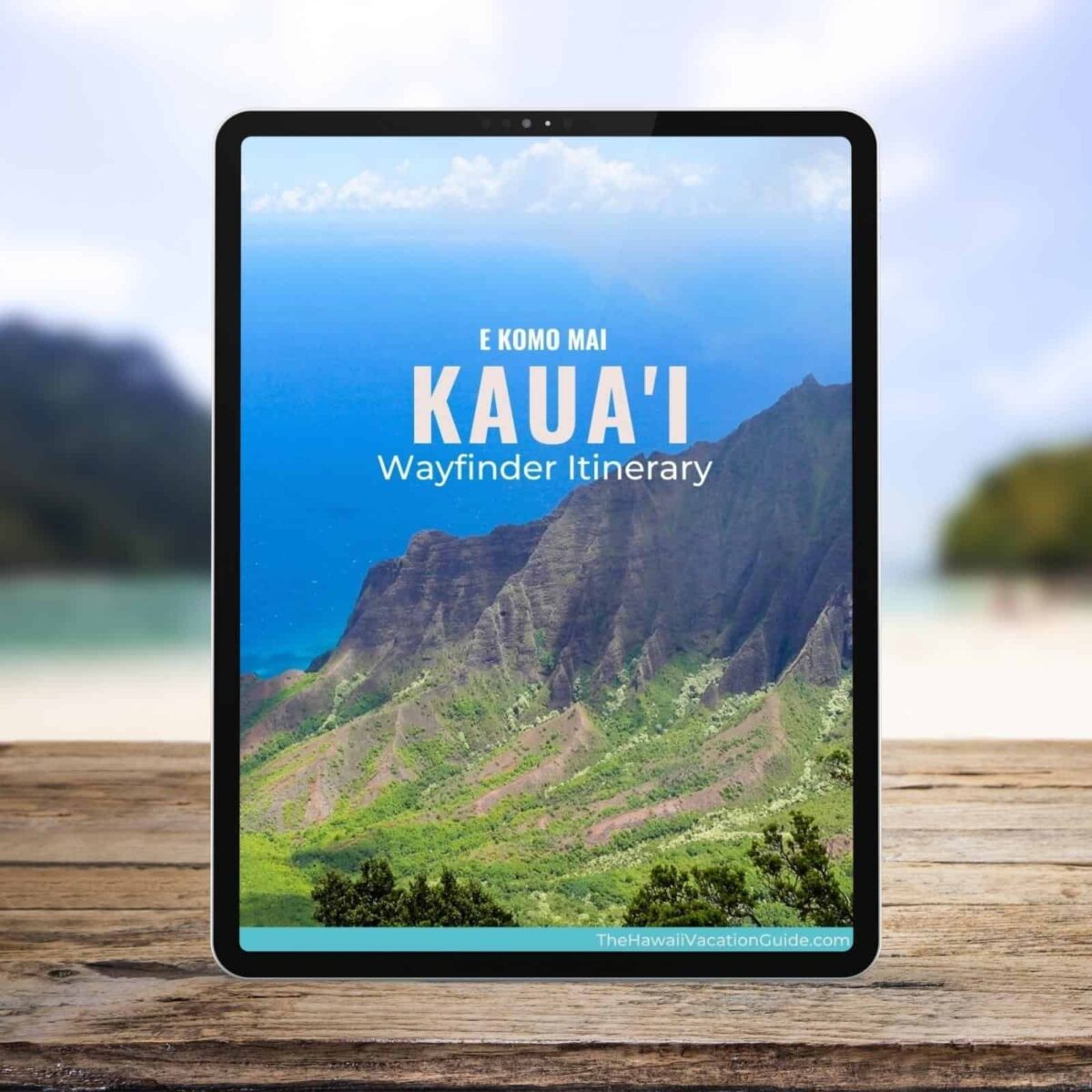
Kauai Wayfinder Itinerary
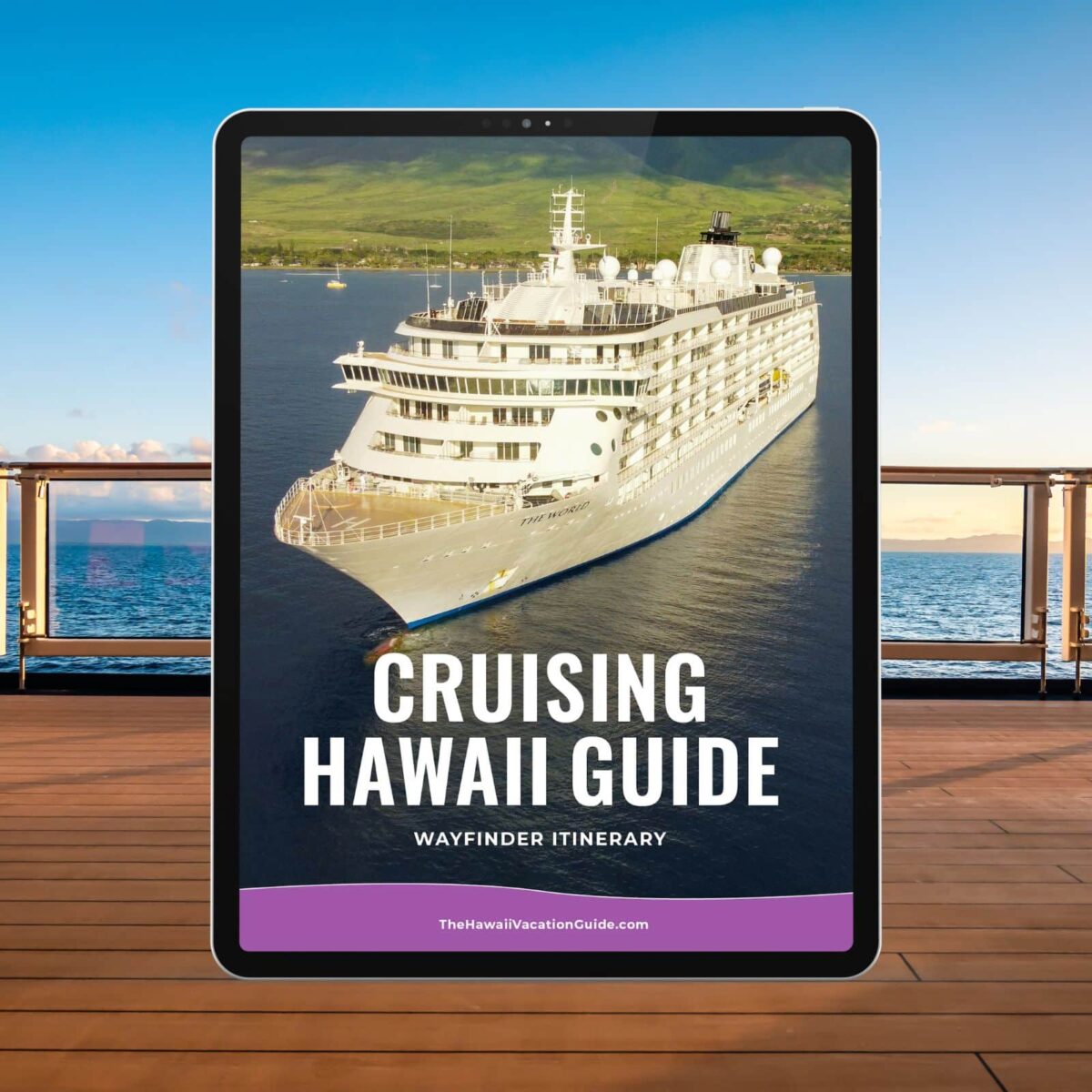
Cruising Hawaii Guide
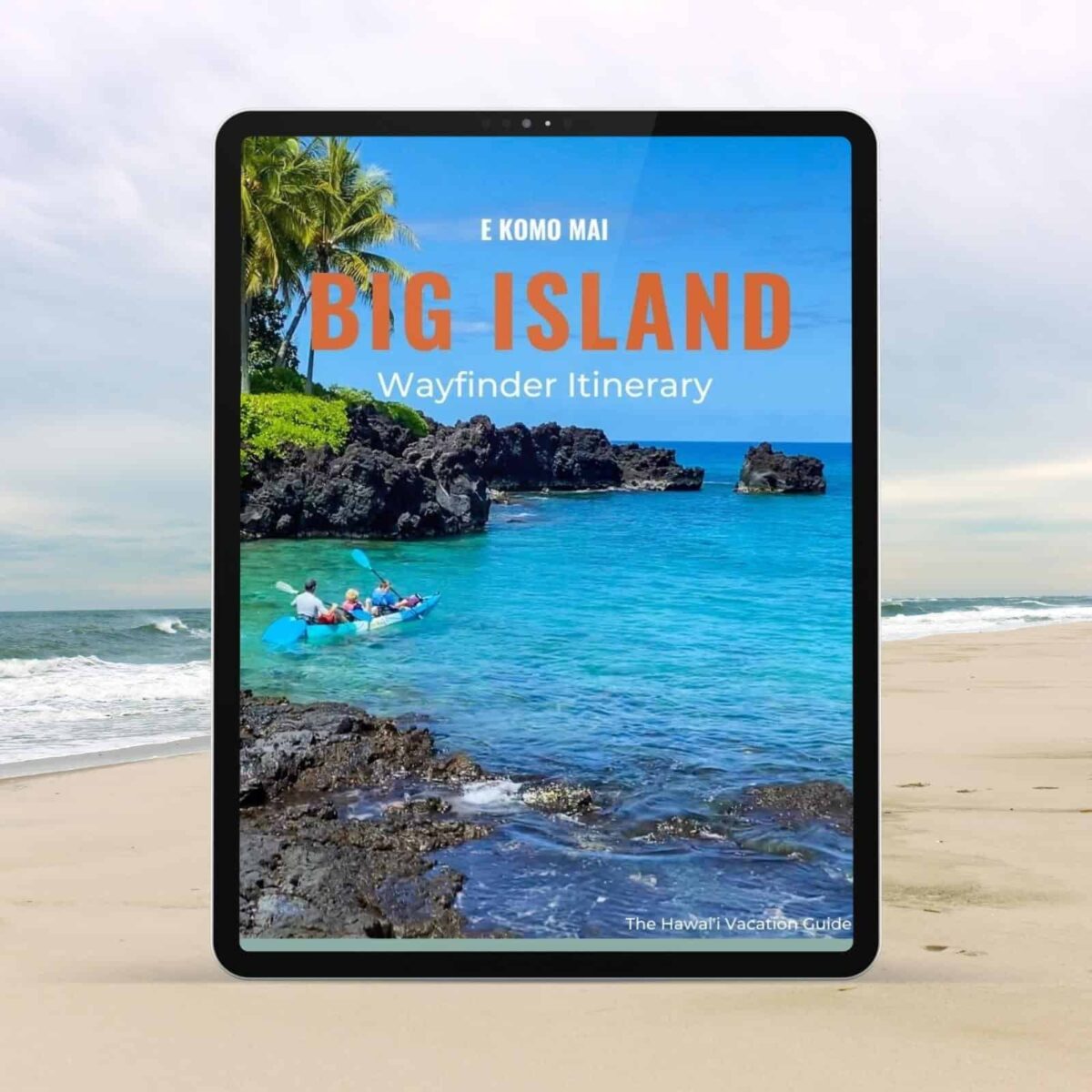
Big Island Wayfinder Itinerary
Thanks for reading The Hawaii Vacation Guide! I'm the co-founder, with my wife Erica, of the best Hawaii travel guide on the internet in our biased opinions. We enjoy traveling throughout Hawaii after living on Maui and Oahu. We share our adventures, travel tips and resources, and honest reviews so you can easily plan your dream vacation to Hawaii. Editing our videos, teaching the kids how to snorkel, and learning about the 'aina (land) and Hawaii culture are my favorite things to do. Have a wonderful trip to the Aloha State.
Similar Posts

How to Get A Cheap Ticket to Hawaii: 5 Insider’s Tips
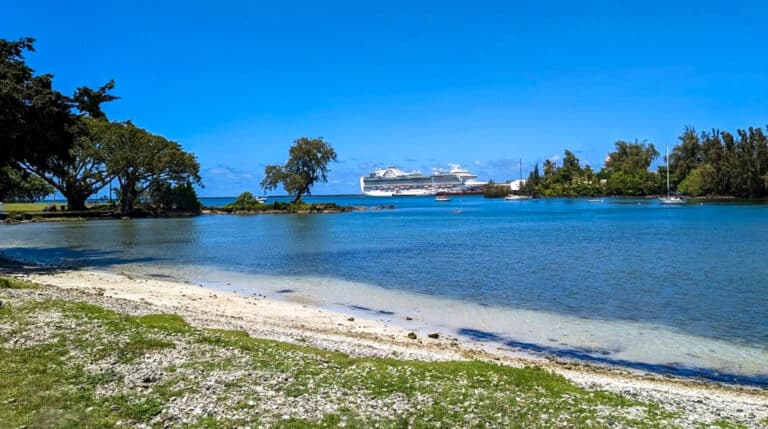
Can’t Miss Big Island Shore Excursions for Your Hawaii Cruise
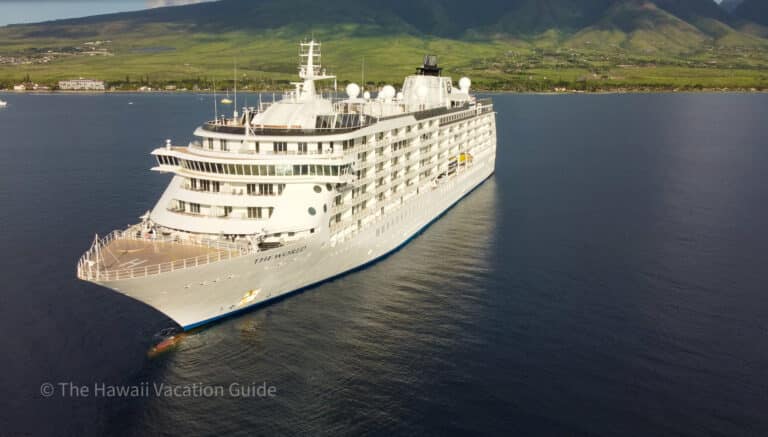
Hawaii Cruise Travel Guide
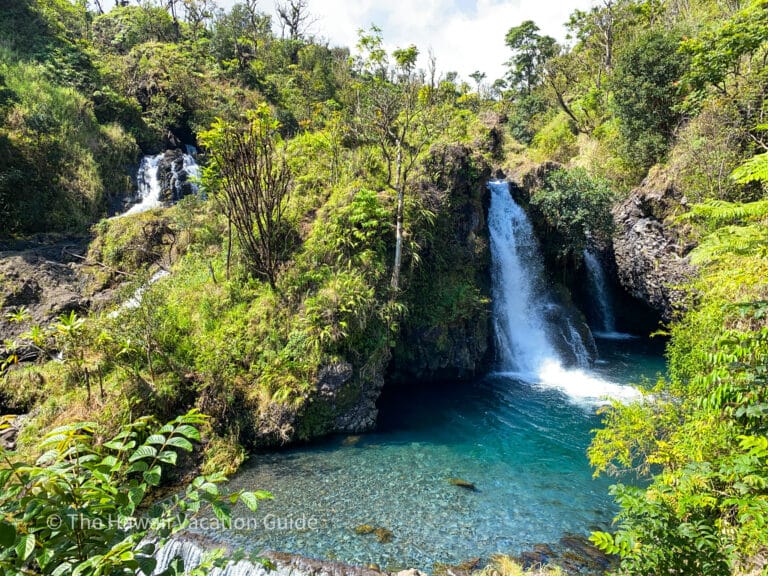
Road to Hana Guide: stops, tours, map, and tips! (2024)
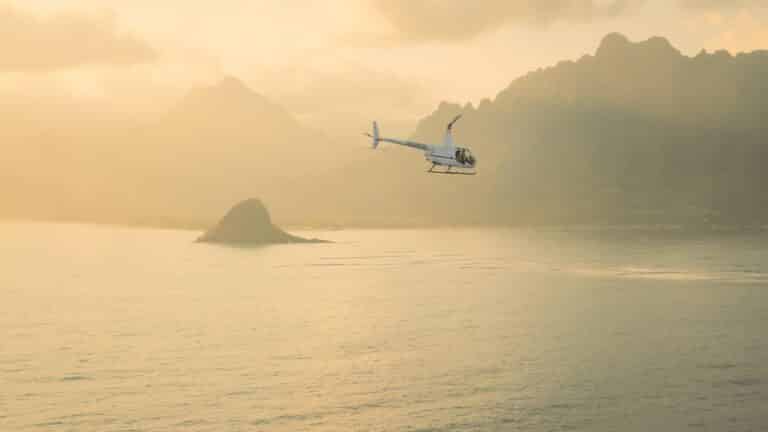
The 5 Best Hawaii Helicopter Tours Reviewed (by Island)
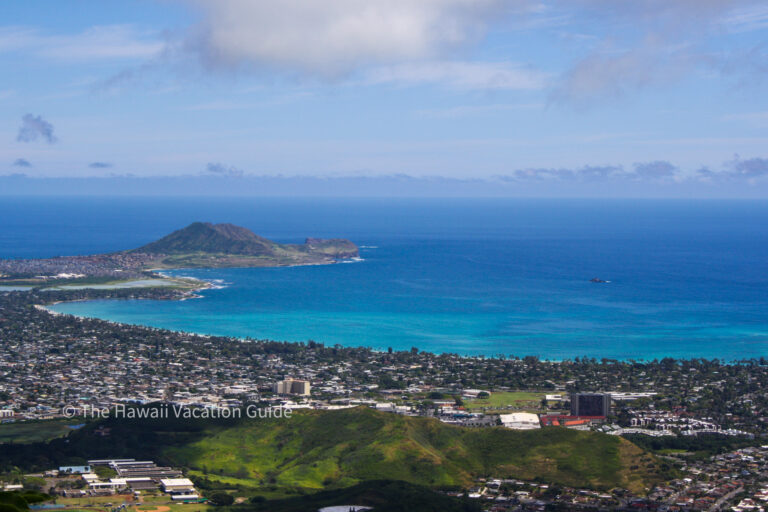
Hawaii in April: Everything to Know For Your Trip
This is the most comprehensive Hawaii vacation planning resource on the internet!
TOP RESOURCES
- Join Our Newsletter
- Hawaii Itineraries
- Tours & Activities
- Top Travel Gear
- Discount Car Rentals
ISLAND GUIDES
- Planning A Trip To Hawaii
- Oahu Island Guide
- Maui Island Guide
- Hawai’i (Big Island) Guide
- Kauai Island Guide
Your use of the information provided in our Content, Itineraries, Site, and Services is for your informational purposes only and is subject to our Privacy Policy and Terms of Service. Your use of the information described in, your participation in activities presented in, and/or your engagement of any Travel Service Providers presented in our Content, Itineraries, Site, and/or Services may carry the risk of illness, bodily injury, disability, death, or property damage. You voluntarily and freely assume all risks and dangers that may occur pursuant to your access, use, purchase, or participation in any information, activity, good, or service described in our Content, Itineraries, Site, and Services or provided by any Travel Service Providers.
Don’t start planning without our cheat sheets
You’ll get:
- 4 can’t-miss activities on each island,
- a map with the main sights in town,
- and famous local grindz (eats)!
Review Cart
No products in the cart.

Travel Blog | Travel Inspiration
Witness An Eruption: How To See The Volcano In Iceland

In March 2021, something special happened in Iceland. A volcano started erupting and it created a brand new – and spectacular! – attraction for people to visit. It is one of those rare chances to see a volcano erupting right in front of you! At the time of writing, the eruption at Fagradalsfjall is still going – so read on for information on how you can see the volcano erupting with your own eyes.
I’ve always been fascinated by volcanoes, ever since learning about them at school. I’ve visited volcanoes in New Zealand, Greece and the Canary Islands, and I’ve dreamed of seeing one erupt – but I knew it was a long shot, as the opportunities to do that safely are rare. Therefore, when news broke of the erupting volcano in Iceland, I was super keen to go there as soon as it was safe and possible for me to do so. I visited it twice in early August 2021 after driving the Ring Road , so in this post, I’ll share my experience of both visits.
The eruption is changing all the time… The info I’m sharing is correct at the time of publishing (August 2021). However, in case things change, I’ll share some links on where you can get the most recent information on the eruption.
Table of Contents
History of the eruption at Fagradalsfjall
Fagradalsfjall is a system of volcanoes in the Reykjanes peninsular, near the capital of Iceland, Reykjavik. It formed more than 11,000 years ago, but it had been dormant for an estimated 6,000 years until 2021. In fact, there hadn’t been an eruption in the whole of the Reykjanes peninsula for 800 years.
Fagradalsfjall sits at the divergent boundary between the Eurasian and North American tectonic plates, meaning it is one of the points where these two plates of the earth’s crust are pulling apart. And when tectonic plates pull apart, hot magma bursts out!
As with most volcanic eruptions, the Fagradalsfjall eruption was preceded by a series of earthquakes, which let scientists (and nearby residents!) know that something was moving below the surface. These earthquakes went on for more than a year, and then, on 19 March 2021, a fissure opened in the Geldingadalir valley and the eruption began.
Almost immediately, people hiked out to see the eruption and the lava flows – and I followed their pictures and stories keenly via social media. It has attracted huge numbers of people ever since.
The eruption has evolved over time: fissures turned into craters (at one time, there were seven craters spurting lava; when I saw it, there was one main crater, and shortly after that, it had evolved again into twin craters), and lava started to fill the Nátthagi valley. After a firey start, activity slowed and the volcano went through a period of stopping and starting in June & July 2021. And then it came back in full force in late August 2021. The lava flow has overrun several barriers built to contain it, and there are fears it will cross the main road on the south side of the peninsula soon.

Is it safe to visit the erupting volcano in Iceland?
Aren’t volcanoes, like, dangerous? Well, yes…
It is possible to visit the Fagradalsfjall eruption because it is less dangerous than many other kinds of eruptions. It isn’t the explosive kind of volcano that produces explosive volcanic bombs, huge ash clouds nor pyroclastic flows (like the kind that wiped out Pompeii in Italy). That’s why people have been able to get right up close to the lava flows. In fact, in the early days, people were cooking pizza and sausages on the hot rocks!
But there are dangers, of course: there’s a danger from gases emitted from the volcano and as such, there is continual monitoring of the site. You can check volcanoweather.is to see what the gas pollution is like before you visit.
There’s also a danger from walking on the lava. Even black, solid-looking lava could be a thin crust over 1,000°C molten lava below, so it’s a terrible idea to walk on the lava (although I did see some idiots doing that when I visited).

How to see the volcano erupting in Iceland
If you want to get up close and personal with a real live erupting volcano in Iceland, you have two options: 1) hike there by foot or 2) fly over it.
I tried both options, and I can say that the first option is definitely cheaper! But the second option gave better views. I’ll give you an overview of both options.
Seeing the eruption by foot
Unsurprisingly, most people choose the option to hike to the volcano in Iceland. It is way, way cheaper than taking a plane or a helicopter! And if you like hiking, then there’s an added bonus.
For official information on the safety of visiting the eruption on foot, check out these websites:
- VisitReykjanes.is gives an overview of visiting the site
- Volcanoweather.is where you can see weather and gas pollution forecasts
- Safetravel.is , for current safety information and where you can log your journey if you wish.
Where does the hike to the volcano start?
The hiking route is fairly close to the volcano along route 427, approx 10 min drive east of Grindavík.
There are three car parks, which you can find using the map on VisitReykjanes.is (unfortunately GoogleMaps isn’t updated with the volcano and car parks at the time of writing). It is free to do the hike to the volcano, but the car parks aren’t free. They cost 1000ISK for the day, which you can pay online by entering your car registration number and payment card details (there’s a sign with the info in the car park).
What is the hiking route like?
There are several hiking walks that have been established since the volcano started erupting. One of them (route A) stopped being viable when the lava flowed right across it (!), so when I visited, most people used route C instead.
A map of the routes is available on Safetravel.is .

Route C takes you first to the lava pool that has formed in the Nátthagi valley, and then you have the option to continue up a hillside to the right-hand side of it, to get a better view over the crater itself (which is not visible from the lava pool).
The stretch of route C to the Nátthagi valley was fairly easy – a few ups and downs, but mainly flat.
The path up the hillside to see the crater, however, was more challenging. The first incline is fairly steep and the ground is gravelly, so it is quite slippery. There’s also not a properly marked path, and people have clearly tried to take a number of routes up the hillside, turning it into a wide, gravelly slide.
Going up was hard work, and coming down was a bit treacherous, to be honest. I saw a few people fall over – and I was one of them (embarrassing, but I wasn’t hurt)! I also saw a man with a small child going down on his bottom, I guess to avoid the risk of falling over. And as I was leaving, I saw the search & rescue people on their way to help someone who was in difficulty on that slope. So it is not for the faint-hearted!

What views are possible from the ground?
In Nátthagi valley, the main sight to see is the pool of lava that has gathered there, and the flows of lava down the hillside from the area where the crater is. When I visited, these were all black, with no sign of red hot liquid lava – though the lava was still emitting smoke and gas, so I knew it was hot.

If you go up the hillside route, you will be able to see the main crater itself – and if you’re lucky, you will see it erupting red hot lava into the air!
On my visit by foot, however, it was quiet – some smoke, but no visible eruption. I waited around a while, in case it started erupting again, but I didn’t get lucky on that day.

Based on other people’s photographs after I visited, there has been a lot to see at the eruption recently: lava spurting from the craters and many flows of red hot lava along the ground, which people seem to be able to get quite close to. I would have loved to have been able to see these lava flows and to get some close up photographs of them, but it just didn’t work out that way for me.
But don’t feel too bad for me because I did get to see the volcano erupting the day after my hike!
Seeing the erupting volcano in Iceland from the air
What options are there to see the eruption by air.
The more expensive, but more spectacular, option for seeing the erupting volcano in Iceland is from the air. Both small plane and helicopter tours are available, departing from Reykjavik domestic airport. Based on my research, most last 40 – 50 minutes and cost up to 57,000ISK (approx £330).
I was very interested in a helicopter tour. However, in the end, I flew over the eruption on a privately organised photography flight over Iceland .

My flight with Volcano Pilot
If you’re a regular reader of this blog or follow me on Instagram, you’ll know I’m not a stranger to aerial sight-seeing. I’ve flown over spectacular landscapes in the USA, Peru and Namibia . So, when I planned a trip to Iceland for the second time, I was keen to see Iceland from the air . And with the eruption still going, I was even more determined to get that aerial view!
I arranged a photography flight with an Icelandic pilot and photographer, best known on Instagram, as Volcano Pilot . I arranged a bespoke route to cover all the things I was interested in seeing – including the eruption, of course.
The day we had planned to fly over Iceland was actually overcast with poor visibility, so we postponed it to the next day. 10 minutes after we took off from Reykjavik airport, we saw the smoke from the eruption. And ten minutes after that, we were circling the crater as it erupted!
It was really stunning – overwhelming, really… I couldn’t quite believe what my eyes were seeing. I’d been fascinated by volcanoes since I was a child at school, and here I was seeing one erupt right in front of me. It took my breath away.
As it was a photography flight, I was able to open the window to take photos – and I’ve never experienced anything as visceral and intense as leaning out of an open window at 70-80 knots (130-150 kph), pointing my camera down towards a huge crater spurting red hot lava!

As well as the phenomenal eruption, I also saw lots of other stunning things on this flight. I will write more on this topic asap, but in the meantime, check out my Instagram, where I’ve started sharing pictures: Instagram.com/marthaknight .
The risks with booking an aerial sight-seeing tour
Regardless of the flying option you choose, there are a couple of risks to consider when booking a flight.
One risk is that the weather will prevent you from taking off, as it did for me the day I had originally planned to fly. This is a big risk in Iceland, which can be cloudy, rainy or stormy, even in summer. I believe that most aerial tour providers will not charge you if the flight is cancelled due to bad weather, but I’d suggest you check the terms & conditions before you book.
Another risk, specific to visiting the eruption, is that it might not be erupting at all on the day you fly over it! Like the day I hiked to the eruption, some days there is no visible activity. Now, I would say it is still very cool to see the black lava, even if there is no molten lava flowing – but it is not quite the same as seeing an actual eruption. So, you should be aware this is a risk when you book.
How to keep track of activity at the volcano in Iceland
Whether you’re planning to hike to the eruption or to fly over it, you will probably be hoping and/or praying that it is actually erupting when you go there.
There’s no way to accurately predict what the volcano will be doing when you visit ahead of time, but there is a way you can keep an eye on what it is doing in real-time. There’s a volcano webcam continually filming the eruption, so you can see what is going on at any time of day or night.
In addition, you could check the pattern of tremors , which show a pattern of activity, followed by rest – I’m not sure how easy it is to use this to predict what will be happening when you visit, but you could try!
REMINDER: The eruption is continually changing
As I’ve already said, the eruption is changing every day, so do use the links I’ve included above to find the most up to date information. In particular, check Safetravel.is , which is updated every day or two.
If you go to Iceland, I really hope you manage to see the eruption. It was truly one of the most exciting travel experiences I’ve had!
And if you do go, make sure you check out my guides to travelling to Iceland during Covid , exploring Iceland on a budget and also the best things to see in South Iceland .
If you like this article, I'd be delighted if you shared it!
About The Author
Martha Knight
Related posts.

Iceland In Summer: Why It’s Amazing, What To Expect & Things To Do In 2024

16 Great Iceland Ring Road Hotels For 2024

Iceland Super Jeep Tour Review: Highlands & Landmannalaugar

Perfect Iceland Ring Road Itinerary – 7 Days Or 10 Days

Iceland From Above: 20 Photographs That Will Make You Take A Scenic Flight Over Iceland

Things I Wish I Knew Before My Iceland Camper Van Trip
Leave a comment cancel reply.
Your email address will not be published. Required fields are marked *
Save my name, email, and website in this browser for the next time I comment.
This site uses Akismet to reduce spam. Learn how your comment data is processed .
Privacy Overview
- Election 2024
- Entertainment
- Newsletters
- Photography
- Personal Finance
- AP Investigations
- AP Buyline Personal Finance
- Press Releases
- Israel-Hamas War
- Russia-Ukraine War
- Global elections
- Asia Pacific
- Latin America
- Middle East
- Election Results
- Delegate Tracker
- AP & Elections
- March Madness
- AP Top 25 Poll
- Movie reviews
- Book reviews
- Personal finance
- Financial Markets
- Business Highlights
- Financial wellness
- Artificial Intelligence
- Social Media
A volcano has erupted on an island in the Galápagos, Ecuador. Lava flow from the volcano reaches the ocean. While the eruption posed no risk to humans, the island is home to a number of species, including iguanas, penguins and flightless cormorants.
Lava flow from volcano on an uninhabited Galapagos island reaches ocean
- Copy Link copied
- International
7.4 magnitude quake hits Taiwan, strongest in 25 years
By Nectar Gan , Wayne Chang , Jerome Taylor, Antoinette Radford, Deva Lee and Maureen Chowdhury , CNN
Our live coverage of the Taiwan earthquake has moved here.
Search and rescue efforts continue after 7.4 magnitude earthquake rocks Taiwan. Here's the latest
From CNN staff

Rescuers are working to free dozens trapped after a 7.4 magnitude earthquake struck the east coast of Taiwan — causing landslides and collapsed structures.
At least nine people have died , more than 900 others are injured and over 100 buildings have been damaged.
The quake is the strongest to hit Taiwan in 25 years .
Here's what else we know:
- The quake: The earthquake hit at 7:58 a.m. local time, 18 kilometers (11 miles) south of the city of Hualien at a depth of 34.8 kilometers, according to the US Geological Survey.
- Aftershocks : The quake was followed by 29 aftershocks greater than a magnitude of 4.0 near the epicenter of the earthquake in east Taiwan so far, according to the United States Geological Survey (USGS). Tremors have been felt across the island, including in Taipei. Tremors as high as magnitude 7 are expected in the following days.
- Hualien County: The region where the quake struck, Hualien County, has a population of about 300,000, around 100,000 of whom live in the main city of Hualien. But many in the region live in remote coastal or mountain communities that can be hard to reach , so it might take time to understand the extent of Wednesday's quake.
- Trapped miners: Taiwan's national fire agency said that 71 people are trapped in two mines in Hualien.
- Power cuts : More than 91,000 households were without electricity, according to Taiwan's Central Emergency Command Center.
- Medical facilities: Hospitals across Taiwan’s capital , Taipei City, are operating normally despite being damaged by Wednesday’s earthquake, according to the Municipal Government.
- US monitoring: The Biden administration is monitoring the earthquake in Taiwan overnight and is prepared to offer assistance, a National Security Council spokesperson said Wednesday.
71 miners trapped in 2 mines in Taiwan after earthquake, national fire agency says
From CNN's Shawn Deng
Taiwan's national fire agency said that 71 people are trapped in two mines in Hualien after a powerful earthquake struck the island.
In the Heping mine, there are 64 people trapped, and seven more are trapped in the Zhonghe mine, the fire agency said in a news conference on Wednesday.
Video shows man swimming in a rooftop pool when massive earthquake hit
When a magnitude of 7.4 earthquake rocked Taiwan on Wednesday, it struck during the morning commute.
Video shows highway roads shaking and even a man being heavily swayed and rocked on a rooftop pool.
Watch the moment here:
Taiwanese semiconductor facilities will resume production overnight following earthquake
Taiwan Semiconductor Manufacturing Company Limited (TSMC), the chipmaking giant, said on Wednesday that its facilities which were impacted by the 7.4 magnitude earthquake are expected to resume production overnight.
TSMC reported that their overall tool recovery is at more than 70% within 10 hours of the earthquake striking the island. Safety systems are also operating normally, TSMC added.
The company noted that a small number of tools were damaged but that there was no damage to its extreme ultraviolet lithography (EUV) tools. Work at construction sites will resume after further inspections are complete, TSMC said.
Earlier, a TSMC spokesperson told CNN they had evacuated some manufacturing plants. All personnel are now safe, TSMC said in an update.
Biden administration monitoring Taiwan earthquake, White House says
From CNN's Sam Fossum
The Biden administration is monitoring the earthquake in Taiwan overnight and is prepared to offer assistance, a National Security Council spokesperson said Wednesday.
"We are monitoring reports of the earthquake impacting Taiwan and continue to monitor its potential impact on Japan. The United States stands ready to provide any necessary assistance. All those affected are in our prayers," a statement from National Security Council spokesperson Adrienne Watson said.
7 major earthquakes have hit Taiwan over the last 50 years
The 7.4 magnitude earthquake that killed at least nine people and injured hundreds Wednesday, is the strongest to hit Taiwan in 25 years .
Over the last 50 years, the island has experienced a total of seven major earthquakes, the last being a 7.1 magnitude quake in 2006 in Pingtung County in southern Taiwan.
The island sits on the Pacific Ring of Fire , which makes it prone to earthquakes.
See a full list of the earthquakes that have hit Taiwan:
29 aftershocks above 4.0 magnitude have occurred near epicenter since earthquake, US Geological Survey says
From CNN's Sara Tonks
There have been 29 aftershocks greater than a magnitude of 4.0 near the epicenter of the earthquake in east Taiwan so far, according to the United States Geological Survey (USGS).
Of these aftershocks:
- One was above 6.0
- 13 have been at or above 5.0
- 14 have been above 4.0.
Forecast during recovery efforts: Tonight's forecast in Hualien City, near the epicenter, calls for increasing cloud coverage. Thursday is looking at mostly cloudy skies with afternoon showers and rain Thursday night and Friday during the day.
Rainfall totals should be relatively light for Taiwan, with models calling for under 25 mm (less than 1 inch) by Friday evening local time.
Watch landslide engulf road after 7.4 magnitude earthquake hits Taiwan
A dashcam camera has caught the moment a large landslide came down a mountain in Taiwan, triggered by a 7.4 magnitude earthquake on Wednesday morning.
The quake is the strongest to have rattled the island in 25 years, killing at least nine people and leaving more than 150 trapped.
Please enable JavaScript for a better experience.

IMAGES
VIDEO
COMMENTS
Italy. Italy is home to mainland Europe's only active volcanoes: Vesuvius, Stromboli and Etna. Mount Etna is the highest active volcano in Europe, measuring over 10,000 feet tall. It contains more than 400 craters and is in a constant state of activity, which means you're likely to see it spew ash and lava.
Arenal, Costa Rica. The centerpiece of 30,000-acre Arenal Volcano National Park, Costa Rica's most active volcano is also one of the country's top tourist attractions. Lava has flowed since ...
Mount Fuji, Japan. Few summits on Earth embody the soul of a place quite like Japan 's Mount Fuji. Dormant since last erupting in 1707, Mount Fuji is a UNESCO World Heritage site —noted by ...
Zhizhao Wu/Getty Images. At the center of Kyushu, Japan's third-largest island, lies Mount Aso. Its caldera is one of the largest in the world, with a 12-mile diameter and a 75-mile circumference ...
Hawaii Volcanoes National Park. In Hawaii, one of the best family vacation spots in the U.S., volcanoes symbolize creation and rebirth rather than destruction. The 505-square-mile Hawaii Volcanoes ...
6 Ecuador: Cotopaxi. Cotopaxi is one of the highest volcanoes in the world and has erupted over 50 times since 1738, with the most recent activity beginning in August of 2015 and lasting for six months. Popular as a day-trip outside of Quito, visitors typically hike to Refuge Jose Ribas and then continue on to Cotopaxi glacier.
Kīlauea is the daddy of accessible active volcanoes and receives nearly three million visitors a year. At 1,247m it's not even the tallest volcano on Hawaii (it's dwarfed by the 4,169m Mauna ...
10. Villarrica, Chile. At 9,380-foot, Villarrica is especially scenic because it rises majestically above the eponymous lake, but residents and tourists were treated to an even more dazzling and frightening spectacle when the volcano erupted in 2015, throwing up a brilliant column of lava that was visible for miles.
Tourists can visit the soaring 7,641-foot volcano anytime by passing through an ash desert. It's worth getting up early to view the sun rise over this otherworldly landscape from the rim of the ...
The rise of 'lava chasers'. The day after the Island of Hawaii' s Mount Kilauea erupted on December 20, 2020, Hawaii Volcanoes National Park saw a sharp spike in visitors. Many of the 8,000 ...
Have a Plan B before you visit. If there's an eruption, expect increased waits and congestion; consider visiting before sunrise or after sunset for a smoother experience. Visit the Kahuku Unit. Kahuku is never crowded, and open Thursday through Sunday, 8 a.m. to 4 p.m. Kahuku is located on Highway 11 near mile marker 70.5 in Ka'ū ...
No visit to the Big Island of Hawaii is complete without one day in Volcanoes National Park. The park spans about 523 square miles and is home to two of the world's most active volcanoes. Kilauea is one of the most active volcanoes in the world while Mauna Loa is the world's largest shield volcano. During your visit to Volcanoes National ...
Hawaii Volcanoes National Park is home to two volcanoes, Kilauea and Mauna Loa, and is the home of the mythical volcano goddess Pele. To the delight of visitors, Kilauea has been erupting continuously since 1983, adding to the island's size. Its sister volcano, Mauna Loa, which last erupted in 1984, is Earth's most massive mountain ...
Volcano Unveiled. One of the best volcano tours on the Big Island is run by Hawaii Forest & Trail, which is certified by the Hawaii Ecotourism Association. Volcano Unveiled is a 12-hour tour that includes a 2-3 mile hike to see Kilauea volcano. You'll also head to Kauhi Cave, a private lava tube and cavern that's only available through this ...
3 White Island, New Zealand. White Island is one of the most active volcanoes in New Zealand and most of the volcano is underwater, but around 70% of it can be seen. Visitors have to wear a mask when visiting here because of the acidic white steam and gas it produces. When on the volcano, tourists can expect to see mud pits and volcanic streams.
Volcanoes in Iceland. Straddling the Mid-Atlantic Ridge, Iceland is a hotspot for volcanic activity. In fact, volcanoes are such a big part of Iceland's unique appeal that we operate a Volcano Hotline, notifying you of potential trips to visit live eruptions at short notice such as the 'tourist-friendly' eruption in July 2023 on the Reykjanes Peninsula.
Hawaii Volcanoes National Park is a natural marvel, boasting two of the planet's most active volcanoes - Kilauea and Mauna Loa. The park offers visitors an unrivaled opportunity to observe geological wonders in real-time. Situated on Hawaii's Big Island, this expansive national treasure spans over 333,000 acres from sea level to Mauna Loa's ...
Find out about volcano tourism and how you can visit these natural wonders in this complete guide to volcanoes in Iceland. The Land of Fire and Ice, Iceland, is a natural wonderland where the freezing forces of glaciers and arctic weather are constantly battling with the Earth's fierce heat. The result is a world of dramatic contrasts across a ...
The Big Island's volcanoes include Mauna Kea, Mauna Loa, Hualalai, and Loihi. The massive mountains that mark the Big Island are still active volcanoes, though the activity is fairly rare. Mauna Loa last erupted in 1984, and the eruption lasted for 22 days.
If you're planning a trip to Costa Rica and need to see a volcano, don't miss our list of the top Costa Rica volcanoes to visit for the ultimate thrill. Arenal Volcano. Without a doubt, however, the most popular of Costa Rica's volcanic giants is Arenal. Located in the northern part of the country, it towers over the surrounding fertile ...
Maui volcanoes are safe to visit as the chance of an eruption is very low per the US Geological Survey. Haleakala is considered an active volcano by the US Geological Survey (USGS). USGS Volcano Warning Scheme for the United States, the Volcano Alert Level for Haleakala is "normal". A Normal status means the volcano's activity is in a non ...
The erupting volcano in Iceland How to see the volcano erupting in Iceland. If you want to get up close and personal with a real live erupting volcano in Iceland, you have two options: 1) hike there by foot or 2) fly over it. I tried both options, and I can say that the first option is definitely cheaper! But the second option gave better views.
The volcano, on the Caribbean island of Martinique, also looks deceptively peaceful. An eruption in 1902 destroyed the port of Saint-Pierre, killing an estimated 30,000 people - 15% of the ...
4. The Lava Centre in Hvolsvöllur. If you came to Iceland to experience the Land of Fire and Ice, the Lava Centre museum in South Iceland is worth a visit. This innovative museum opened in 2017 not far from Mount Hekla, an active volcano that was considered to be the gateway to hell in the Middle Ages.
The volcano has emitted hundreds, perhaps thousands, of the spectacular rings since then, added Mr Behncke, who can see the volcano from his house in Tremestieri Etneo, near Catania.
A volcano has erupted on an island in the Galápagos, Ecuador. Lava flow from the volcano reaches the ocean. While the eruption posed no risk to humans, the island is home to a number of species, including iguanas, penguins and flightless cormorants. Published 7:49 PM PDT, April 7, 2024. The Associated Press is an independent global news ...
Monday, April 8, 2024 4:54PM. A volcano in Sicily, Italy, Mt. Etna, puffed smoke rings into the sky this weekend, after a vent opened on the southeastern crater last week. CATANIA, Italy -- Smoke ...
April 5, 2024, 4:37 PM PDT. By Evan Bush. The fault that ruptured beneath New Jersey on Friday morning was likely an ancient, sleeping seam in the Earth, awakened by geologic forces in a region ...
The New York Times. A light, 4.8-magnitude earthquake struck in New Jersey on Friday, according to the United States Geological Survey. The quake was felt across the New York City metropolitan ...
See a full list of the earthquakes that have hit Taiwan: 10:07 a.m. ET, April 3, 2024 29 aftershocks above 4.0 magnitude have occurred near epicenter since earthquake, US Geological Survey says ...